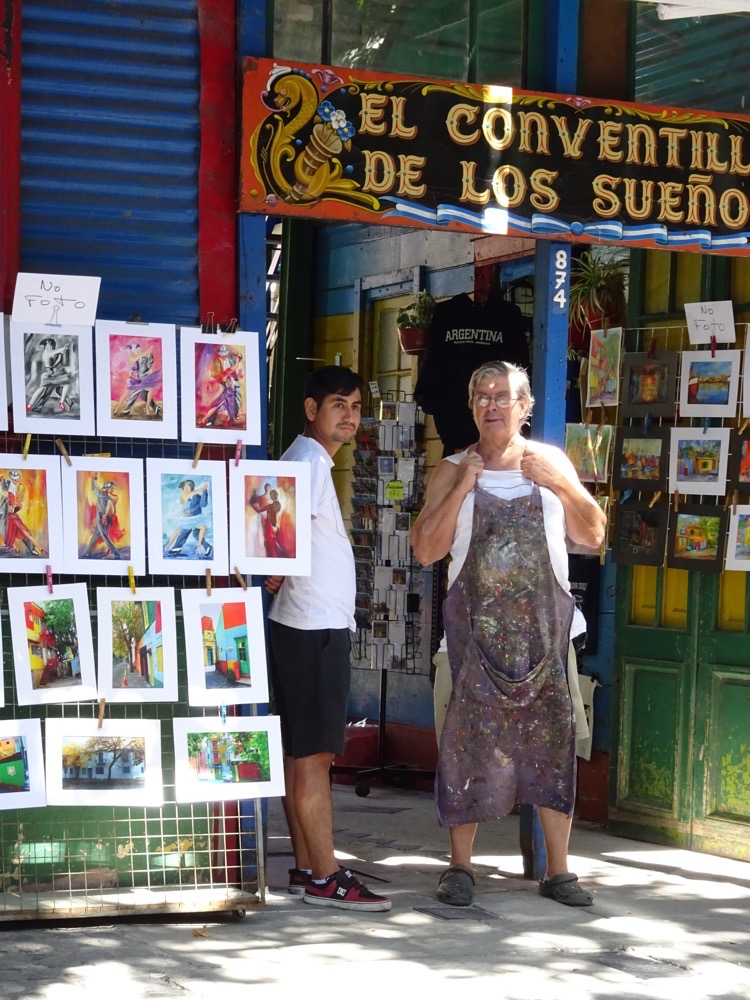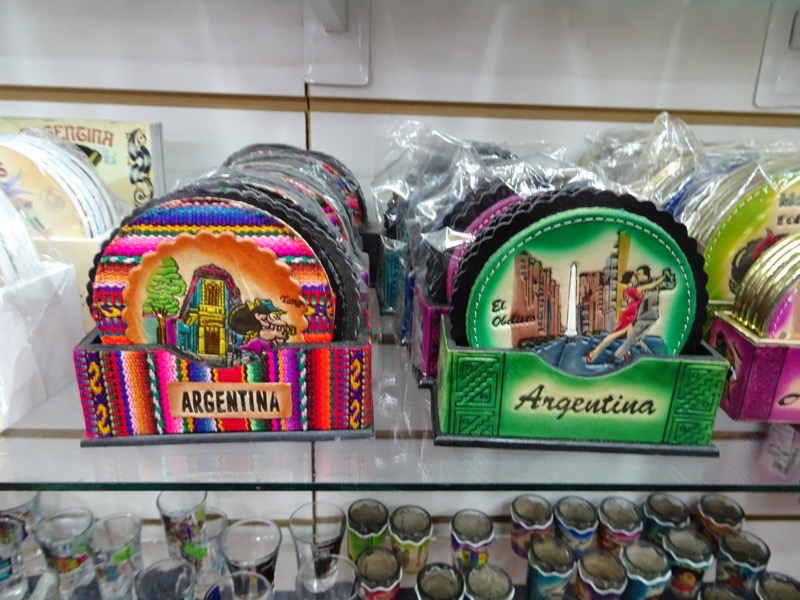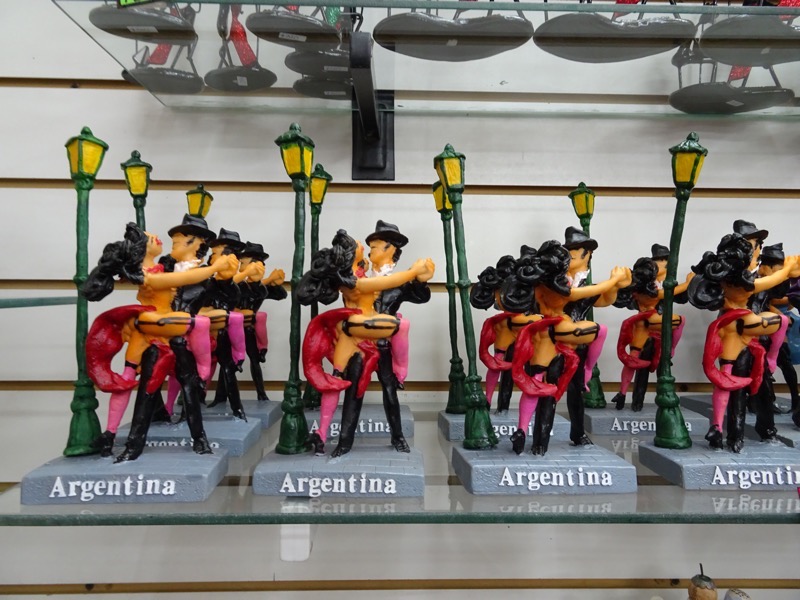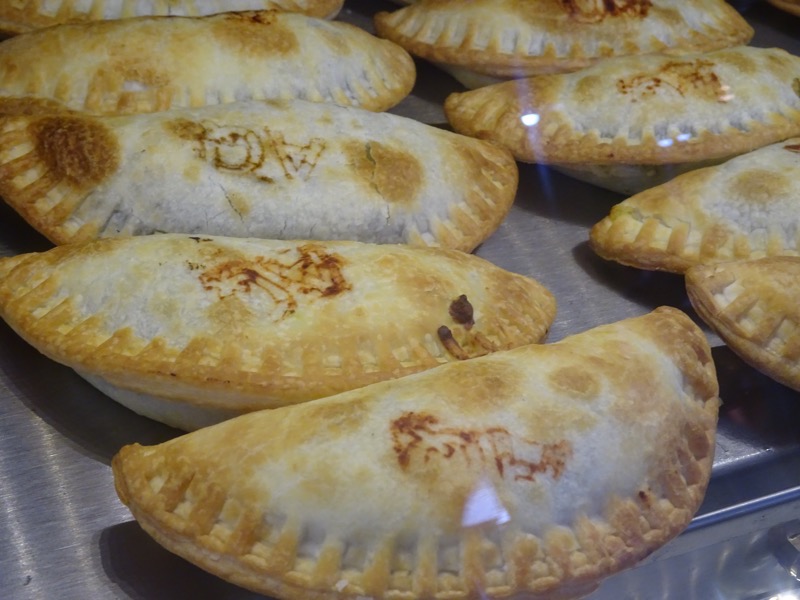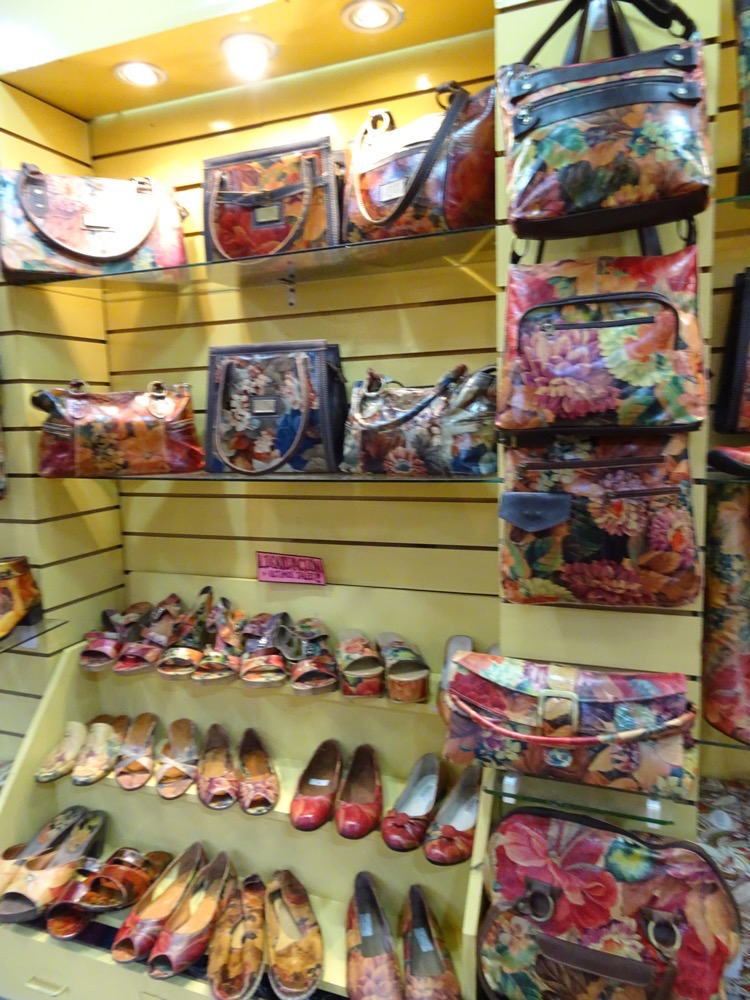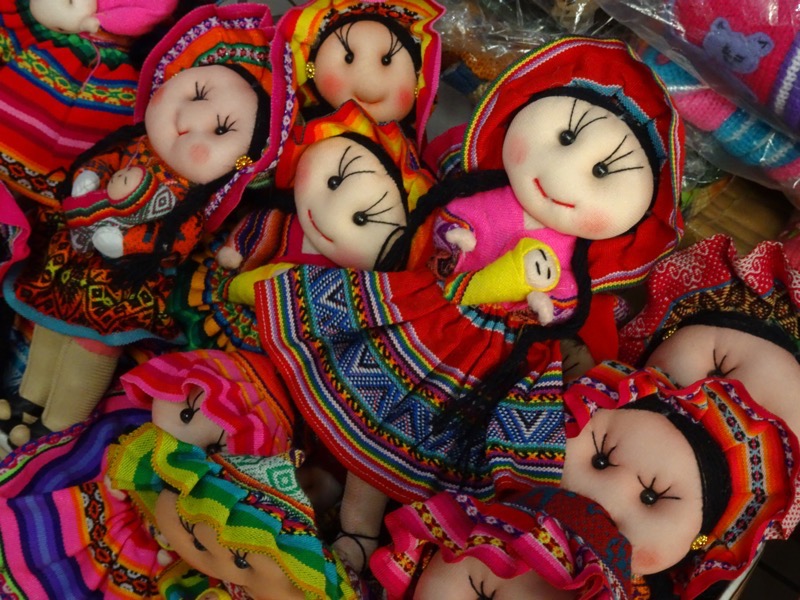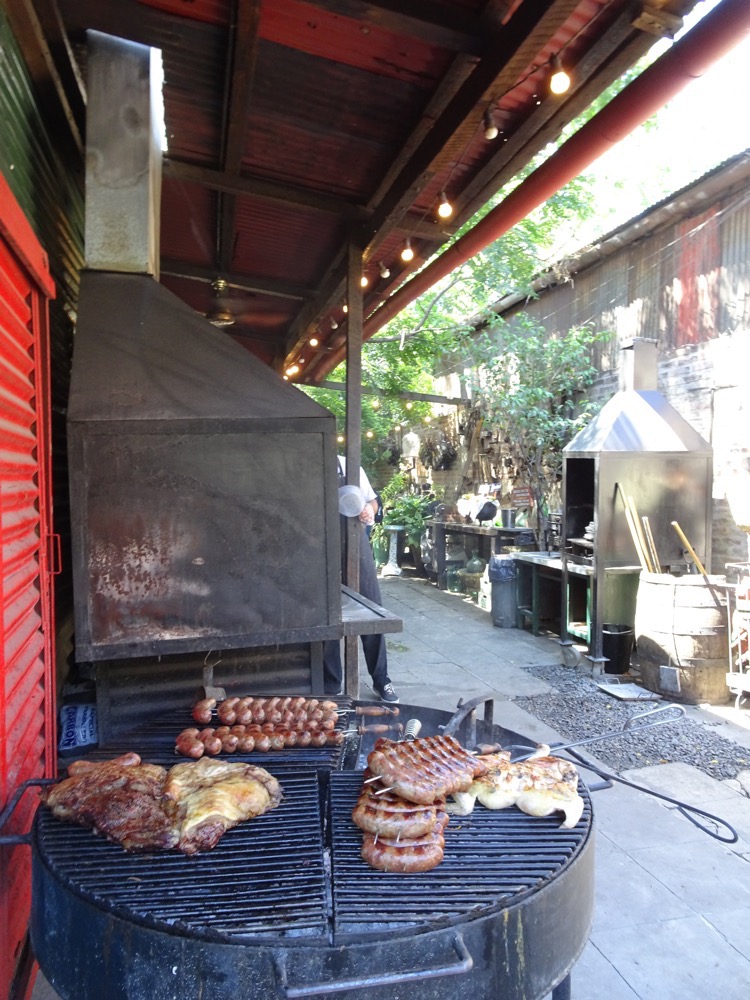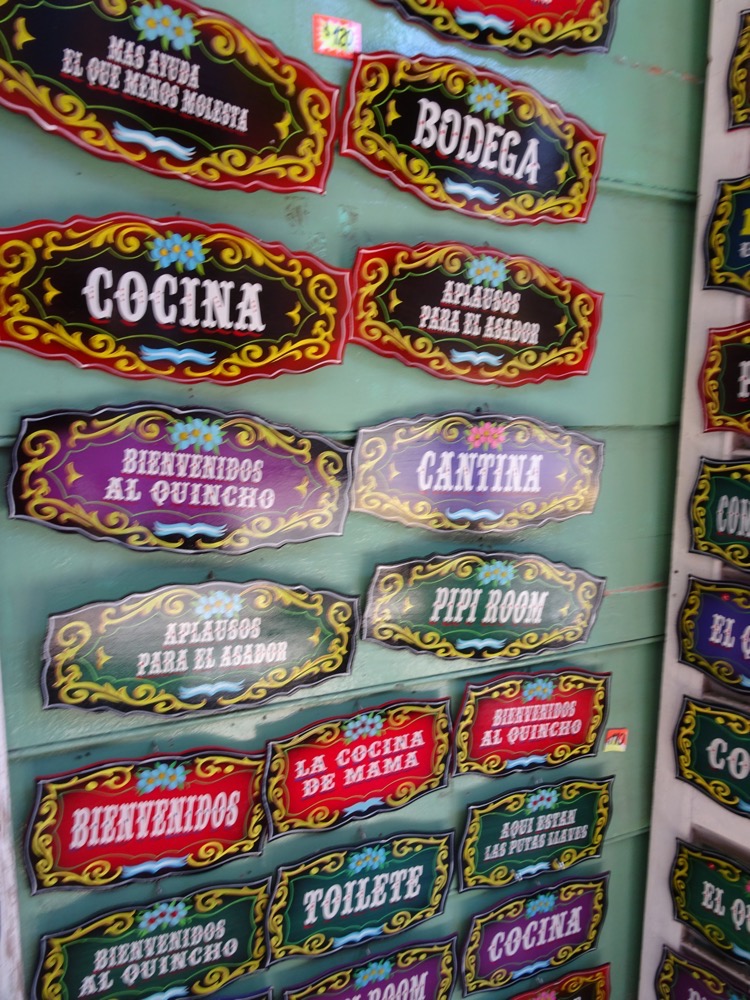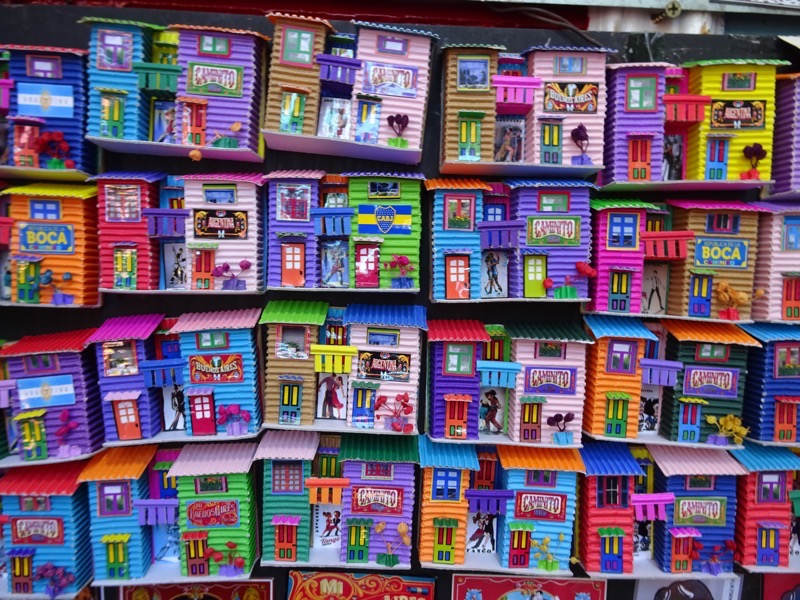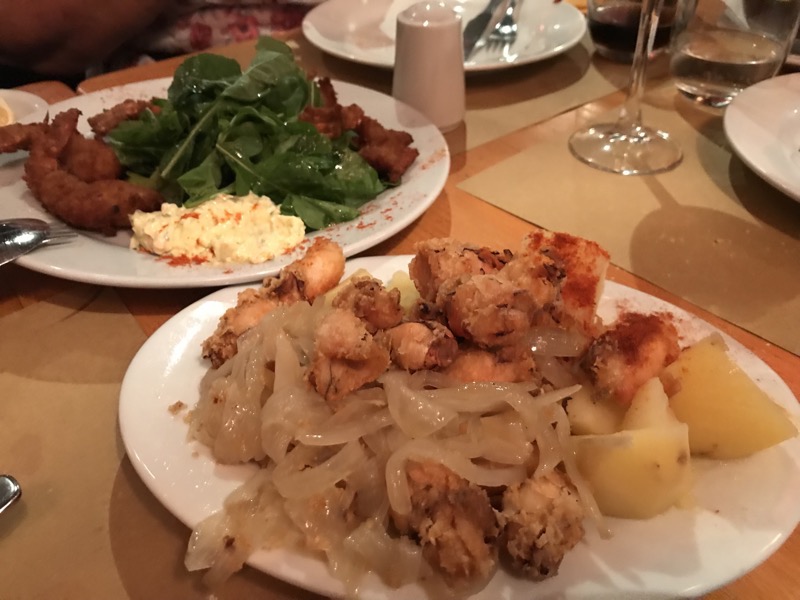When I was researching trips to Antarctica, I found some of the more nitty gritty practical stuff that I really I wanted to know, seemed conspicuously absent from the travel brochures. If I wanted to know any of the little things, I had to direct my questions to the Peregrine ‘polar experts’ and I didn’t want to be continuously bothering them with too many queries about what they might perceive are insignificant details. So I thought I would compile some info here, so I could remember it and also in case anyone searching is looking for a ‘Quark Antarctica Frequently Asked Questions’ type thing. We travelled on the Ocean Diamond in March of 2018, obviously different ships will have different amenities – these notes are based on our experiences on that ship. If you’d like to read the ‘day to day’ activities of our trip, you can click HERE and find my travel diary of how our journey South of the Antarctic Circle went, and then just click ‘next’ to see each day.
Cabin
We didn’t get a cabin allocation until about two weeks before we were due to leave. This is an unusual experience for me as when we cruise, we usually choose our own cabin – but since we booked through a travel agent, we didn’t seem to have that option. When we finally got out ‘boarding passes’ there was a cabin number written on the travel documents, though it was in tiny print and you had to hunt for it.
Our cabin was really well appointed and quite comfortable for two. We had a larger than usual room with plenty of space to store our things. The beds are neither too soft nor too hard, so I’m a happy camper who prefers a firm mattress – of course, the rocking of the ship really helps you sleep, so the mattress is not as important as onshore stays.
There is a TV in the room which runs some documentary films and seems to have a movie channel, playing an excellent selection of favourite films, but we have been on board a week and I can’t find anything resembling a TV guide, so it’s a bit of a crap shoot if you want to plan an hour or so to relax and watch a movie. We were able to copy a movie off my laptop onto a USB and watch it through the DVD player, so that was useful.
The only issue we seem to have had with our accommodations is the air conditioning – when we got here the room was a stuffy 24C and we had to call in the AC guy to come and turn it down for us. As we were getting ready for bed, we told him we wanted it around 19C (which is a good sleeping temperature) assuming we would be able to adjust it using the thermostat for a warmer temperature in the daytime. But he seems to have set it at around 17C in here, and the thermostat isn’t working, so if we want to be warmer during the day we need to call him back every morning, and again to cool it down every night.
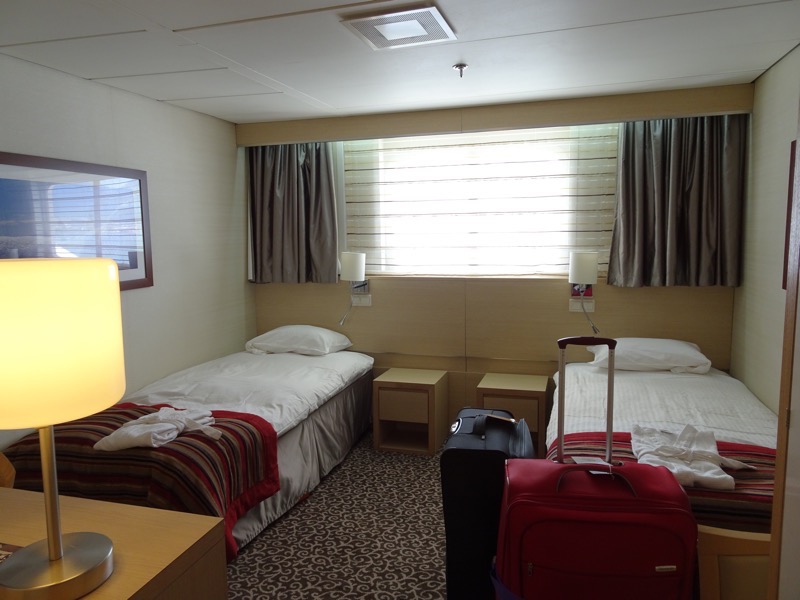
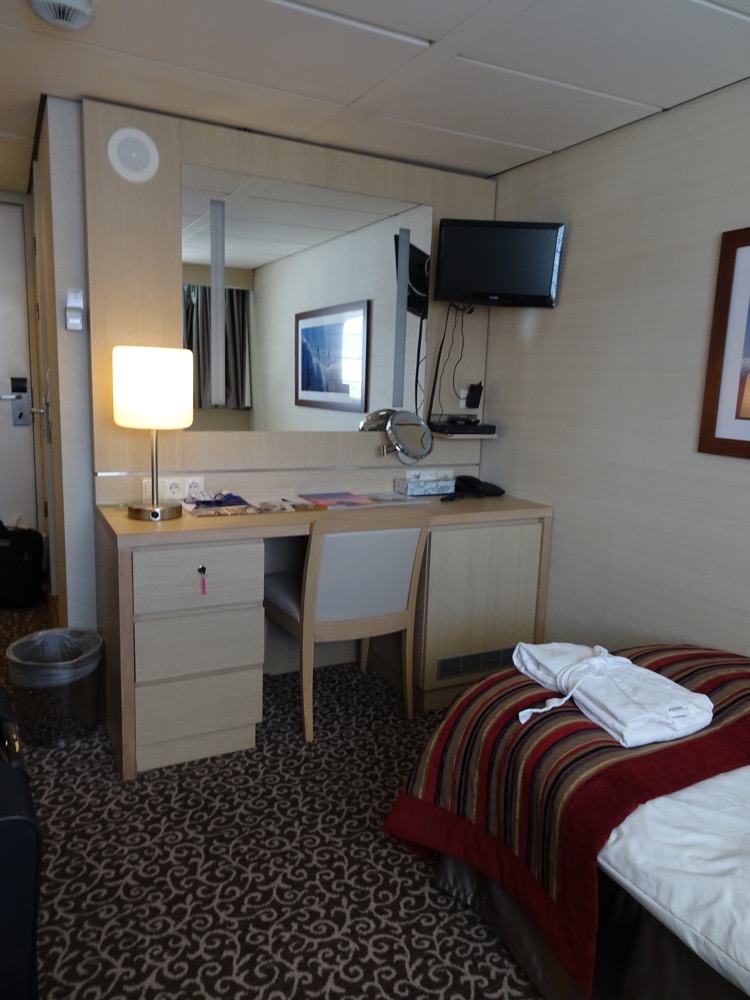
Quark Clothing – Parka and Boots
One of the first things the staff did for us was to outfit us with our Expedition parkas, which have been specially designed by Quark for Quark passengers for Antarctic and Arctic Expeditions. They are big and bulky, with loads of pockets to hold your excess things, but they are super warm and I have found myself wearingly only a thin merino thermal layer, a long-sleeved t-shirt layer and the parka. No need for a jumper or polar fleece layer at all. Aside from being a butt-ugly bright banana yellow, they are an excellent item of clothing and have obviously evolved from years of feedback and from passengers being unprepared for the conditions here.
Over the top of all this, you will find yourself wearing your PFD (personal floatation device) every day when you are off the ship. You must wear it on the zodiacs and you will find yourself wearing it while walking around on land because wearing it is easier than carrying it. It’s a fairly slim design as life jackets go, but it’s fairly heavy and rather bulky on the back of your neck and chest. You end up walking everywhere feeling like the Michelin Man.
The Muck Boots that are lent to passengers to use while they are on their expedition are also another very sturdy and solid piece of equipment that is absolutely essential. There is a major downside to the boots being provided on the ship though… they’re men’s boots. All of them. So ladies are being given whatever size is appropriate for their feet. In my case, I wear a ladies size AU 6 (or EU36-37) and in a men’s boot – say in Dr Marten boots – I wear a men’s size 4. Only problem is, women’s legs tend to be far more shapely than shoes made for men’s legs – men’s size 4 boot is effectively made for a ten year old boy with chicken legs. So I had to go a size up and wear a size 5, and even that was far too tight in the calves that I had to fold the boots down, rendering them less useful as waterproof boots when getting in and out of the zodiacs at landing sites. After the first day though, it rapidly became apparent that the size 5 boots, even with the height of them folded down on themselves was no good – as it was still so tight around my upper ankle that it was cutting off the circulation in my foot and starting to bruise my shin! So I had to go back and get a men’s size 6 boot. I am still wearing them folded down and even with two pairs of sole inserts in each boot, I feel like I am clambouring about in clown shoes. My feet are slipping about all over the place inside my boots and I have been ever so slighting twisting my knees every day – not good. I’ve also had to be extra careful on the rocks and ice when ashore to make sure I don’t lose my footing in these boots that are two sizes too big – they’re quite the trip hazard. So if you know you have a tiny foot and muscular calves… I’d seriously consider trying to bring your own good quality insulated waterproof boots from home. They might be expensive and may never get used much again in the future, but the stability and sureness underfoot would be worth it.
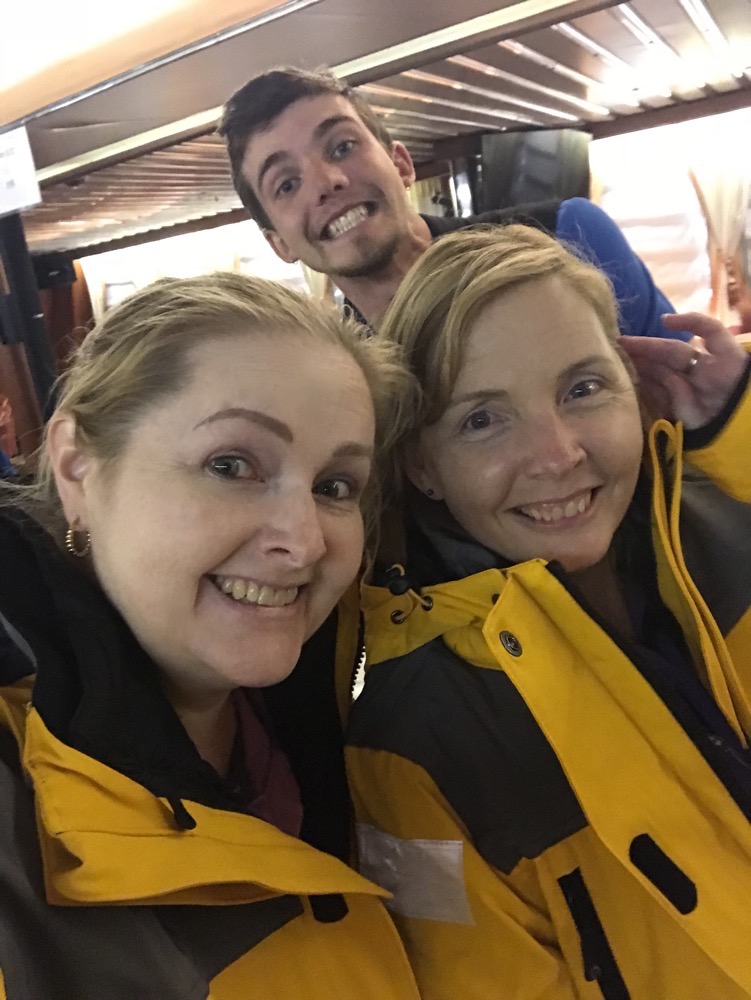
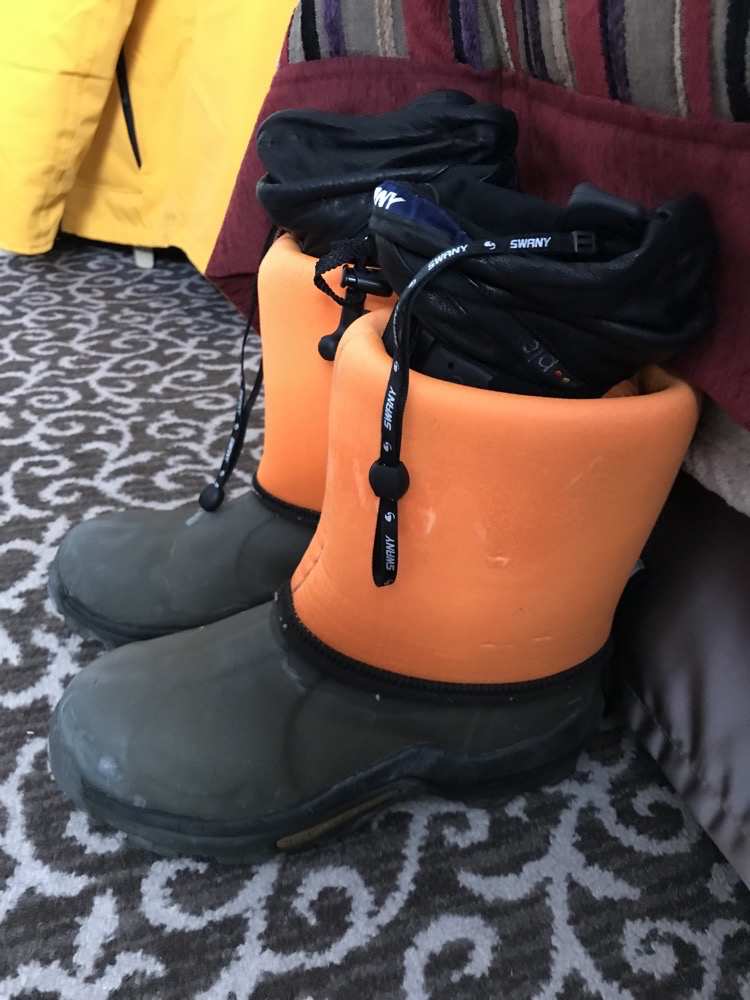
Food
The food has been amazing on board, with a wonderful variety and plenty of it!
An enormous buffet breakfast is served at approximately 0730-0830 in the main dining room and there are plenty of options from various breads, cereals, cold meats, smoked salmon, cheeses, eggs, bacon, sausages, hash browns, baked beans, a couple of omelette stations, tea, coffee, juices, yoghurts – the whole shebang.
Lunch is again served buffet style between 1230 and 1330 (depending on how morning land and zodiac excursions have gone). There is usually a pasta or stir-fry stations, plenty of salads and cold meats, and hot dishes that vary every day which usually include some grilled fish, and some sort of casserole option with vegetables, rice or pasta to compliment. Soups are also available at lunch, with breads, and desserts also on offer. There is a daily a la carte sandwich, hamburgers and other things available on request and the dining team do their best to help provide options for people with dietary requirements. There is also a new refreshing non-alcoholic punch to try every day.
Dinner is served in the main dining room starting from 1900-1930 after the evening debrief/recap. Dinner is a four course table service menu with appetizers and salads, a soup course (usually a choice of two soups), a main meal course (usually a fish, beef/pork option and a chicken option) followed by a desserts (usually a specialty dessert, an ice cream sundae type option, a cheese platter or a selection of fruits). Dinner is served with complimentary red or white wine – often sauvignon blanc or cabernet blends from Argentina to Italy to New Zealand. For those that don’t favour wine, beer and soft drinks and juices are also available. We are used to a cup of tea or coffee being served at the end of a meal, but for that, we needed to go to the Club to make our own.
Seating in the dining room is strictly first-come first-served, there is no reserved seating and no allocated table numbers. One of the best aspects of dining on the ship is that members of the Expedition Team will come and join a different table for dinner each night – a more interesting and well-travelled and sociable bunch you will never find. So our dinner conversations have all been very lively and inspiring.
Internet
I could find ZERO information on Internet availability or cost prior to actually getting on the ship – even the Expedition staff who briefed us in Ushuaia were cagey about the accessibility once onboard, which is a bit shit or I would have told my family not to expect to hear from me at all for the next 14 days.
Further to that, there is considerable pressure from the Expedition Team who will encourage you to ‘disconnect’ and discover this amazing place as the first explorers would have – without the ability to connect back to The Real World™. Additionally, your fellow passengers will also loudly and proudly exclaim on the first day or so that they are going to completely disconnect for the duration as well, so there is considerable peer pressure to leave the Internet alone too. Given that the Internet on the ship completely sucks balls, in both speed and expense, as well as actual availability – there doesn’t appear to be many people actually using it.
There are three packages available:
- USD$35 Webmail Package : they will set you up a text only email address for use while you are on the ship.
- USD$60 Package: Internet access of 60MB of data. Untimed but limited by data usage.
- USD$100 Package: Internet access of 200MB of data. Untimed but limited by data usage.
None of these packages are suitable for blogging or sending lots of pictures back home but still, they might be all fine and dandy if you were 100% confident that you have NOTHING running in the background of your smartphone or iPad or laptop that was going to be refreshing or downloading or synching stuff while you were carefully trying not to use your data. It would be all too easy to jump online to chat a bit via WhatsAp or Messenger and then check your limit and find out it’s been all chewed up by something you didn’t know was running. I have decided not to buy an internet package but I have a feeling I am going to really regret that by the time we are on the Drake Passage on the homeward stretch.
Photo Journal
The on-board photographer who is here to give you hints and tips on how to best capture your Antarctic experience also sets up a couple of laptops on the ship and encourages passengers to share photographs. These photographs will be available to all of us at the end of the trip.
What often seems to happen with wildlife photography and when we are out in the zodiacs in particular, is that half the people on the small boats will have a great view of a particularly exciting wildlife moment and the other half of us will end up with a row of yellow jackets, or someone else’s camera protruding into our shot, or just a blurry mess as you spin around onto your knees to allow others to see. So we all get to view these amazing things, but only about half of us have the good fortune to capture those special moments of a whale breaching or of a leopard seal hurling it’s catch – so the photo journal is a really good idea and many people will participate in sharing their images. So long as you are not a professional photographer planning on making a commercial enterprise out of your photographs, I would strongly encourage people to share their best shots so we can all come away with beautiful images of our shared experiences regardless of where your seat is on the zodiac that day.
The images get compiled and are made available to passengers via a Quark website where you can go to download them once you are home. Worth noting is that the downloadable images will be in a slightly lower resolution than that which was provided by your fellow passengers. Also worth noting – once you put your images into the Photo Journal you are basically giving them to Quark; to potentially use in their advertising brochures and online web presence. While the Photo Journal is a great resource for the passengers and is a fantastic idea for sharing your best pictures with your fellow travellers, Quark are very happily collecting amazing images for free – which doesn’t bother me, but maybe a concern for some.
Laundry
Halfway through our journey, a ‘special’ for an entire bag of laundry for USD$30 was offered to us, which we took full advantage of. The laundry bag is very generously sized if you wanted to wash jumpers or polar fleece items. The laundry list was amusing – there are pantyhose and stockings listed on the items that you may want laundered, and we couldn’t help but wonder who on earth is coming down here with pantyhose and ladies shoes!
Had we known this laundry offer would come around about mid-trip, we could probably have gotten away with a one week pack instead of packing enough clothing for two weeks – having said that nearly everyone here is wearing the same things to shore every day, and the same things to dinner every night, so it is not like a traditional cruise in that respect! Walking pants or even track pants in the dining room are passable attire.
Giftshop
There is a gift shop onboard that carries a limited range of Antarctic souvenirs, but they do have a good range of warm clothing if you find you don’t have enough layers or need a second beanie or something. I have noticed though that most of the items seem to circulate through a discount table or rack at some point – this could be because we are at the end of the season and they are trying to get rid of stock, or it could just be the way the gift shop always runs… but I’d avoid paying full price on any of the clothing items for the first few days and wait to see if any discount tables appear. The store manager also appears to have considerable discretion to discount items too.
As it happens, there is often an opportunity to send postcards from one from one of the stations along the Peninsula here. Now I haven’t sent postcards home for years, but we are in Antarctica and I’m kinda curious how long it will take, so why not? We were given about 30 minutes warning before going ashore that we would be able to send postcards at that day’s landing, so as you can imagine everyone was scrambling for the gift shop to pick up some cards – which unfortunately had heaps of cards with images of South Georgia and the Falklands and the Southern Oceans, but not many that actually had images of Antarctica or that said, ‘Antarctica’. So I’d advise getting i early and buying some postcards that say ‘Antarctica’ if you are planning on trying to send some home for fun – or better yet, pick some up in Ushuaia on spec.
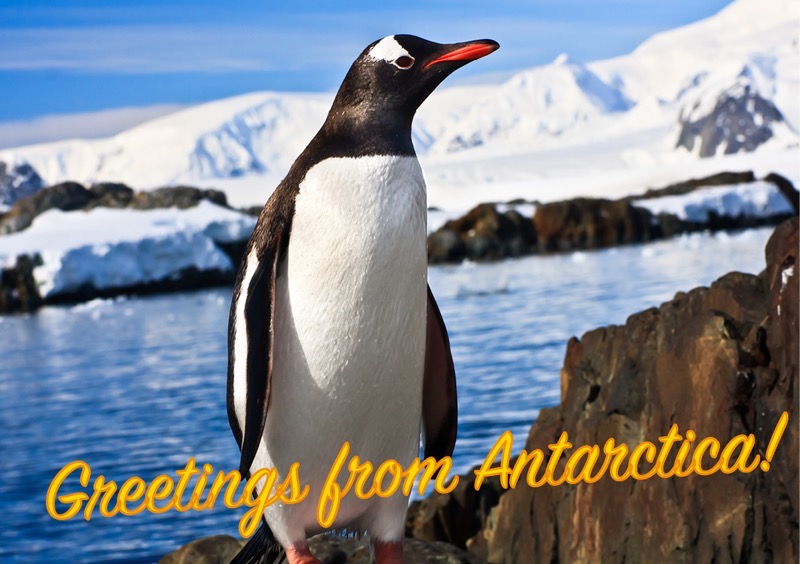
Things I’m really glad I brought with me…
Merino neck warmer – I bought a cosy neck warmer at a ski shop in Whistler for about $30. So far it has proved a great investment on the zodiac cruising as you can pull it up over your face and to cover your ears when it’s cold, and it’s a lot easier to wrestle with than a scarf.
Toe warmers – we happened to pick up bulk bags of toe warmers when we were in Canada in January, and they were $9.99 for a pack of 16 pairs of toe warmers… here on board and in Ushuaia (and indeed back home in Brisbane) they are selling for about $3.00 a pair. So bulk toe warmers from Amazon or something is not a bad plan, they’re good and they really help when you are sitting still in the zodiacs for what can seem like quite a long time if you are cold. They are also useful to put in your mittens or pockets – or even attach them to electronic devices if the batteries don’t like extreme cold.
Laptop – every day we are out on the zodiacs and every day I’ve been worried about dropping my camera overboard. I have it tied to my wrist with a lanyard, so it’s unlikely, but I’m sure it happens to someone. Anyway, I’m glad I brought my laptop as I’ve been backing up my photos after every excursion – so if the camera goes over, I’ll only lose a handful of pictures, not the lot. Also, I’ve been able to write this blog even though I’m offline… which is good or I’d be so far behind I’d never catch up.
Teabags – weird as it sounds, English Breakfast tea is often thin on the ground. It’s popular as all giddy-up so it gets used up quickly and on ships sometimes seems to run out. The weird orange, chamomile, or apple cinnamon flavoured teas will still be around for the whole trip but good old English Breakfast tea bags will disappear. So I always pack a little bag – back up tea bags, raw sugar, hot chocolate sachets, chai lattes and even mushroom cup-a-soups. They don’t weigh much but can make life more pleasant – which probably says a lot about the type of traveller I am 😉
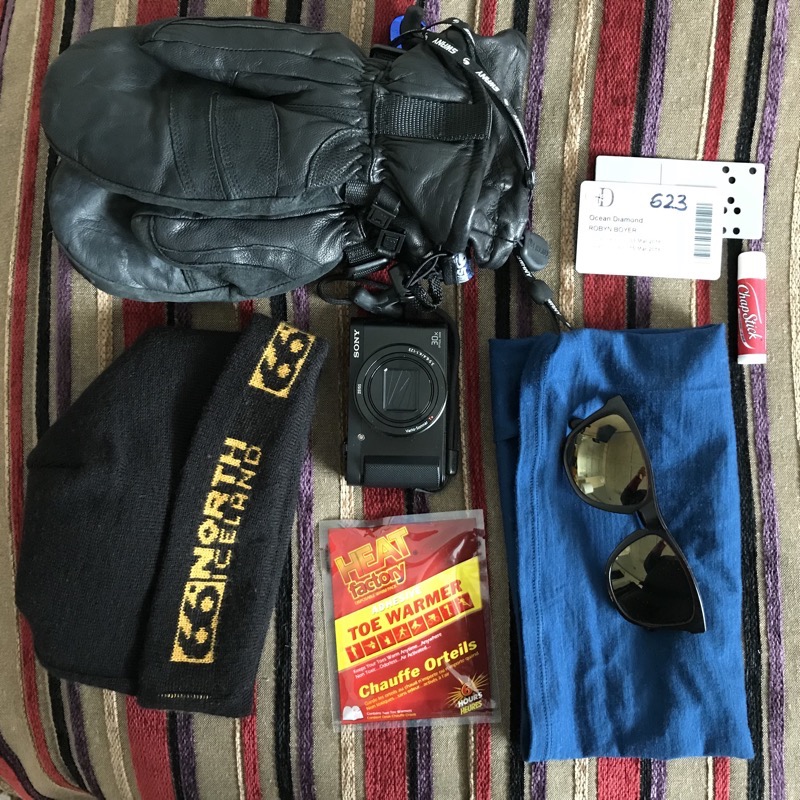
Things I wish I had brought with me…
A travel mug – there is no tea or coffee in our rooms and no room service, so to get a cuppa we need to go down to the tea and coffee station on Deck 4 and then carry it up four small flights of stairs to Deck 6. Not such a big deal, except when the ship is rocking or if there are plenty of people about. A covered travel mug would have been a good addition to my pack.
A crazy/unusual hat – even a bandana would do. It is apparently a tradition to hold an alfresco dining evening at some point throughout the expedition (weather permitting) and everyone is encouraged to wear a crazy hat. Come to think of it every cruise I’ve been on has a ‘mad hatters’ lunch or afternoon tea or something, so I probably should have been all over this one. Instead, passengers were encouraged to get resourceful and create a fun and crazy hat from found objects around the ship. Mind you, you never seem to have a lot of spare time, so making some piece of creative headgear is not so easy.
A USB stick – I usually travel with one, but for some reason, I forgot to bring one on this trip. I mentioned earlier, the Photo Journal where people can share images they are happy to have disseminated to all passengers… if there is any particular photo you absolutely love in the ‘Photo of the Day’ or you hear people talking about someone or other’s great leopard seal feeding pic, you can copy it from the laptops during the trip to get the high-resolution version, rather than wait for the resized downloadable content. A USB is also useful to share bulk pictures or videos directly with other people you meet on the ship.
Chocolate – the Expedition Staff usually only have a few hours in town during turn around days and they tend to use that time to find free wifi spots to catch up with family and friends. It turns out that one of the only food staples that they tend to run out of is chocolate. So if you’d like to make immediate friends with the expedition staff – bring lots of chocolate to bribe your way into their good books. 😉
Things I should have left behind…
Snacks – we brought a few snack foods on board, including cheese and crackers, because we know that the cheese and crackers thing isn’t really an Argentinian thing or an America thing for that matter. Many times I have walked into American supermarkets looking for the makings of a decent cheese plate, and found the options are severely limited. You just can’t find good charcuterie, pates, dips, and fancy cheeses in regular supermarkets the way you can in Australia. So we brought some of these sorts of snacks on board. What we hadn’t counted on was, Gunter – our Austrian Executive Chef on board, who has the cheese and crackers and savoury snacks thing absolutely nailed down… an entire wheel of Roquefort stationed at every buffet meal; happy thought indeed.
Walking poles – One of our party brought a walking pole with her as she has long-term knee problems, and we were anticipating crossing rocky and icy terrain when ashore. Quark provides walking poles at every landing site, so you can use theirs and not have to worry about bringing yours and putting it through the biosecurity cleaning processes.
If you happen to be reading this because you’ve stumbled on it while searching about doing a Quark Expedition and you have any questions that I might be able to provide insight on – just ask in the comments and I will do my best to answer.
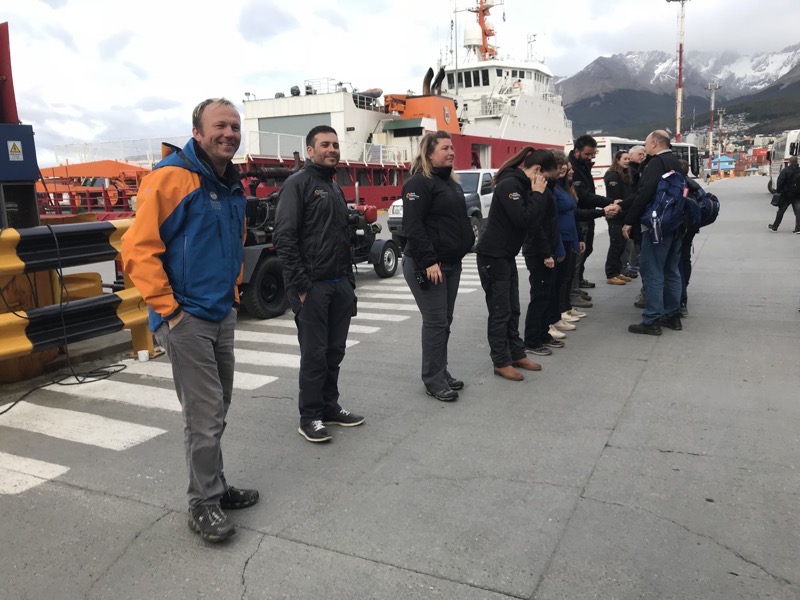 Ema is an amazing young woman – I really hope we meet again one day. I found we had so much in common. Come to Australia, Ema! <3
Ema is an amazing young woman – I really hope we meet again one day. I found we had so much in common. Come to Australia, Ema! <3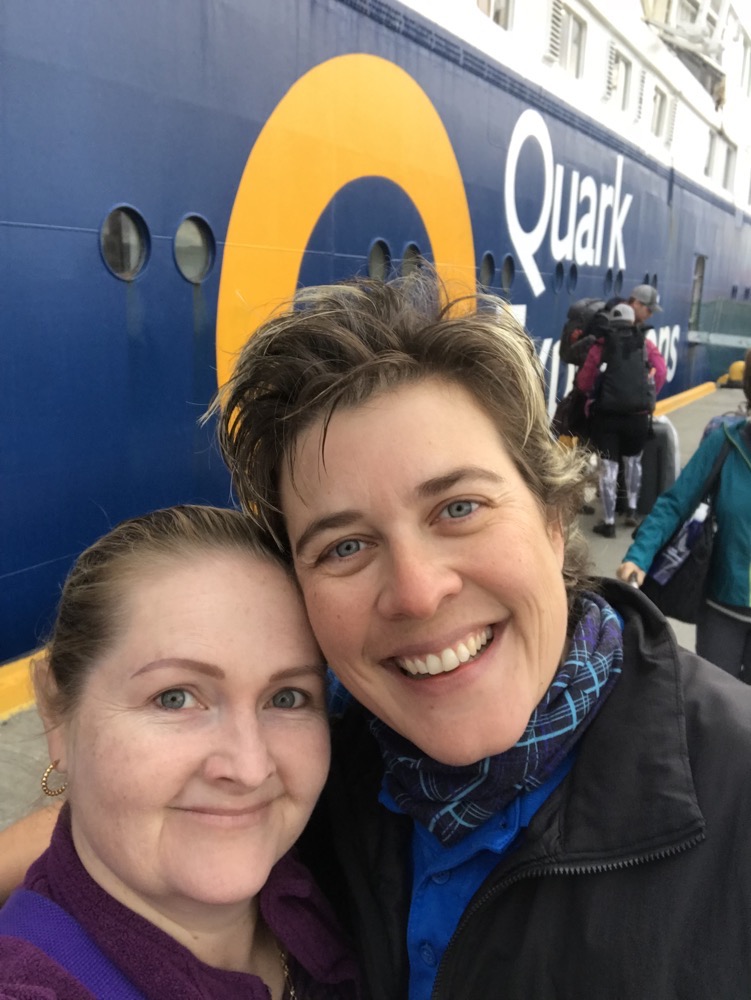 Weirdly, we were giving Woody hugs nearly every other day – he kept us informed and shared his seemingly boundless passion for Antarctica with us, and I was always wanting to hug him to thank him for sharing with us. Thankfully hugging the passengers isn’t against company policy.
Weirdly, we were giving Woody hugs nearly every other day – he kept us informed and shared his seemingly boundless passion for Antarctica with us, and I was always wanting to hug him to thank him for sharing with us. Thankfully hugging the passengers isn’t against company policy.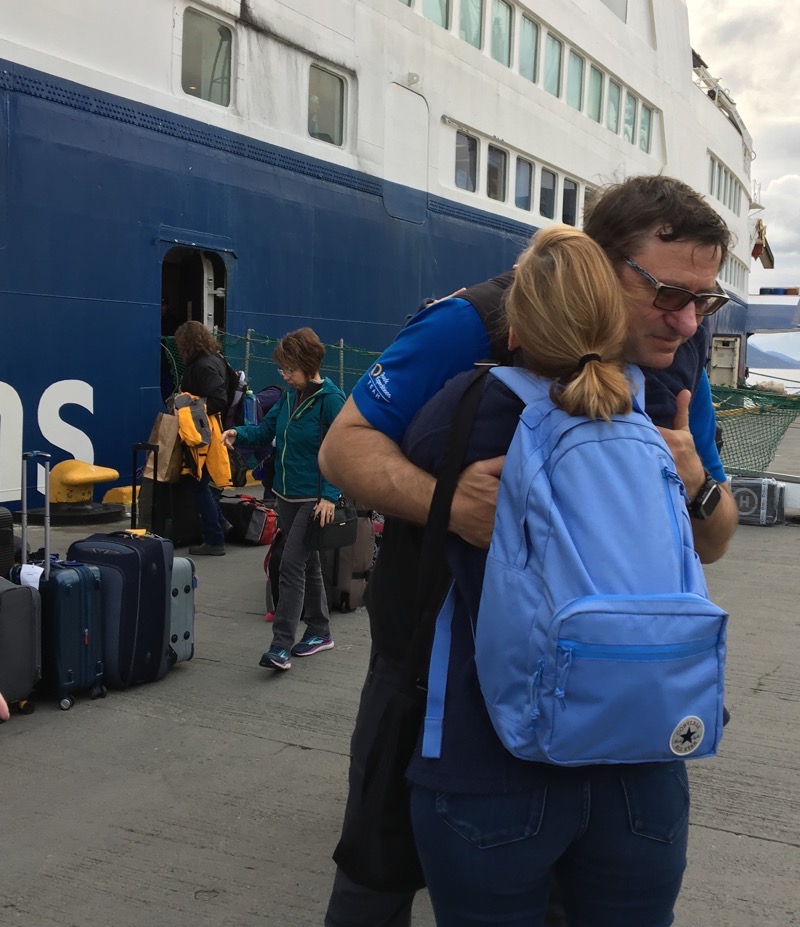 Trish and Annie.
Trish and Annie.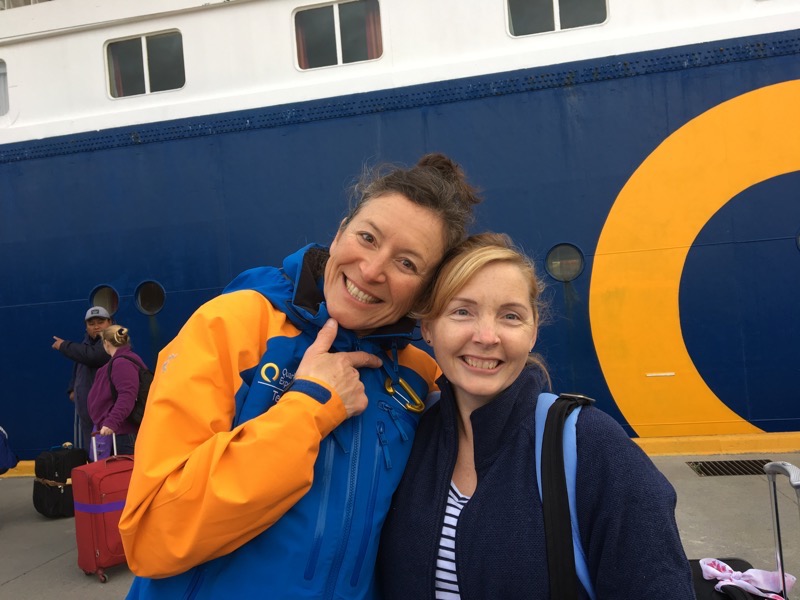 Ema crouching down to be as short as a Cross Girl. 😛
Ema crouching down to be as short as a Cross Girl. 😛 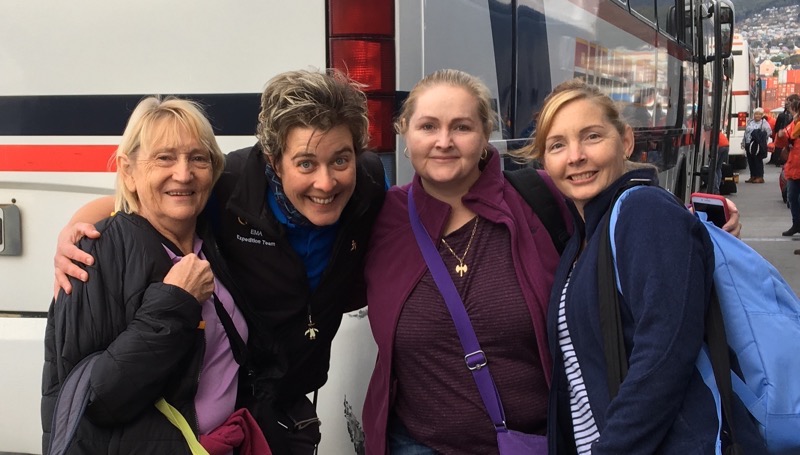
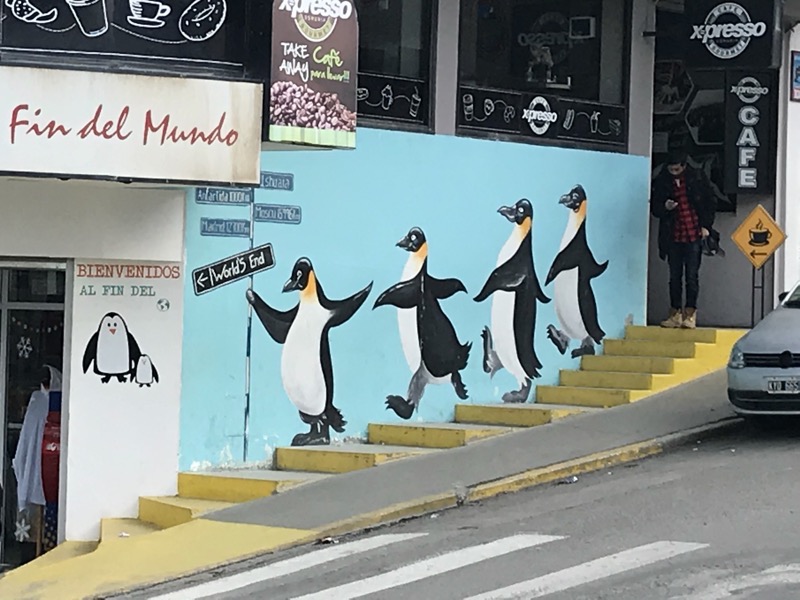 We found our hotel and dumped our luggage there and went for a wander about the town. Aunty Mary and Lyn went on a tourist tram that runs around the city, while Trish and I went shopping looking for some things for the kids – but only after catching up with everyone on the free hotel wifi first of course!
We found our hotel and dumped our luggage there and went for a wander about the town. Aunty Mary and Lyn went on a tourist tram that runs around the city, while Trish and I went shopping looking for some things for the kids – but only after catching up with everyone on the free hotel wifi first of course!
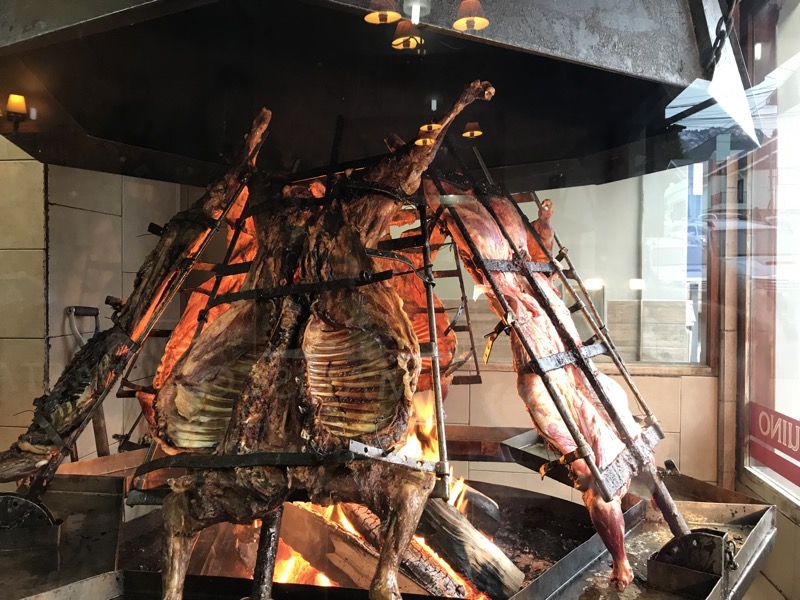
 OMG – forgot about the portion sizes. Between that and some language barrier issues, we ordered way too much food. Oh, and guess what? We ran into more people from the ship at this restaurant too… who’d’ve thought?
OMG – forgot about the portion sizes. Between that and some language barrier issues, we ordered way too much food. Oh, and guess what? We ran into more people from the ship at this restaurant too… who’d’ve thought?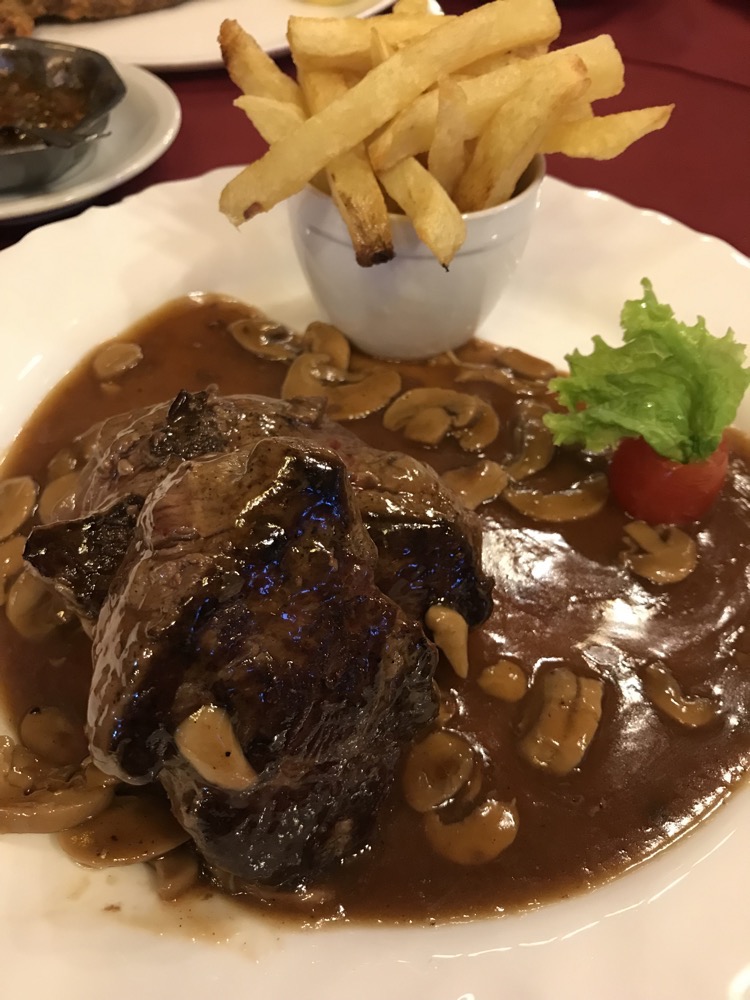
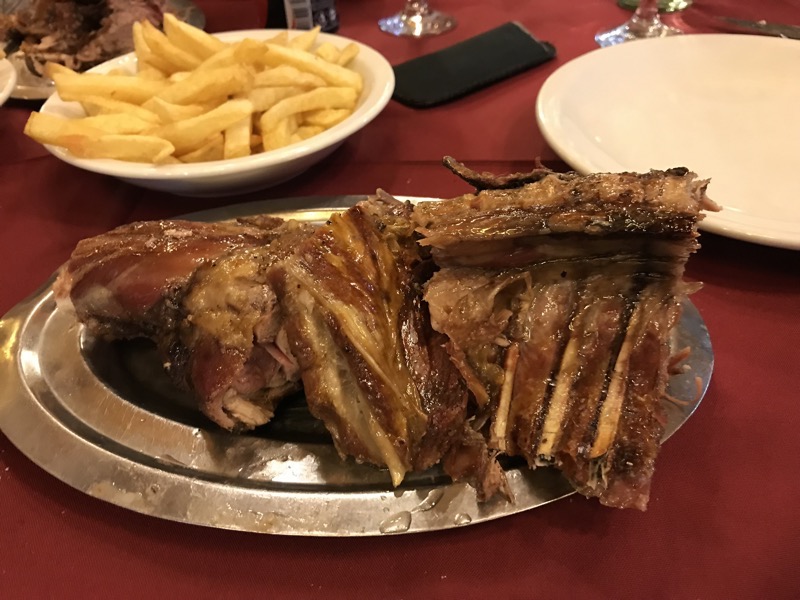
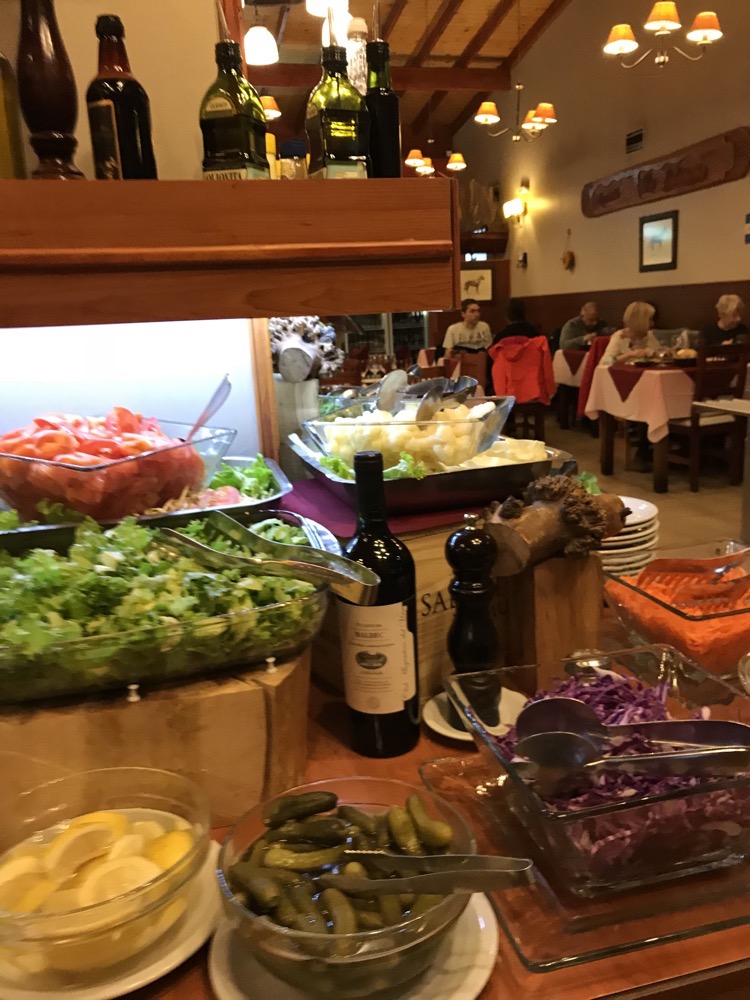 With full bellies and a few vinos under our belts, we wandered back down to the Hotel Albatross for our last night in South America. Tomorrow the Dread Transit starts in earnest.
With full bellies and a few vinos under our belts, we wandered back down to the Hotel Albatross for our last night in South America. Tomorrow the Dread Transit starts in earnest.

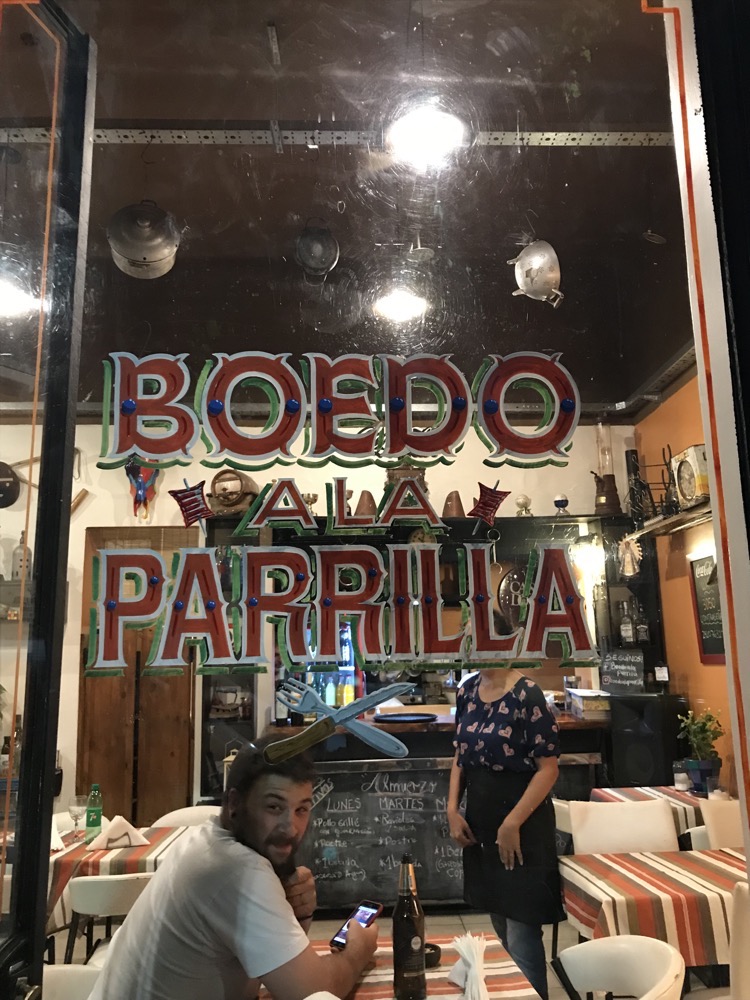
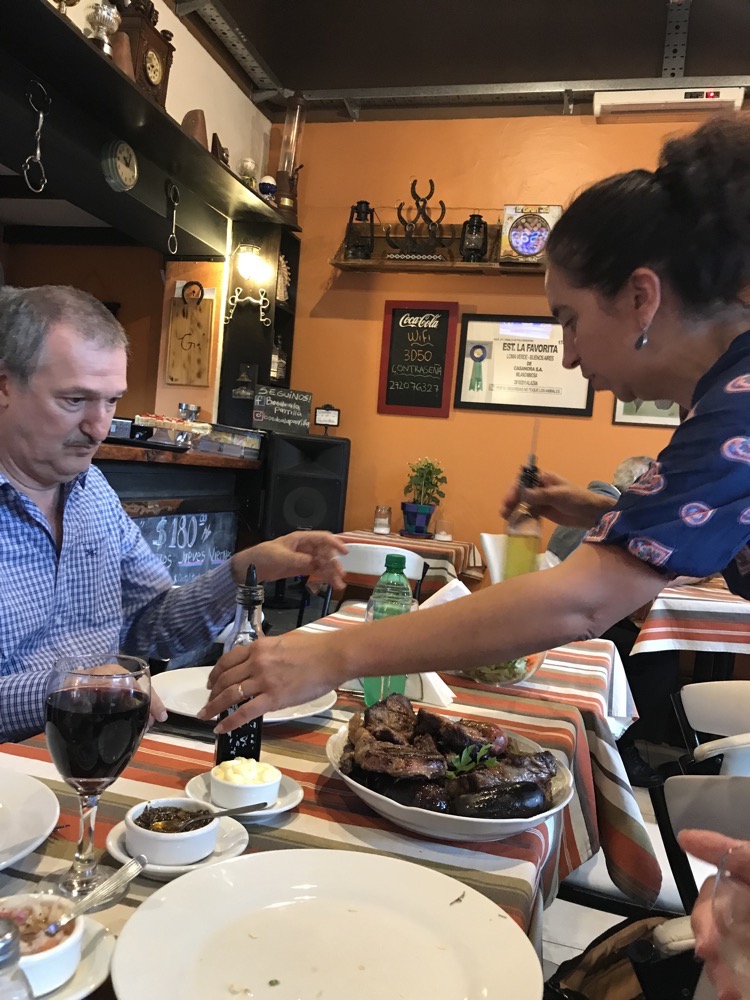 We had an incredible platter of BBQ’d meats – lamb, beef, chorizo, black pudding, and something that may have been offal or donkey (not sure). Some wine, fresh bread and a token bit of salad and we were very happily recovered from our airline muesli bars indeed. 🙂
We had an incredible platter of BBQ’d meats – lamb, beef, chorizo, black pudding, and something that may have been offal or donkey (not sure). Some wine, fresh bread and a token bit of salad and we were very happily recovered from our airline muesli bars indeed. 🙂 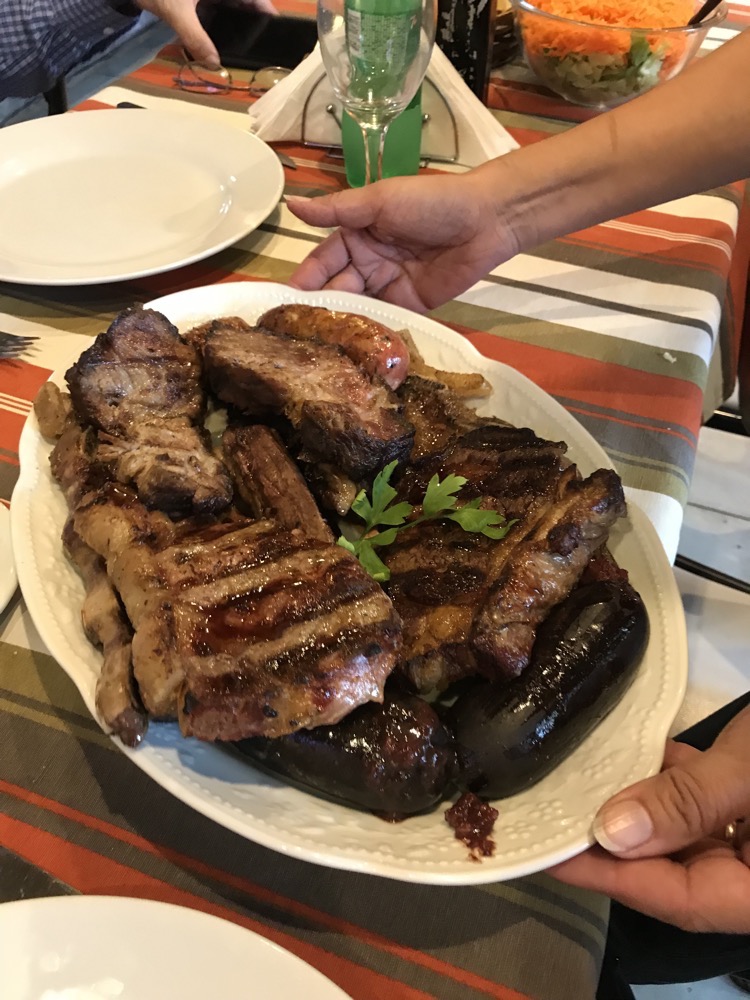 Sadly, dinner came to an end, and Jorge took us to EZE International airport to await our long-haul flight. We checked in, and ran into Jessica and Louise, again. Then found somewhere comfy to wait for our flight which was just after midnight. The flight is much as these things always are, with extra bonus horrible thanks to the prat in front of me who reclined his seat within minutes of getting into the air, and of course, I’m still coughing from the end of the flu thing I have. Thankfully though, we were able to wave away the horrible airline food as we had been stuffed full of wonderful BBQ meats and chimichurri goodness.
Sadly, dinner came to an end, and Jorge took us to EZE International airport to await our long-haul flight. We checked in, and ran into Jessica and Louise, again. Then found somewhere comfy to wait for our flight which was just after midnight. The flight is much as these things always are, with extra bonus horrible thanks to the prat in front of me who reclined his seat within minutes of getting into the air, and of course, I’m still coughing from the end of the flu thing I have. Thankfully though, we were able to wave away the horrible airline food as we had been stuffed full of wonderful BBQ meats and chimichurri goodness.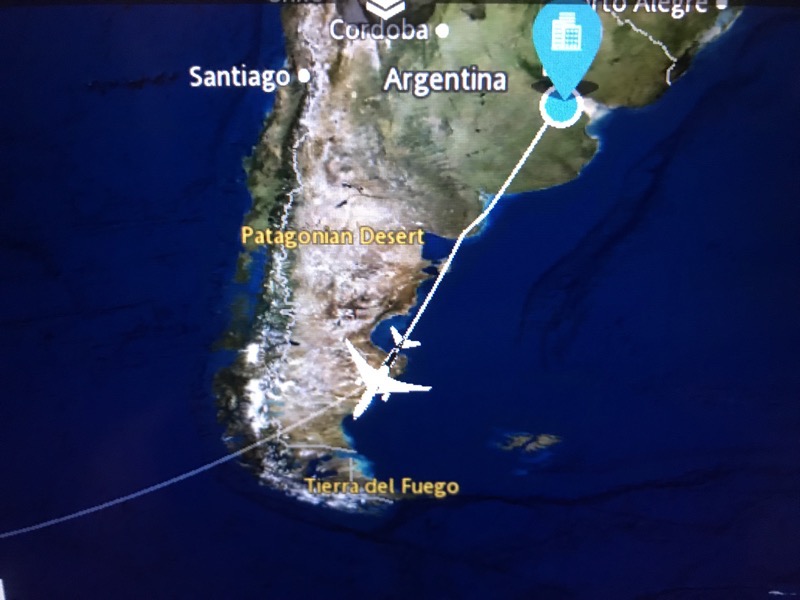 We were headed right back to Ushuaia! If there were direct flights we could have knocked six hours flying time off the trip! Arggh! We had heard that the first flight to land at Ushuaia’s international airport was from Melbourne and had come directly over the Antarctic continent – but they don’t do that route anymore – not enough call for it. Nothing to be done but to sit back and take all the drugs.
We were headed right back to Ushuaia! If there were direct flights we could have knocked six hours flying time off the trip! Arggh! We had heard that the first flight to land at Ushuaia’s international airport was from Melbourne and had come directly over the Antarctic continent – but they don’t do that route anymore – not enough call for it. Nothing to be done but to sit back and take all the drugs.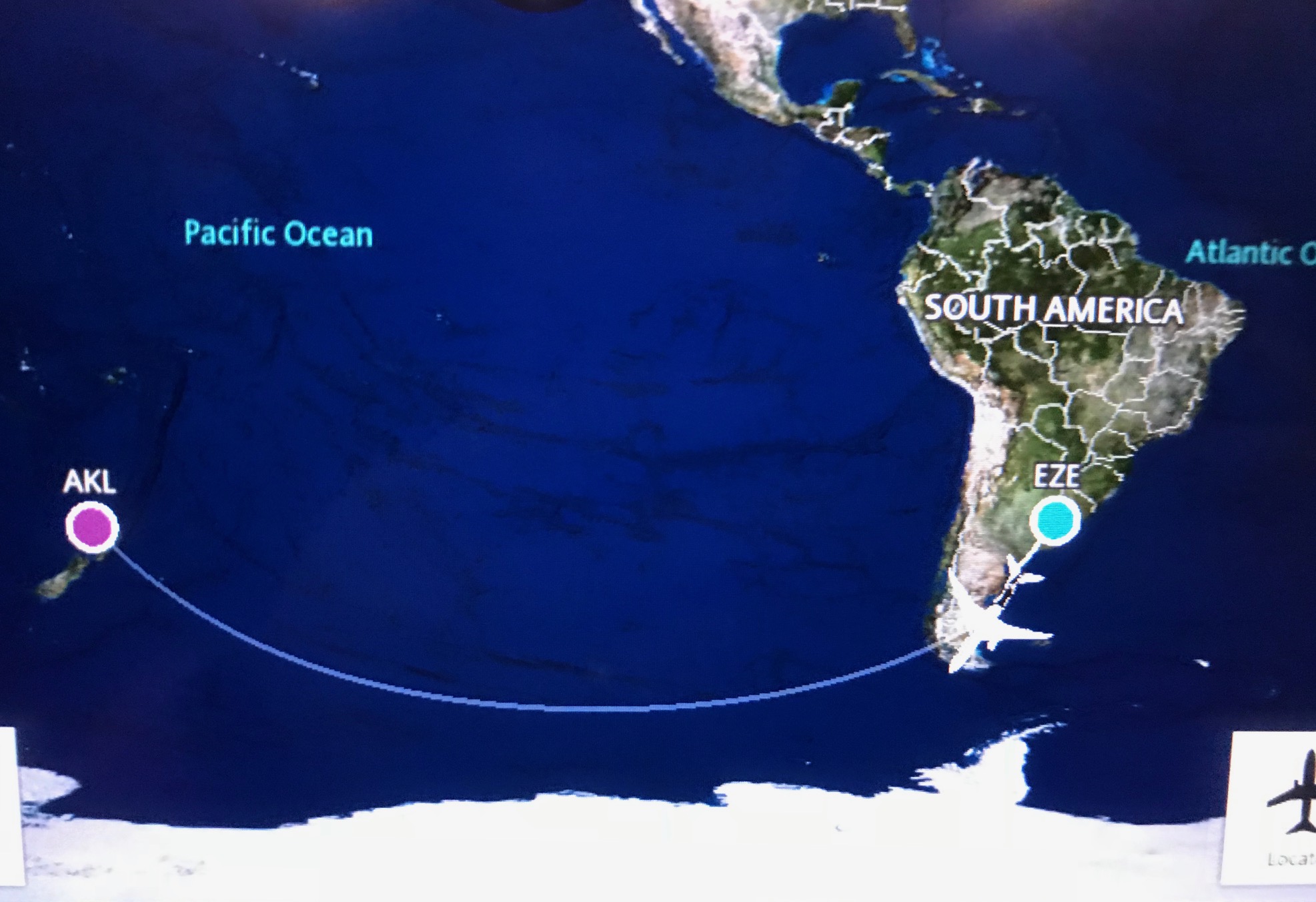 I managed to get some sleep on the plane, but won’t be admitting to how much of what medications it took to achieve that. And eventually we arrived in Auckland. There we had another three-hour layover (‘Hi, Jessica and Lousie, oh and Mark too) before we were to board to Brisbane. Unfortunately, our flight was delayed by nearly an hour. Fortunately (or perhaps miraculously) they seemed to make up most of that time in the air somehow – I’m not asking questions on that one.
I managed to get some sleep on the plane, but won’t be admitting to how much of what medications it took to achieve that. And eventually we arrived in Auckland. There we had another three-hour layover (‘Hi, Jessica and Lousie, oh and Mark too) before we were to board to Brisbane. Unfortunately, our flight was delayed by nearly an hour. Fortunately (or perhaps miraculously) they seemed to make up most of that time in the air somehow – I’m not asking questions on that one.







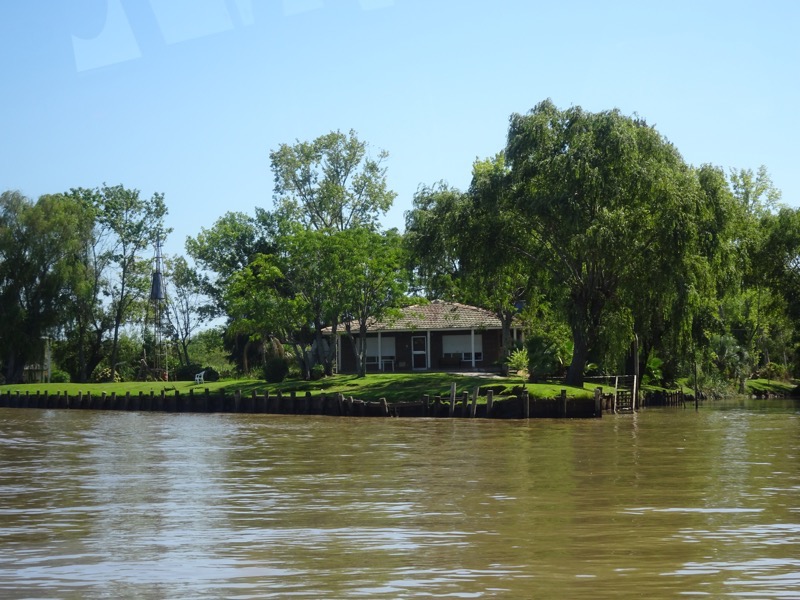
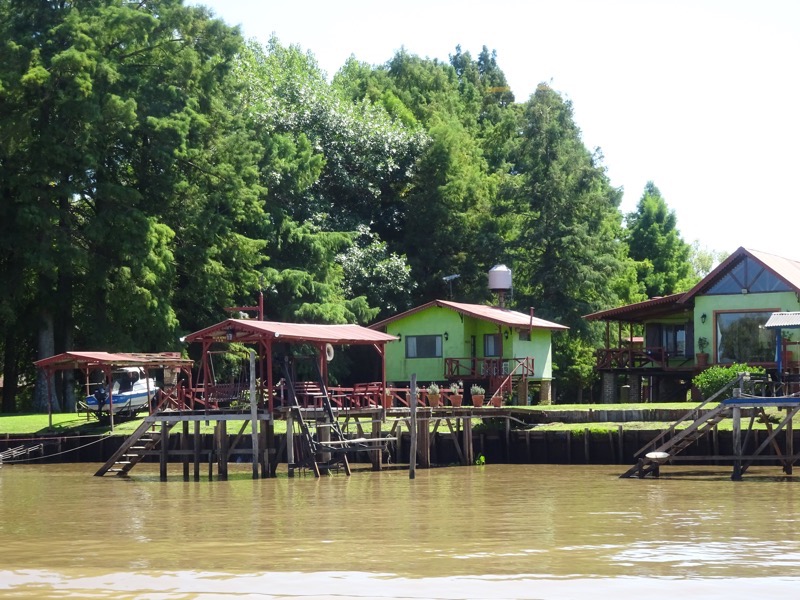 Each home has its own little jetty or pontoon as this is a community that thrives on its waterways. They have mail boats, rubbish boats, supermarket boats and even ice-cream boats that service the community. Kids get to and from school by boat.
Each home has its own little jetty or pontoon as this is a community that thrives on its waterways. They have mail boats, rubbish boats, supermarket boats and even ice-cream boats that service the community. Kids get to and from school by boat.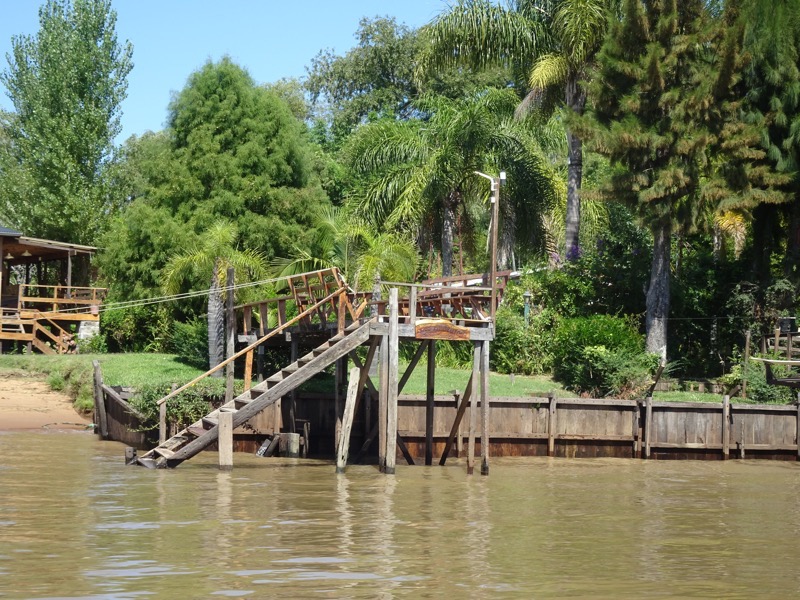
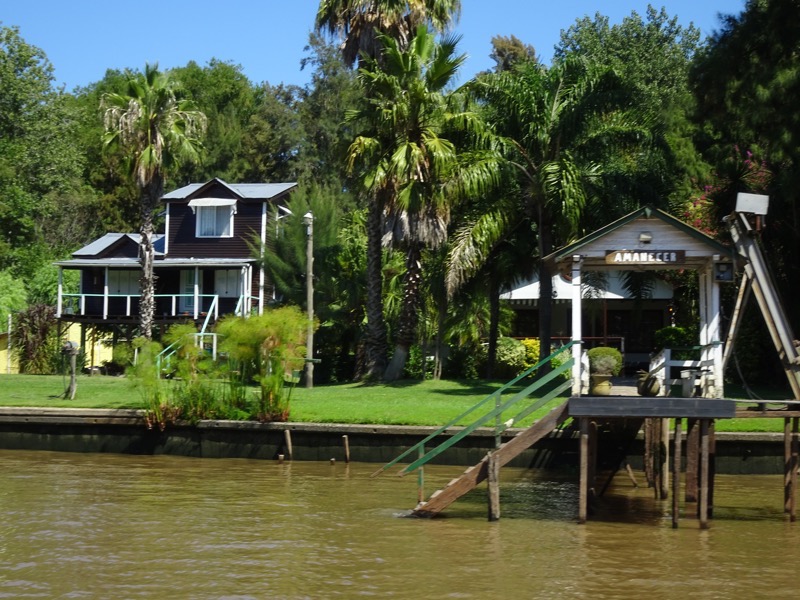 Houses are varying from grand to dilapidated, some have permanent residents and many are able to be rented as holiday destinations. The guide on the boat mentioned that many of them are weekend homes for people who live and work in the city.
Houses are varying from grand to dilapidated, some have permanent residents and many are able to be rented as holiday destinations. The guide on the boat mentioned that many of them are weekend homes for people who live and work in the city.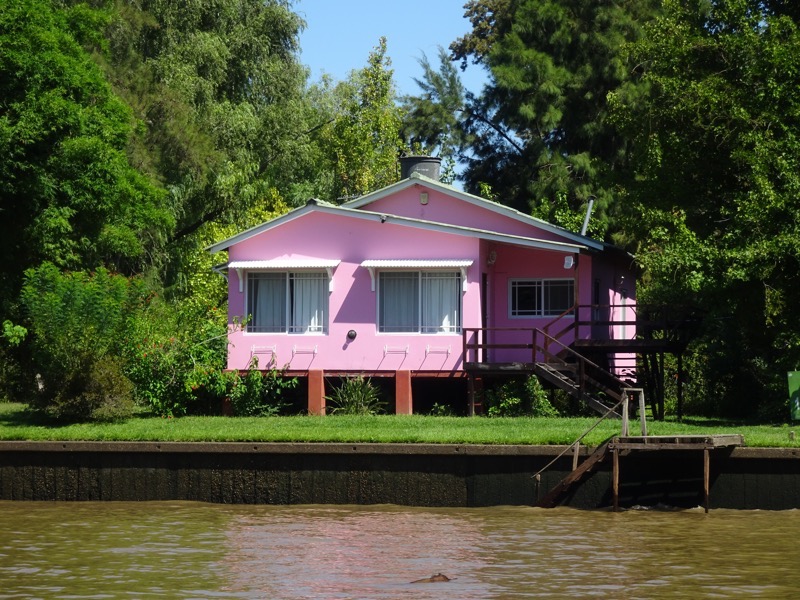 In the centre of the delta is this odd house covered by a glass cube – it is the house of one, Domingo Faustino Sarmiento, considered the ‘Father of Argentinian Classrooms’ or the founder of modern Argentinian education. Built in the 1860s, the house has been placed in the glass cube to preserve it from the wind, weather and constant humidity.
In the centre of the delta is this odd house covered by a glass cube – it is the house of one, Domingo Faustino Sarmiento, considered the ‘Father of Argentinian Classrooms’ or the founder of modern Argentinian education. Built in the 1860s, the house has been placed in the glass cube to preserve it from the wind, weather and constant humidity.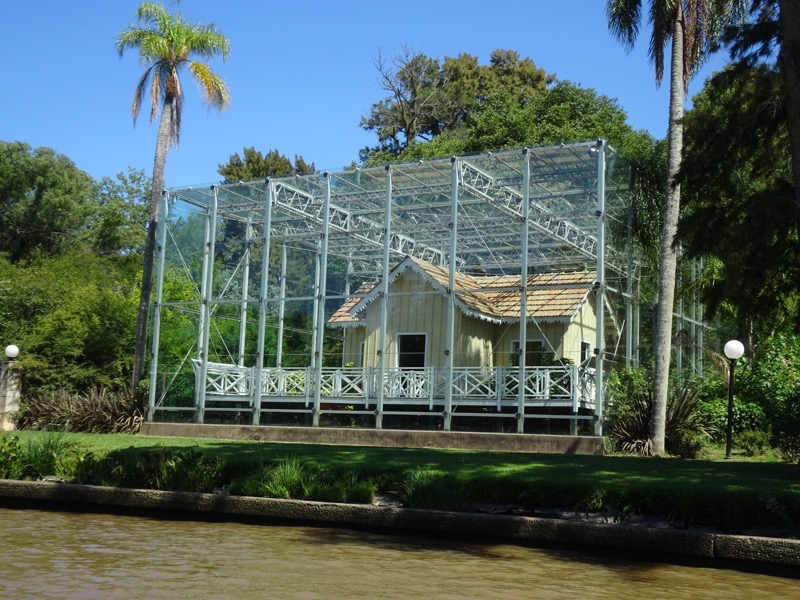 The area is well known for its rowers and the Argentinian Rowing Club is located in the delta… leading to the common site of crazy people out rowing at midday… without hats.
The area is well known for its rowers and the Argentinian Rowing Club is located in the delta… leading to the common site of crazy people out rowing at midday… without hats.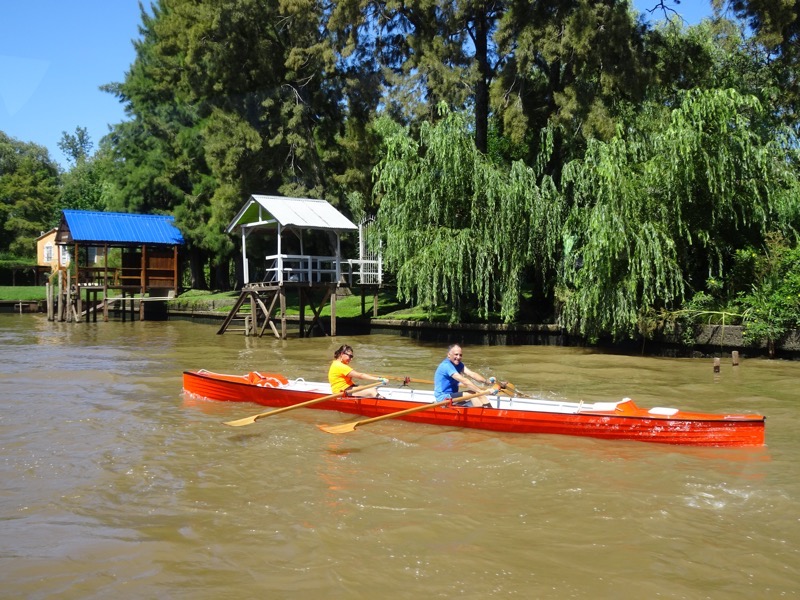 Further towards the town of Tigre, you can see large marketplaces where people can come (by boat) to do larger shopping and pick up supplies.
Further towards the town of Tigre, you can see large marketplaces where people can come (by boat) to do larger shopping and pick up supplies.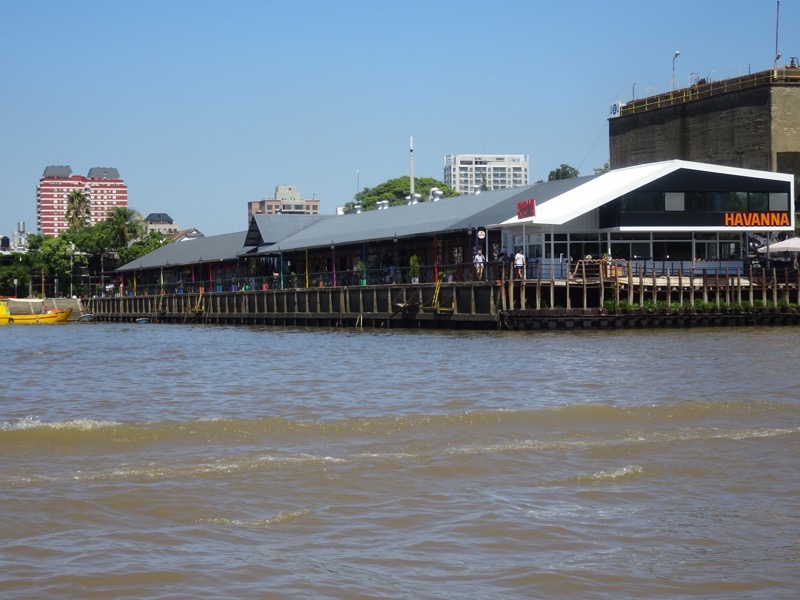 Also nearby is the famous Parque de la Costa, which is like the largest amusement park in Argentina or South America or something or other… I kinda wasn’t paying attention when he said that bit 😛 In my defence, we do live barely half an hour from a handful of theme parks, so I’m not all that interested in them.
Also nearby is the famous Parque de la Costa, which is like the largest amusement park in Argentina or South America or something or other… I kinda wasn’t paying attention when he said that bit 😛 In my defence, we do live barely half an hour from a handful of theme parks, so I’m not all that interested in them.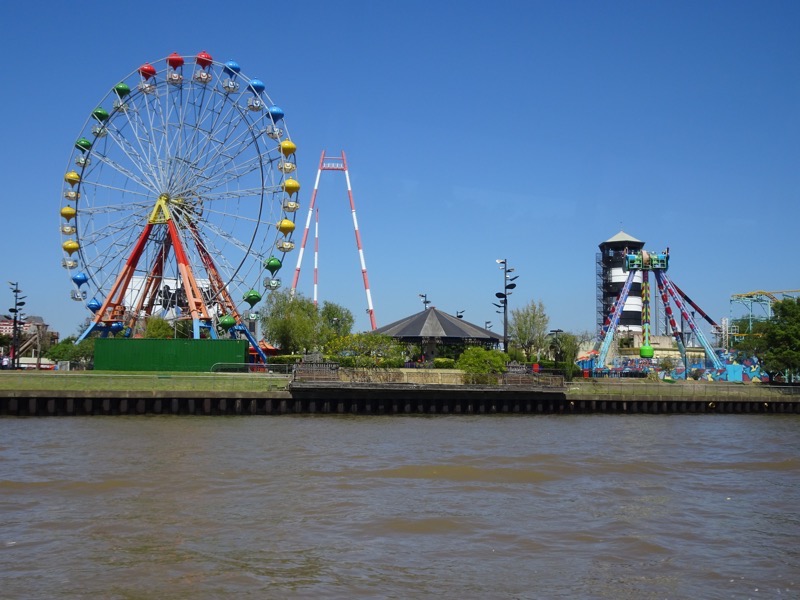 After our genteel pottering around on boats for the morning, we got to go visit the beautiful Cathedral de San Isidro which, oddly enough, is located in the centre of the small town of San Isidro. The Cathedral was built in 1898 on the site where a cathedral had stood since the early 1700s. As per usual for South American structures from this period (well, so it seemed from our extensive tour last year), it was designed by French architects and is built in a very aesthetically pleasing, neogothic style.
After our genteel pottering around on boats for the morning, we got to go visit the beautiful Cathedral de San Isidro which, oddly enough, is located in the centre of the small town of San Isidro. The Cathedral was built in 1898 on the site where a cathedral had stood since the early 1700s. As per usual for South American structures from this period (well, so it seemed from our extensive tour last year), it was designed by French architects and is built in a very aesthetically pleasing, neogothic style. 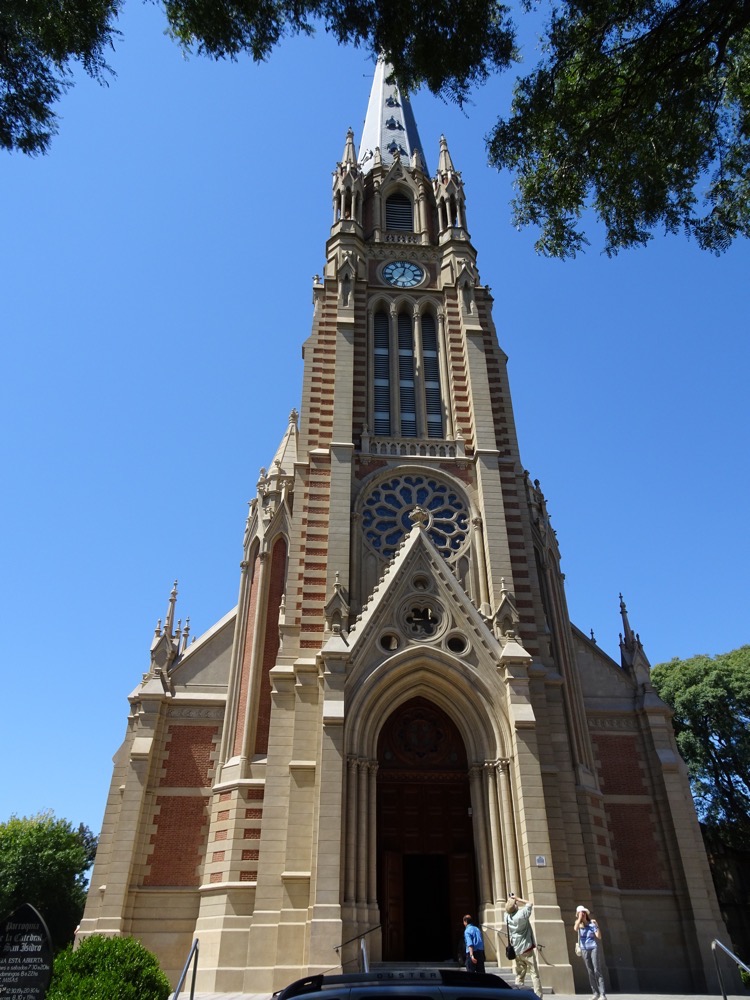 It has gorgeous stained glass windows and its spire reaches just shy of 70m tall (which is the same height as Buenos Aire’s Obelisk, don’t you know?). It has recently undergone extensive renovations which is why the entire building looks brand new. It is a truly lovely church.
It has gorgeous stained glass windows and its spire reaches just shy of 70m tall (which is the same height as Buenos Aire’s Obelisk, don’t you know?). It has recently undergone extensive renovations which is why the entire building looks brand new. It is a truly lovely church.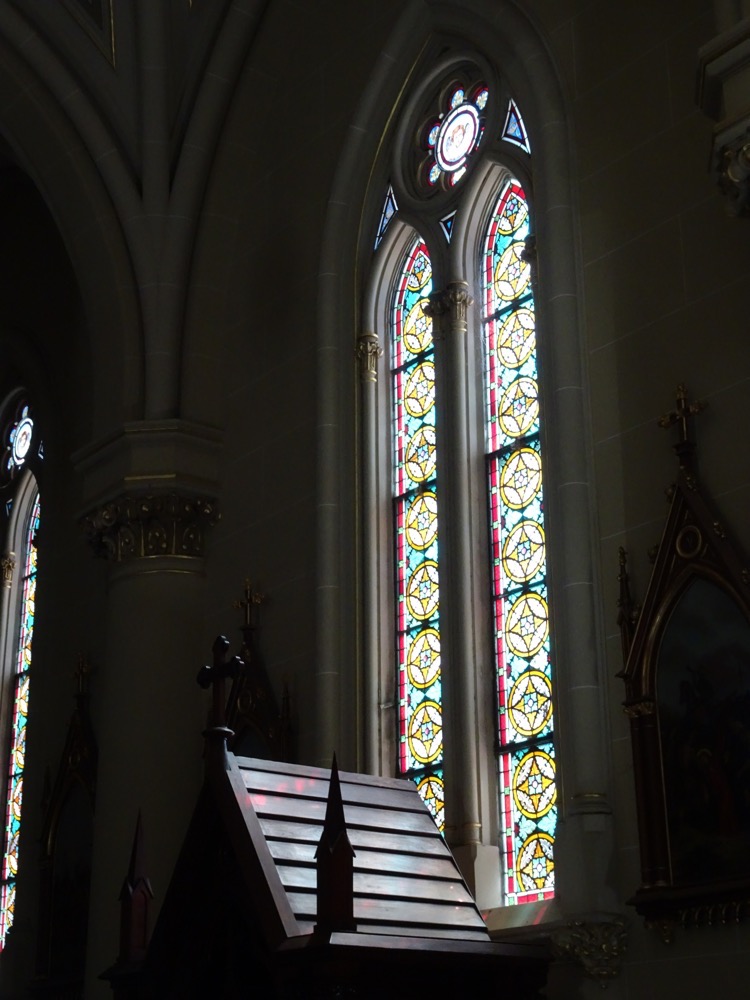 After we visited the Cathedral we had a quick stop, just long enough for a lemon gelato and then it was time to head back to Buenos Aires. We decided to make like the Spanish for the remainder of the afternoon and have a much-needed siesta.
After we visited the Cathedral we had a quick stop, just long enough for a lemon gelato and then it was time to head back to Buenos Aires. We decided to make like the Spanish for the remainder of the afternoon and have a much-needed siesta.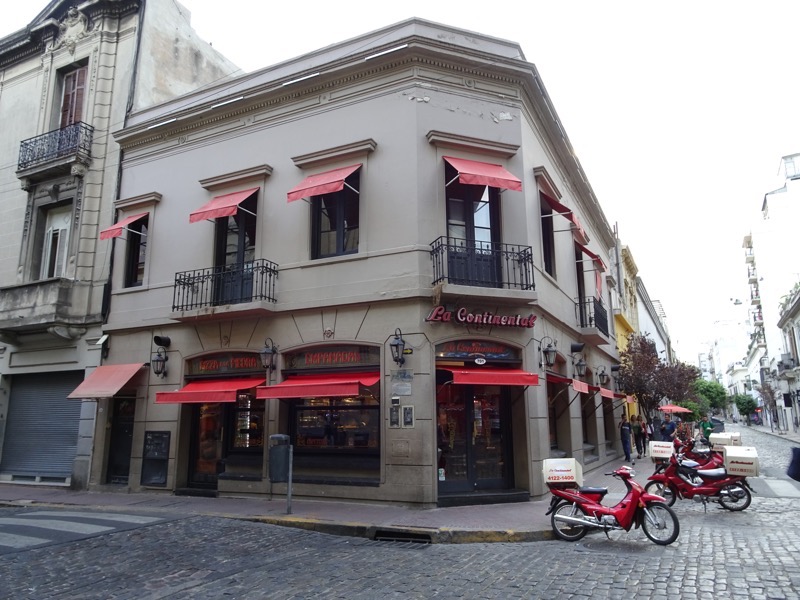
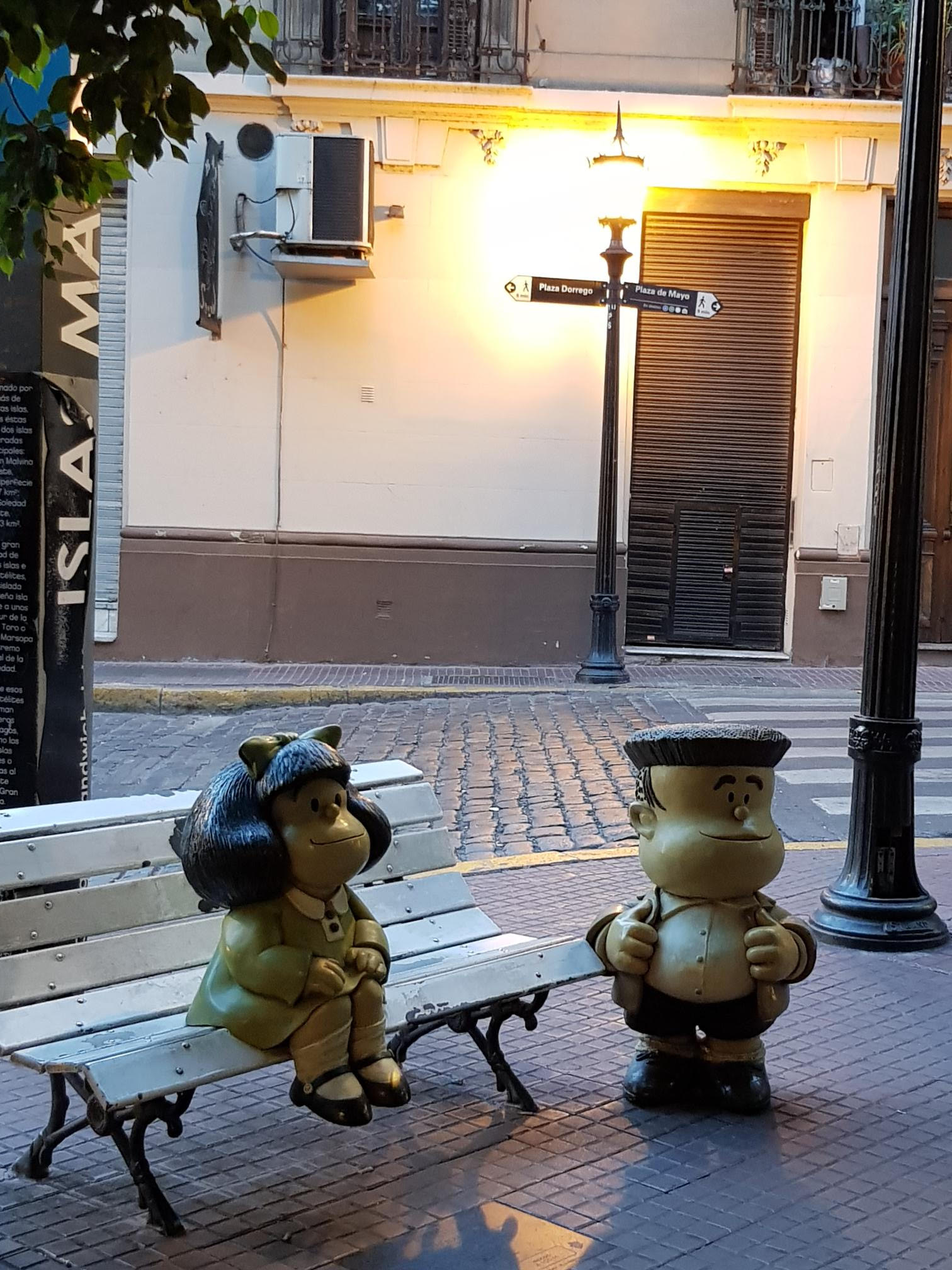
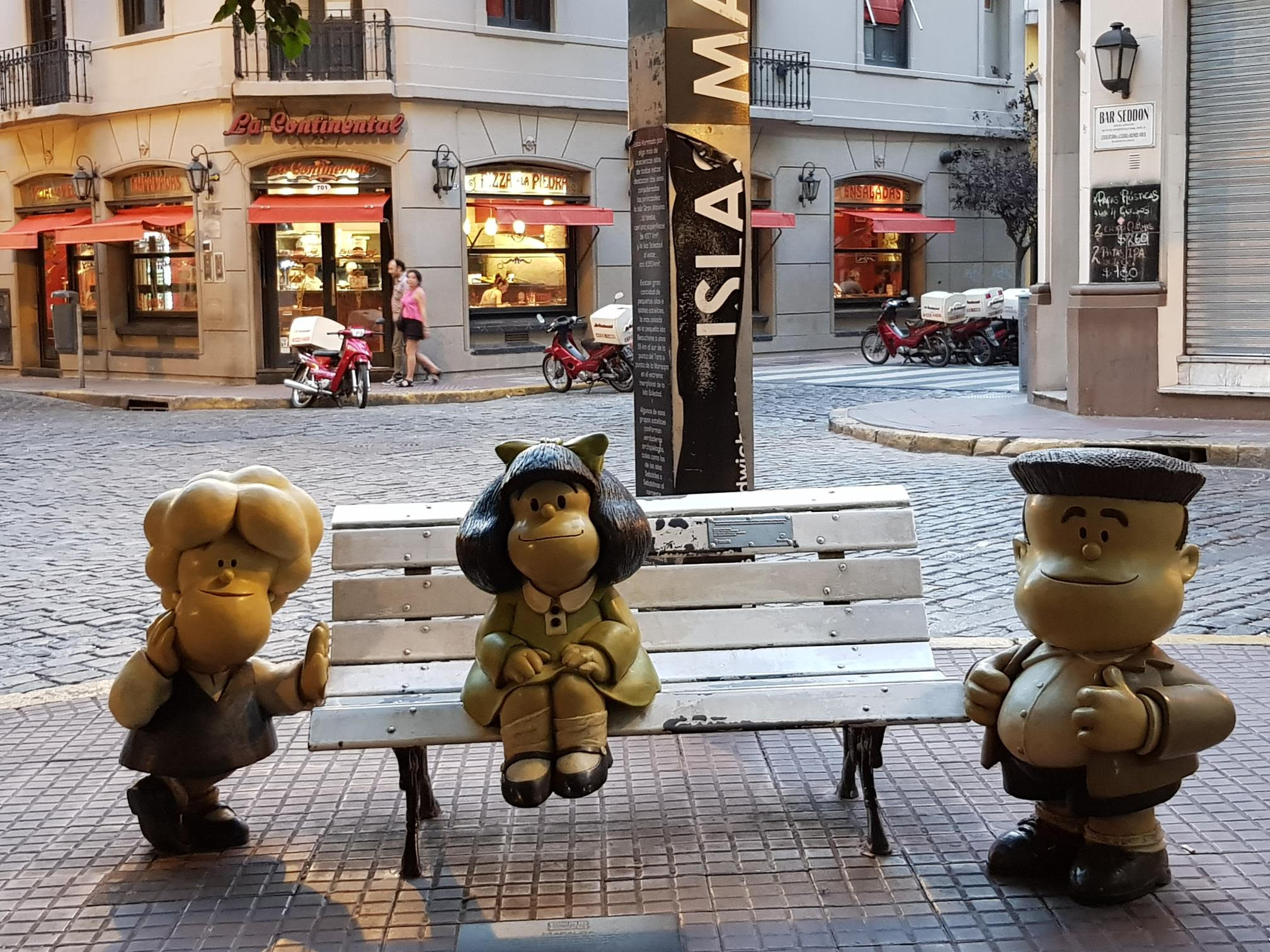 Anyway, we made it to Desnivel just as the place was opening at 7pm. Argentines traditionally dine quite late and while we wandered into a nearly empty restuarant, the place was getting quite busy as patrons kept walking in as late as 9:30pm to 10pm.
Anyway, we made it to Desnivel just as the place was opening at 7pm. Argentines traditionally dine quite late and while we wandered into a nearly empty restuarant, the place was getting quite busy as patrons kept walking in as late as 9:30pm to 10pm.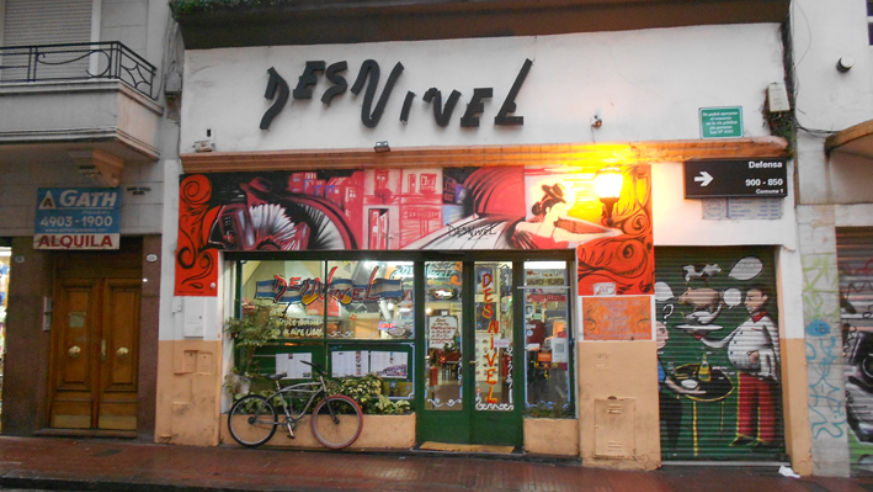

 After we ordered some drinks – caipirinha, margartita, and pisco sours… our lump of wax came out like this – well cooked and covered in peppers, bacon, provoletta, and herbs. Absolutely beautiful. Add a tiny bit of chimichurri and Bob’s your uncle.
After we ordered some drinks – caipirinha, margartita, and pisco sours… our lump of wax came out like this – well cooked and covered in peppers, bacon, provoletta, and herbs. Absolutely beautiful. Add a tiny bit of chimichurri and Bob’s your uncle.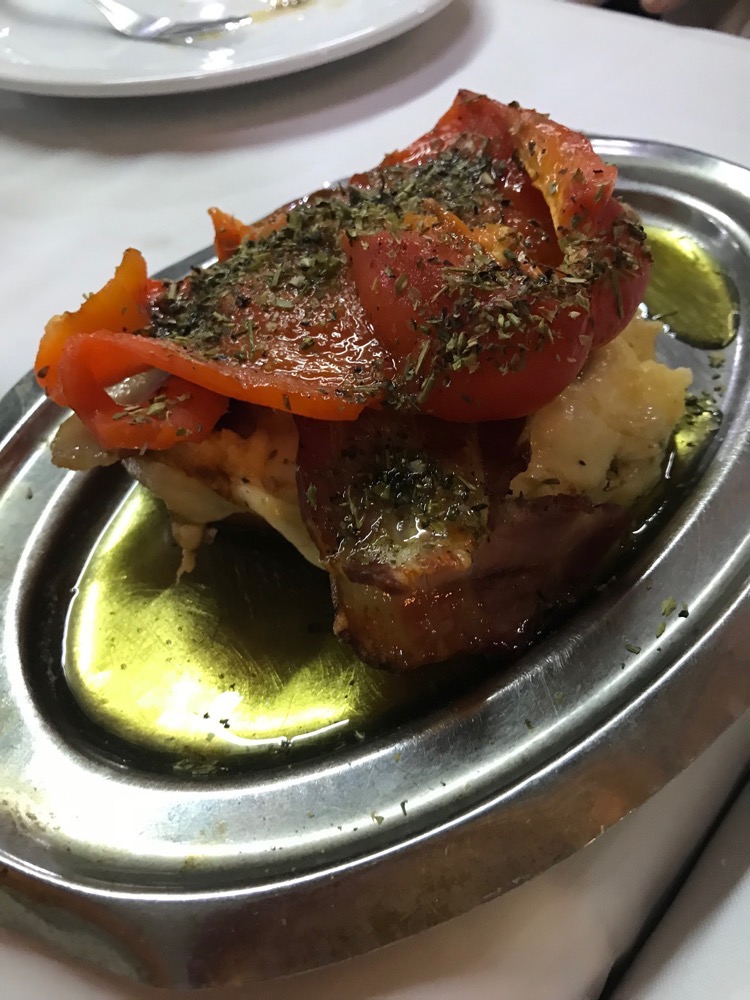 After sharing some provaletta for an entre, we had steak tenderloins (what we would just call a fillet steak) that was served drowning in delicious mushroom sauce and with pomme noisettes. None a pesky vegetable in sight at this steakhouse 😉 And Ceri was right, I have never – and I mean that literally – I have never had such tender steak in my life. Thanks to Ceri’s advice we ordered one steak between the two of us and didn’t have to be rolled out of the restaurant.
After sharing some provaletta for an entre, we had steak tenderloins (what we would just call a fillet steak) that was served drowning in delicious mushroom sauce and with pomme noisettes. None a pesky vegetable in sight at this steakhouse 😉 And Ceri was right, I have never – and I mean that literally – I have never had such tender steak in my life. Thanks to Ceri’s advice we ordered one steak between the two of us and didn’t have to be rolled out of the restaurant. The steak cut like butter and almost melted in your mouth. It was beautifully cooked and so light and tender. Phenomenal… we were all commenting what a shame it was we hadn’t made the effort to come last night as we would have been back for a second meal tonight as well, it was that good!
The steak cut like butter and almost melted in your mouth. It was beautifully cooked and so light and tender. Phenomenal… we were all commenting what a shame it was we hadn’t made the effort to come last night as we would have been back for a second meal tonight as well, it was that good!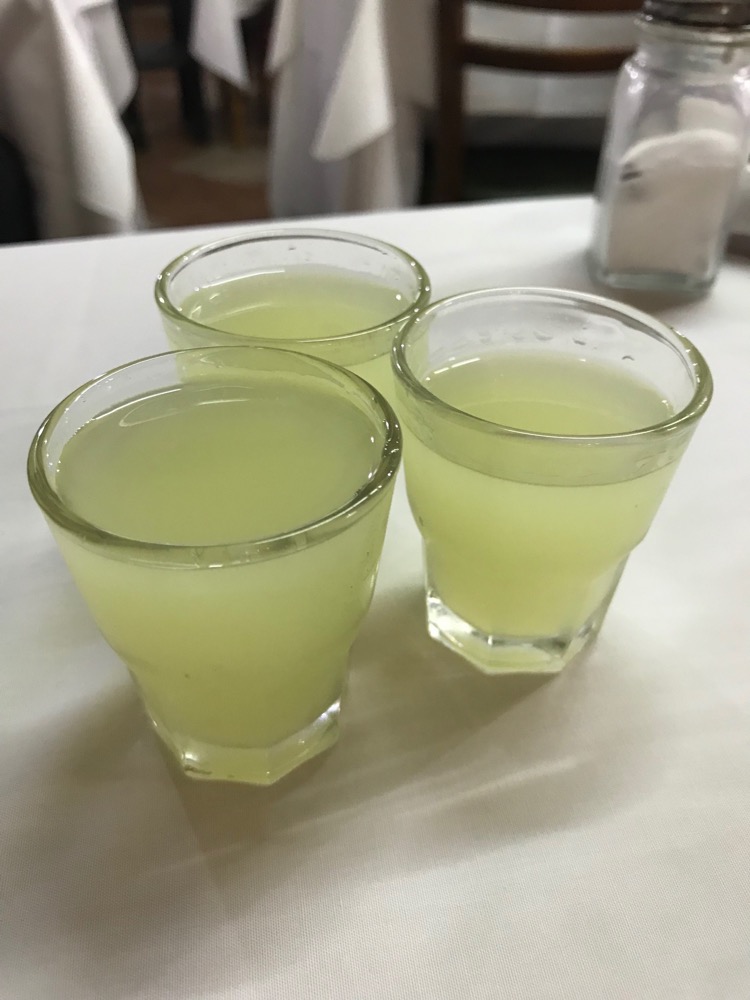 Eventually our waiter just brought over the damn bottle. 🙂
Eventually our waiter just brought over the damn bottle. 🙂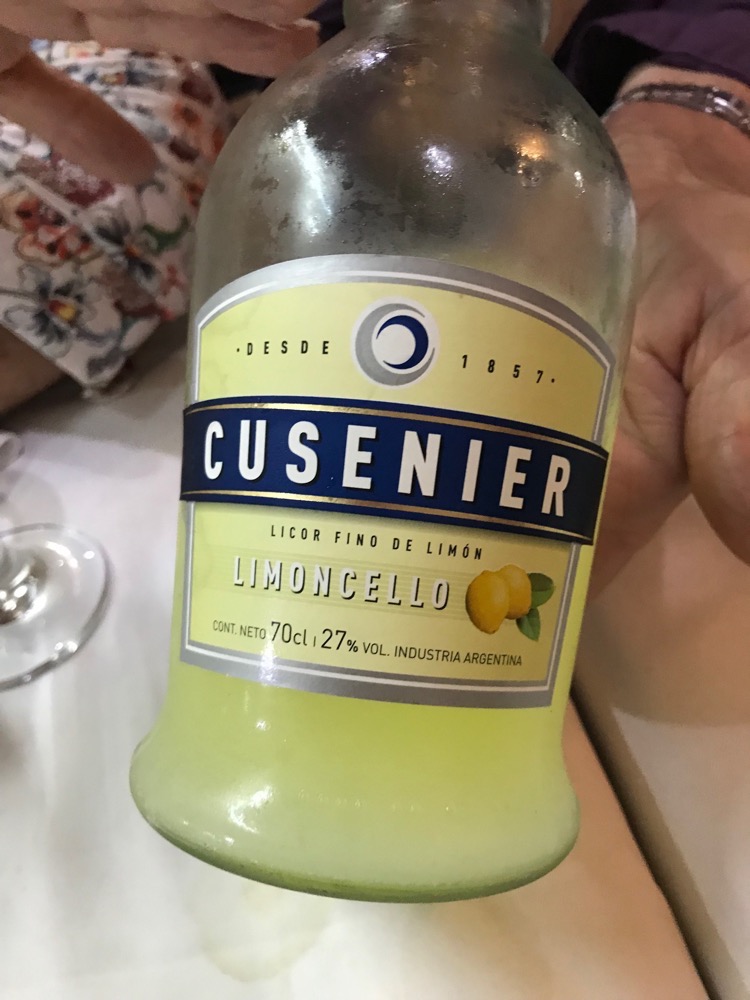 Finally, well fed and cheerful, we paid for our meal in what looks like a king’s ransom and spilled out onto the street to find a cab.
Finally, well fed and cheerful, we paid for our meal in what looks like a king’s ransom and spilled out onto the street to find a cab.
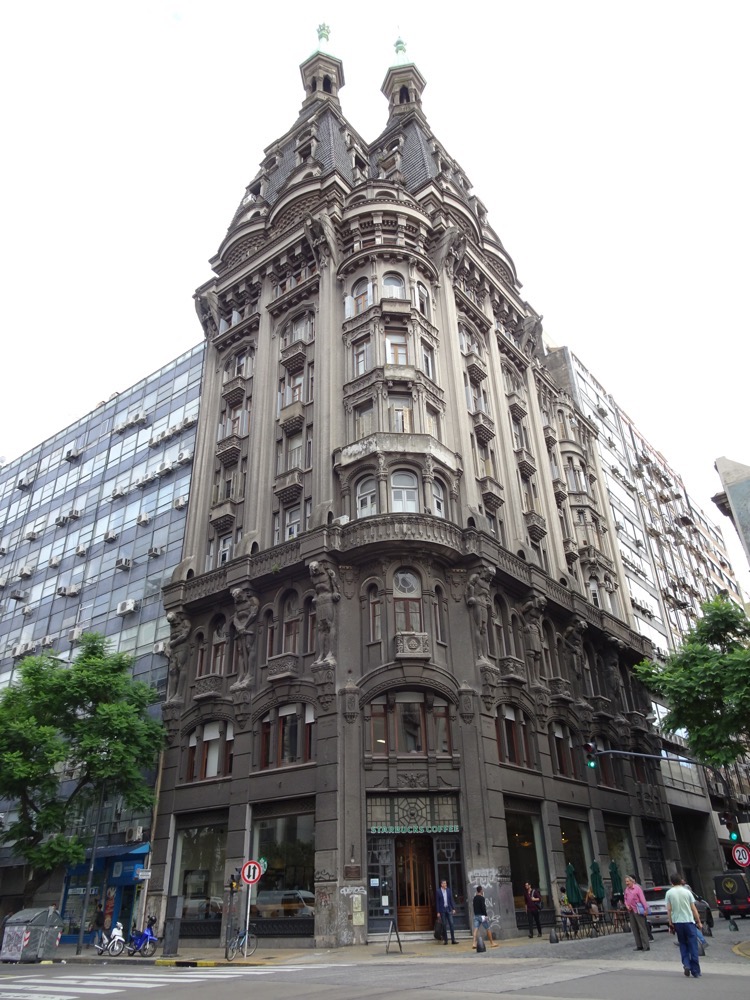 One of our next stops was the Parque Lezama… where we roundly ignored the statue of Pedro de Mendoza who allegedly founded the city of Buenos Aires in 1536, and went instead wandering the back streets to find a cafe. Being Australian, Ceri thought we’d want to find ‘good coffee’. It is apparently the one thing that Australians want when they get here and so he took us to a cafe- where we ordered one lemonade, one iced tea and one iced coffee, as I don’t drink coffee at all and none of us are big coffee drinkers. It was at this point, he questioned if we were actually Australian.
One of our next stops was the Parque Lezama… where we roundly ignored the statue of Pedro de Mendoza who allegedly founded the city of Buenos Aires in 1536, and went instead wandering the back streets to find a cafe. Being Australian, Ceri thought we’d want to find ‘good coffee’. It is apparently the one thing that Australians want when they get here and so he took us to a cafe- where we ordered one lemonade, one iced tea and one iced coffee, as I don’t drink coffee at all and none of us are big coffee drinkers. It was at this point, he questioned if we were actually Australian.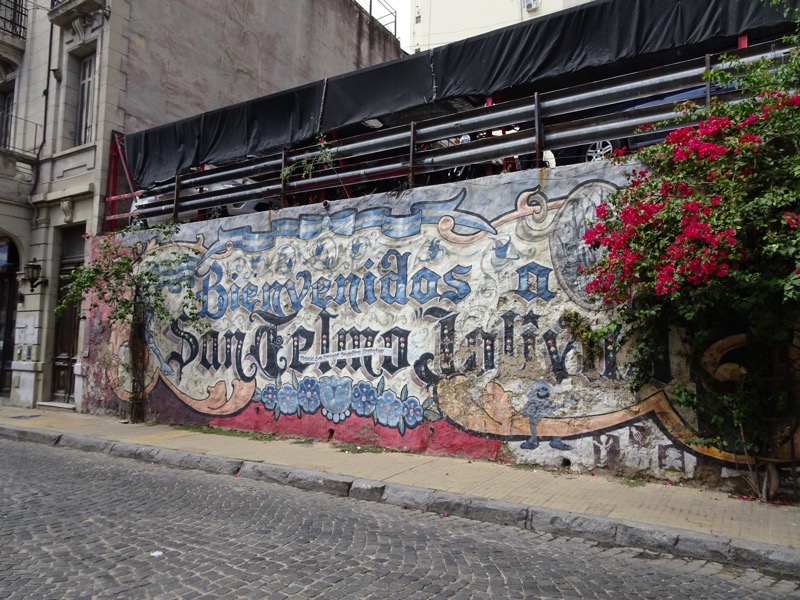
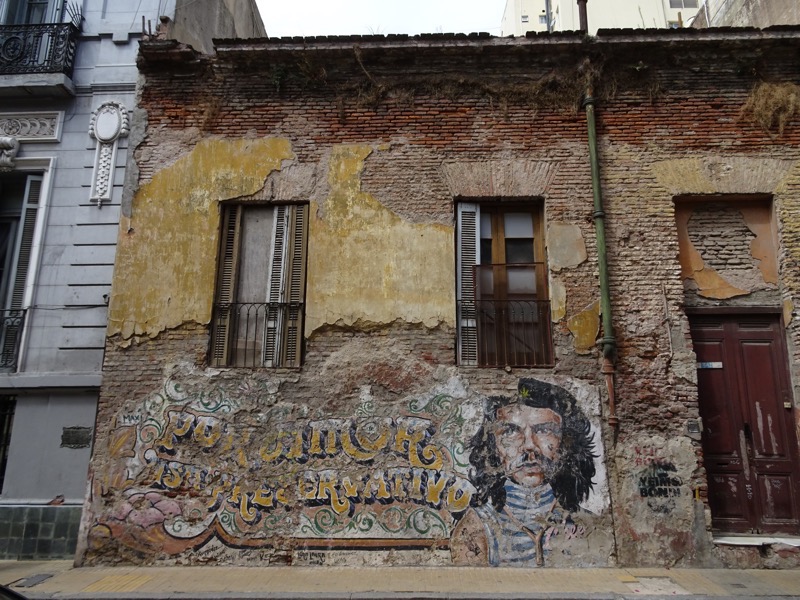 Random window above the street level near Defensor – makes me feel like the repair work I need to do on my own home isn’t so desperate after all.
Random window above the street level near Defensor – makes me feel like the repair work I need to do on my own home isn’t so desperate after all.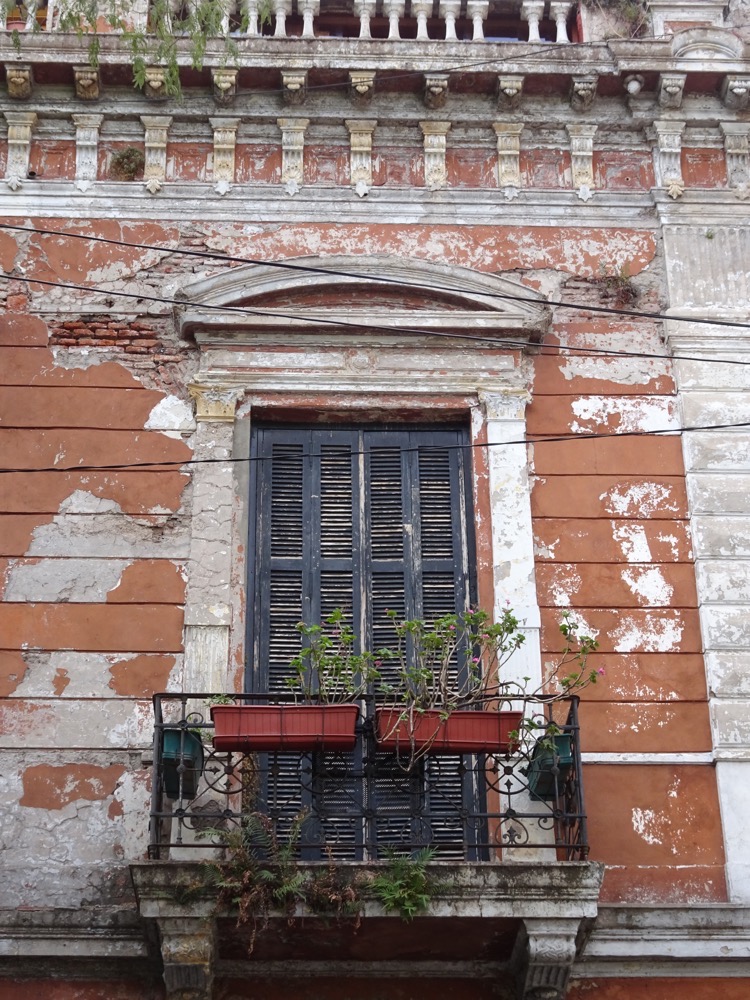 The streets on the way to Casa Rosada – the famous Presidential Palace, were increasingly congested with all the protesting that was going on. The Casa Rosada was so busy and surrounded by so much construction, clumps of cruise ship tourists, traffic and chaos that I have stolen… err appropriated, a pic from Wikipedia to include here so you can actually see (and so that I will be able to remember) what the building it is supposed to look like!
The streets on the way to Casa Rosada – the famous Presidential Palace, were increasingly congested with all the protesting that was going on. The Casa Rosada was so busy and surrounded by so much construction, clumps of cruise ship tourists, traffic and chaos that I have stolen… err appropriated, a pic from Wikipedia to include here so you can actually see (and so that I will be able to remember) what the building it is supposed to look like!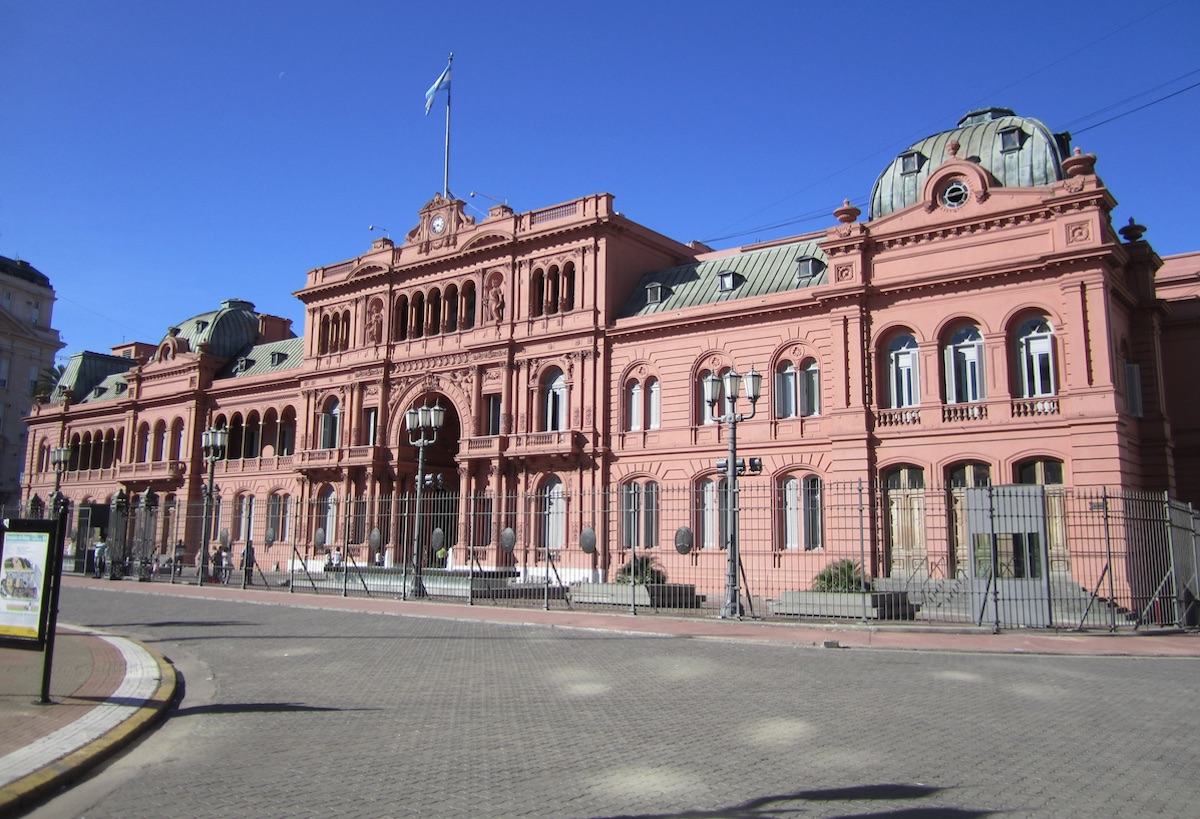 We sat on some steps opposite the Palace and had a discussion about the building, and rebuilding of the Palace over the years, the state of Argentinian politics, and discussed some of the different approaches that Argentina vs Australia take to global problems. For example on immigration – Argentina is seeing a lot of Venezuelan immigrants at the moment as a result of instability in that region and rather than take those refugees and ship them offshore to detention hellholes, the Argentinan government is expediting visas and citizenships for these people primarily because they bring skills and abilities to the country, but there’s an added benefit that it is apparently pissing off the Venezuelan government to no end.
We sat on some steps opposite the Palace and had a discussion about the building, and rebuilding of the Palace over the years, the state of Argentinian politics, and discussed some of the different approaches that Argentina vs Australia take to global problems. For example on immigration – Argentina is seeing a lot of Venezuelan immigrants at the moment as a result of instability in that region and rather than take those refugees and ship them offshore to detention hellholes, the Argentinan government is expediting visas and citizenships for these people primarily because they bring skills and abilities to the country, but there’s an added benefit that it is apparently pissing off the Venezuelan government to no end.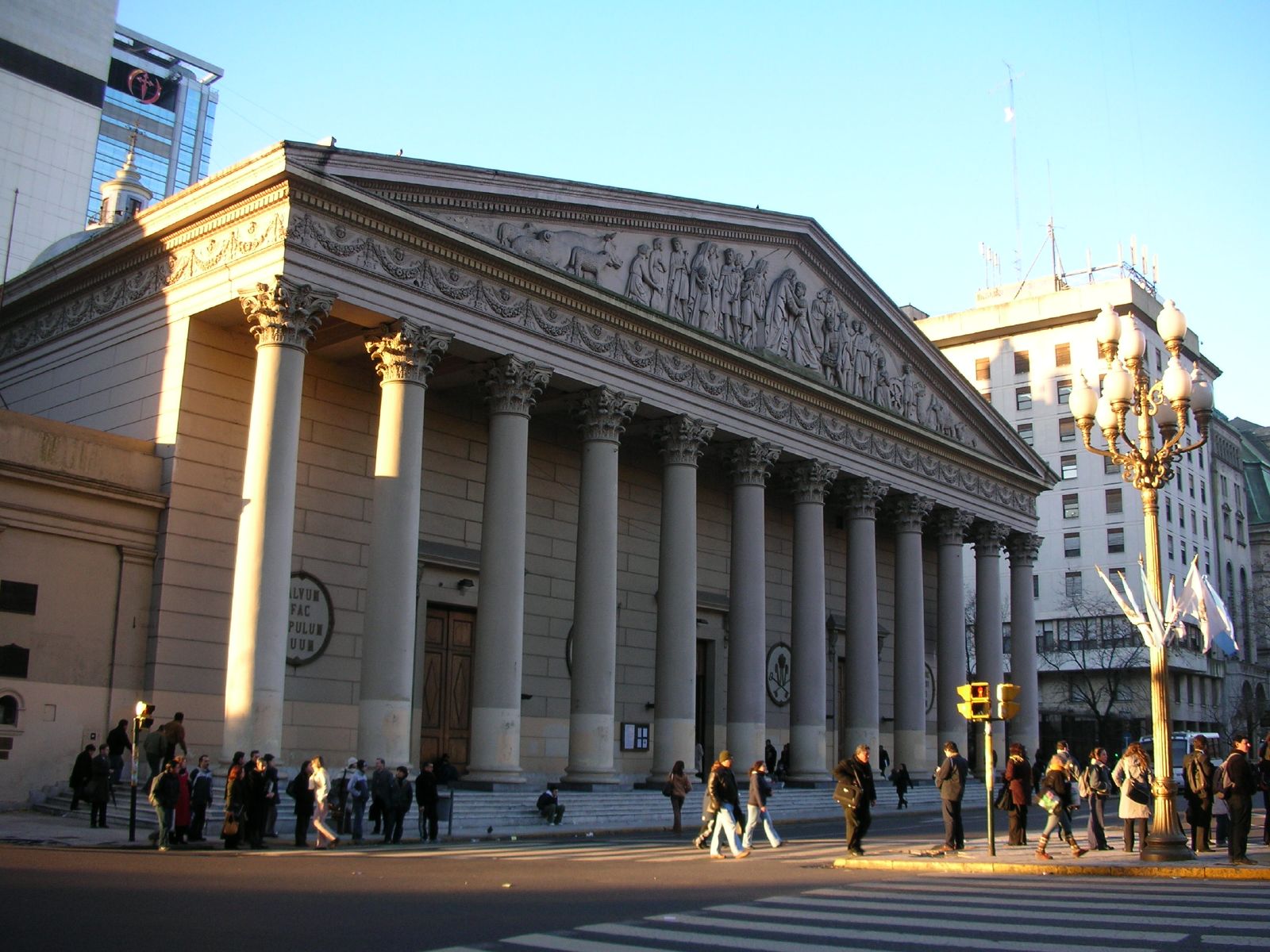
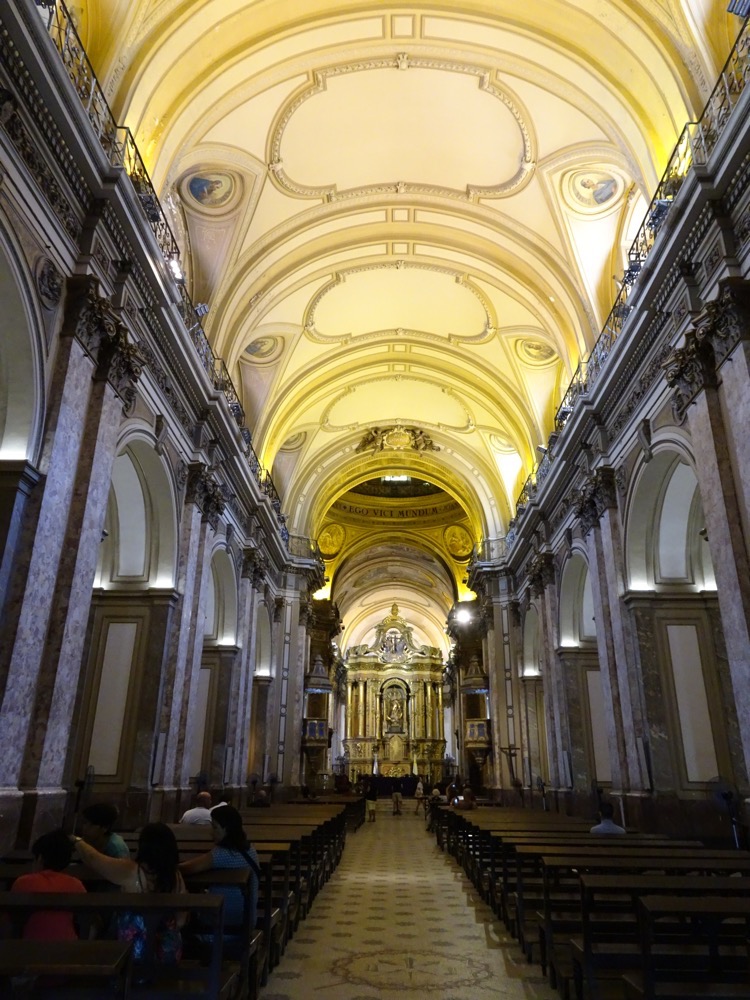
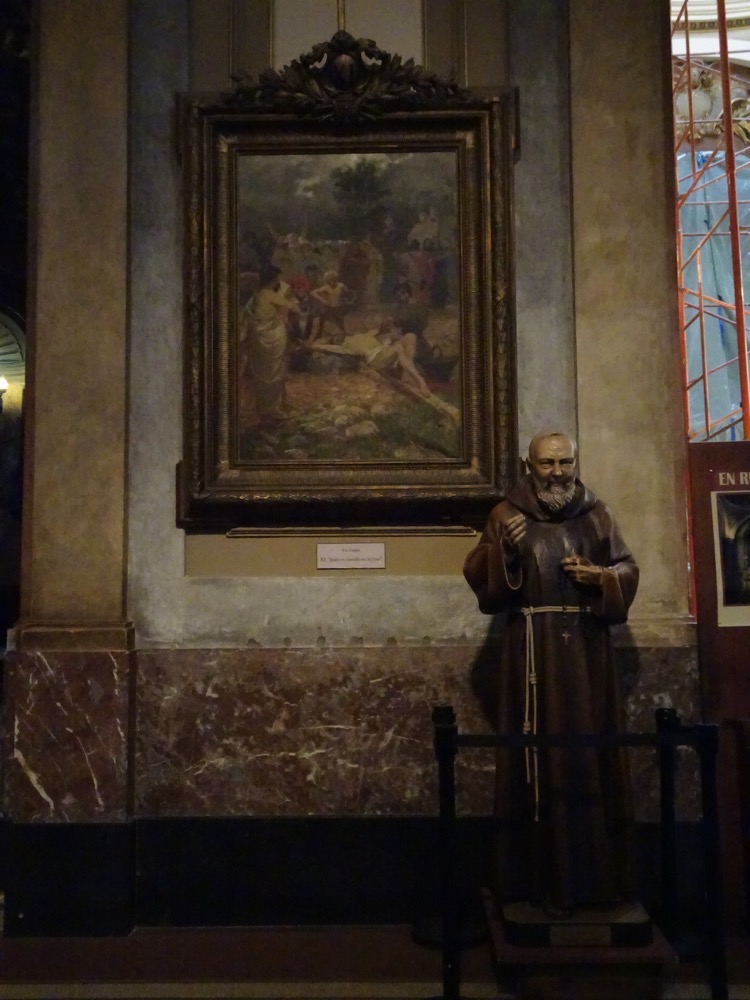
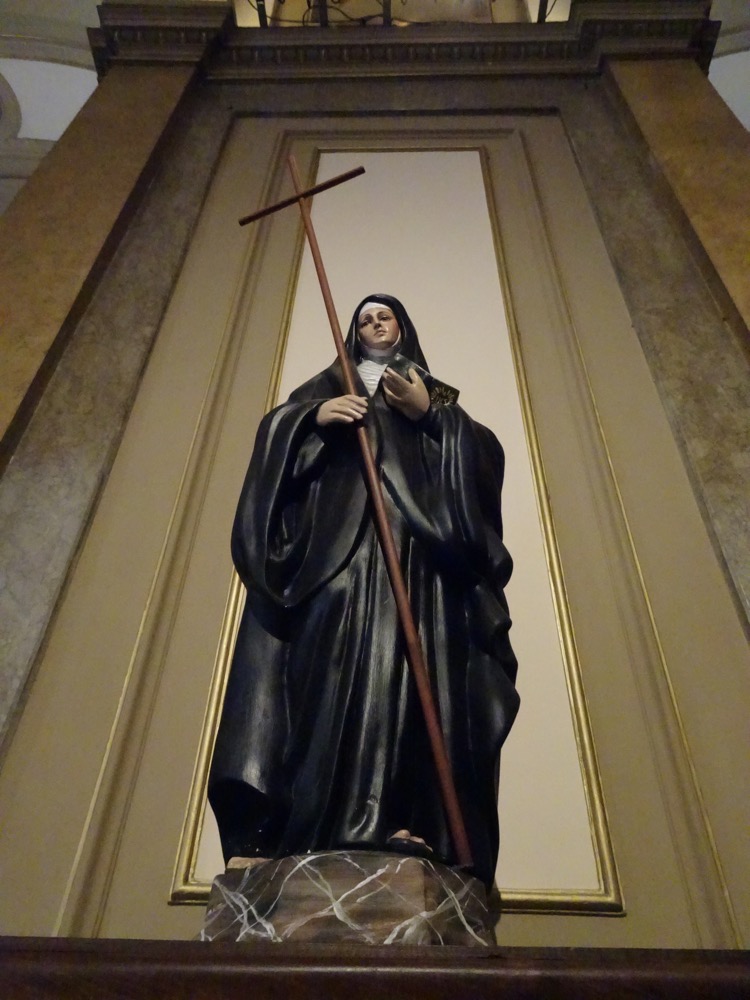
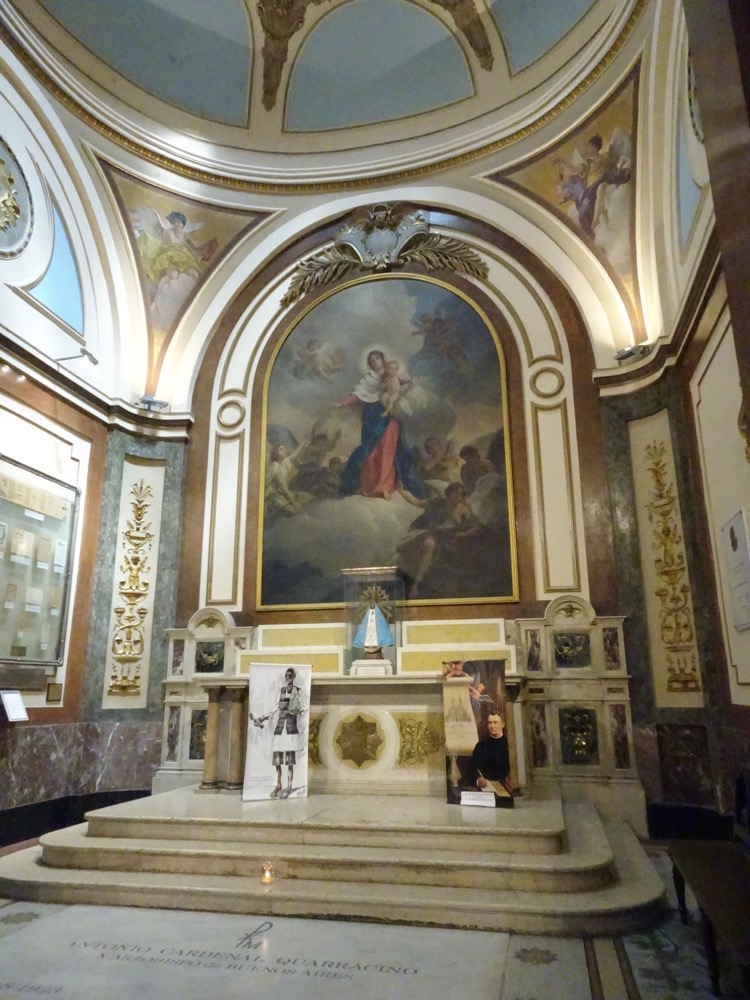 The Cathedral fronts directly onto the Plaza del Mayo which is a large open space often used for protesting… most notably it is the site where the ‘Mothers of the Plaza de Mayo’ congregate every Thursday as they have done since the mid-1980s. The Mothers of the Plaza de Mayo have been turning up protesting that they do not know what has happened to their children and the tens of thousands of people who were ‘disappeared’ between 1976 and 1983. At that time, anyone who protested against the dictatorial government would find themselves ‘disappeared’. Protesting was outlawed and protestors were kidnapped, tortured and murdered (apparently a favoured way to get rid of political dissidents was to torture them and then to fly them over the River Plata and throw them out of planes) This state-run terrorism campaign of the military dictatorship operated between 1976 and 1983, which is when the Mothers of the Plaza de Mayo organised and started to protest the disappearance of their children. You see the very Catholic Argentinians adore and respect their mothers above all else and they knew that no Argentinians would stand idle if they saw mothers being beaten and subdued in the streets. So the government just had to let them alone… and while protesting is now completely legal, the Mothers have refused to be silent and they continue to protest nearly 40 years on.
The Cathedral fronts directly onto the Plaza del Mayo which is a large open space often used for protesting… most notably it is the site where the ‘Mothers of the Plaza de Mayo’ congregate every Thursday as they have done since the mid-1980s. The Mothers of the Plaza de Mayo have been turning up protesting that they do not know what has happened to their children and the tens of thousands of people who were ‘disappeared’ between 1976 and 1983. At that time, anyone who protested against the dictatorial government would find themselves ‘disappeared’. Protesting was outlawed and protestors were kidnapped, tortured and murdered (apparently a favoured way to get rid of political dissidents was to torture them and then to fly them over the River Plata and throw them out of planes) This state-run terrorism campaign of the military dictatorship operated between 1976 and 1983, which is when the Mothers of the Plaza de Mayo organised and started to protest the disappearance of their children. You see the very Catholic Argentinians adore and respect their mothers above all else and they knew that no Argentinians would stand idle if they saw mothers being beaten and subdued in the streets. So the government just had to let them alone… and while protesting is now completely legal, the Mothers have refused to be silent and they continue to protest nearly 40 years on.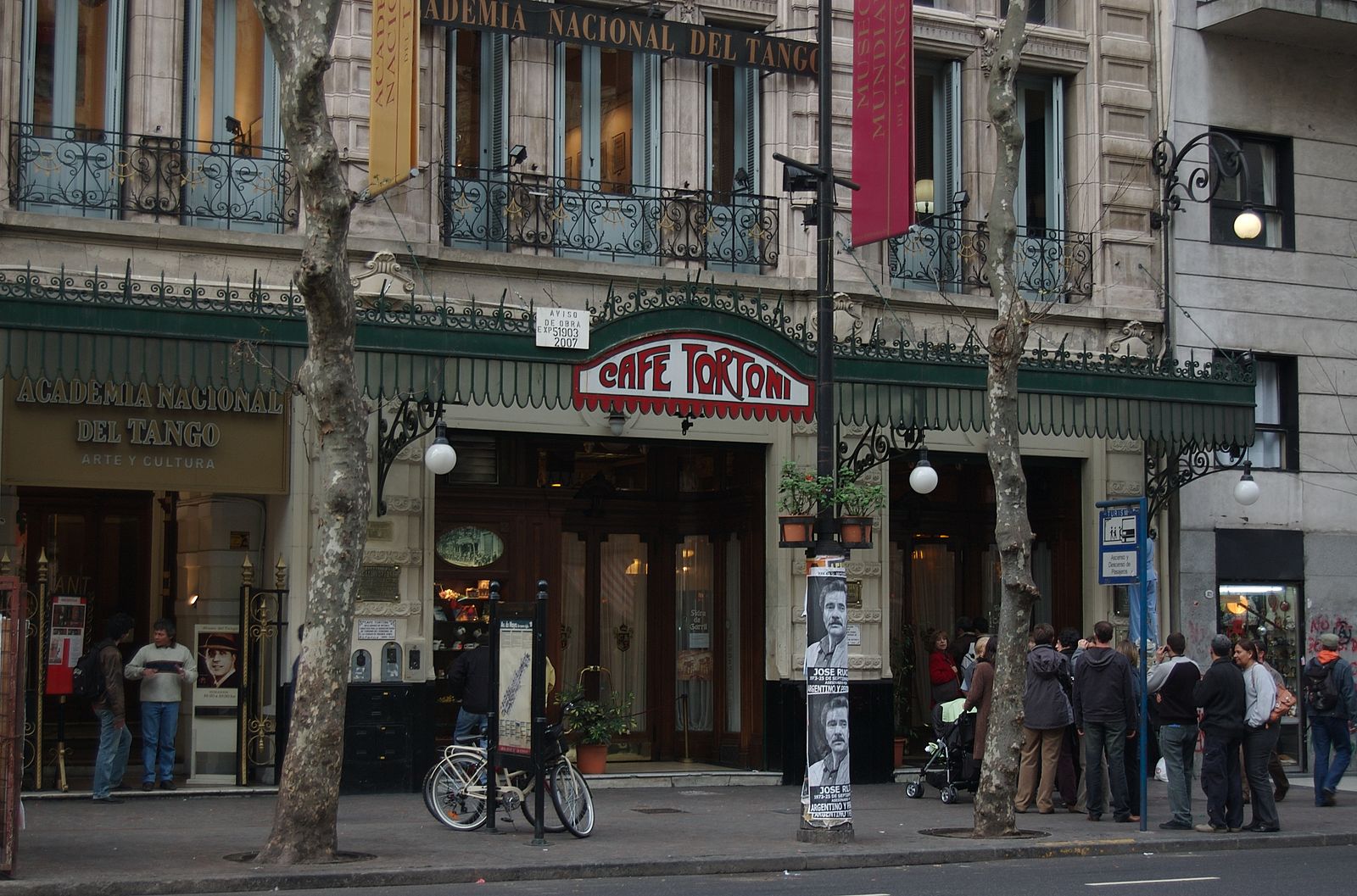
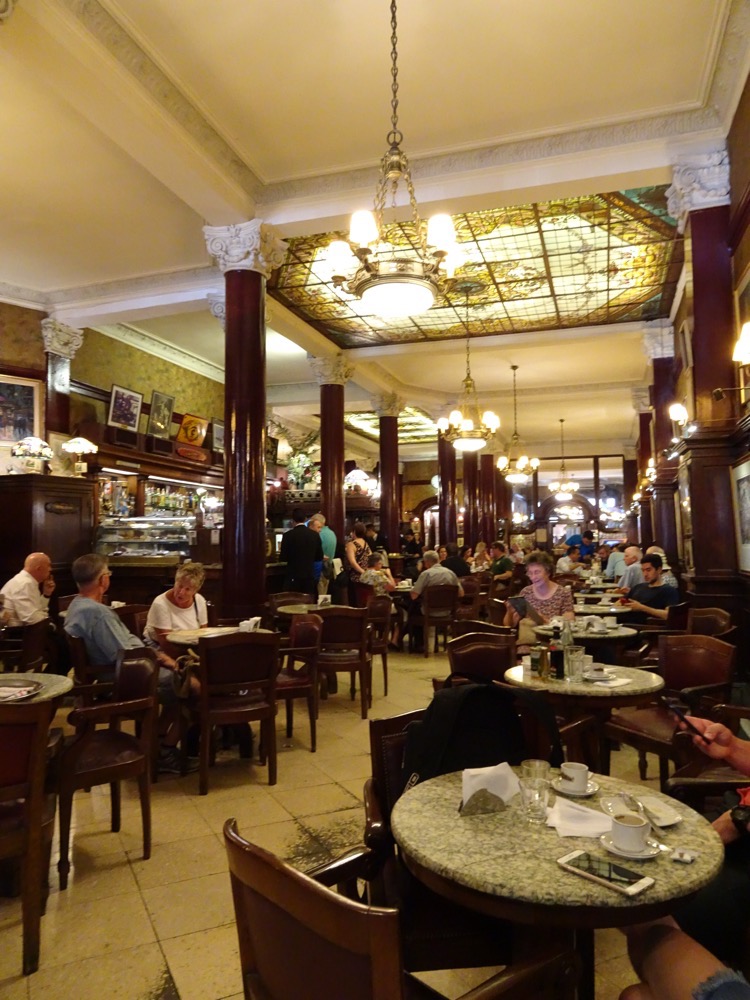 We stepped out of the cafe and ran smack bang into… wouldn’t you know it, a workers union protest. It was at this point I asked Ceri if all this political engagement and protesting ever brought about tangible change to which he replied, ‘Not really, but now they have their right to protest back, they’re intent on using it.’
We stepped out of the cafe and ran smack bang into… wouldn’t you know it, a workers union protest. It was at this point I asked Ceri if all this political engagement and protesting ever brought about tangible change to which he replied, ‘Not really, but now they have their right to protest back, they’re intent on using it.’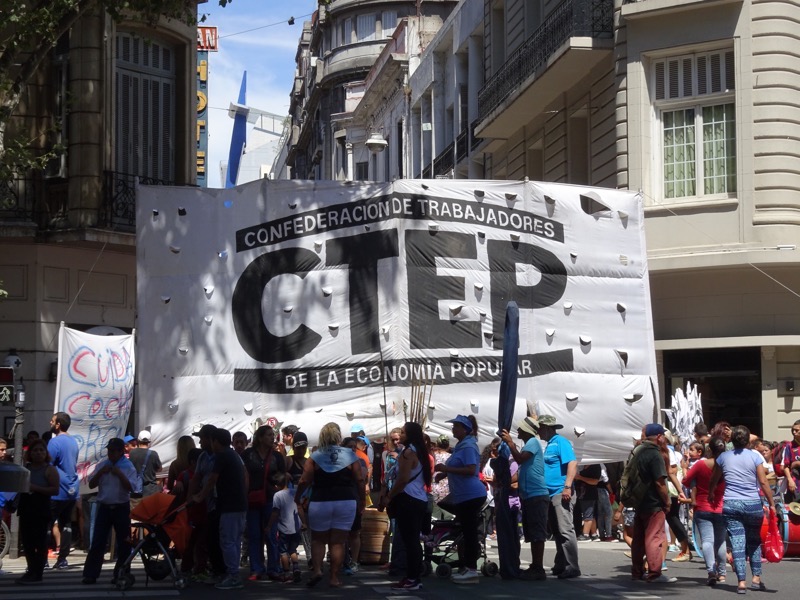 From here we made our way to 9 July Avenue where one of the famous Evita balconies is located as well as an enormous 70m obelisk. The Obelisco de Buenos Aires was erected in the Plaza de la República on 9 de Julio in 1936 to commemorate the quadricentennial of the foundation of the city. It’s quite a striking monument – you can’t miss it!
From here we made our way to 9 July Avenue where one of the famous Evita balconies is located as well as an enormous 70m obelisk. The Obelisco de Buenos Aires was erected in the Plaza de la República on 9 de Julio in 1936 to commemorate the quadricentennial of the foundation of the city. It’s quite a striking monument – you can’t miss it!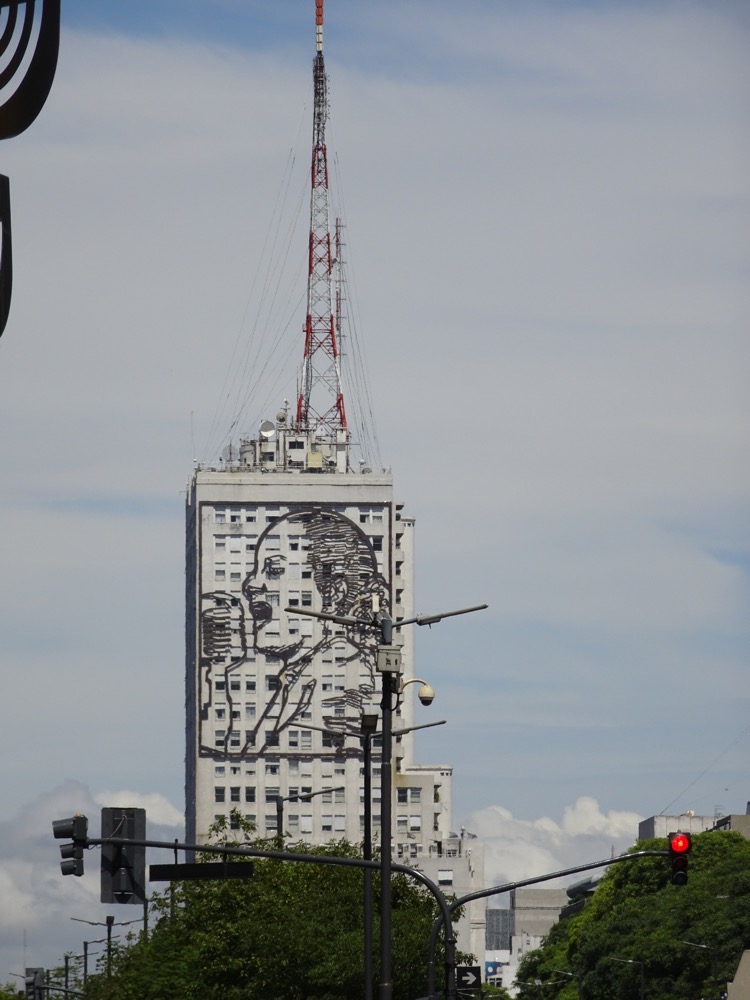
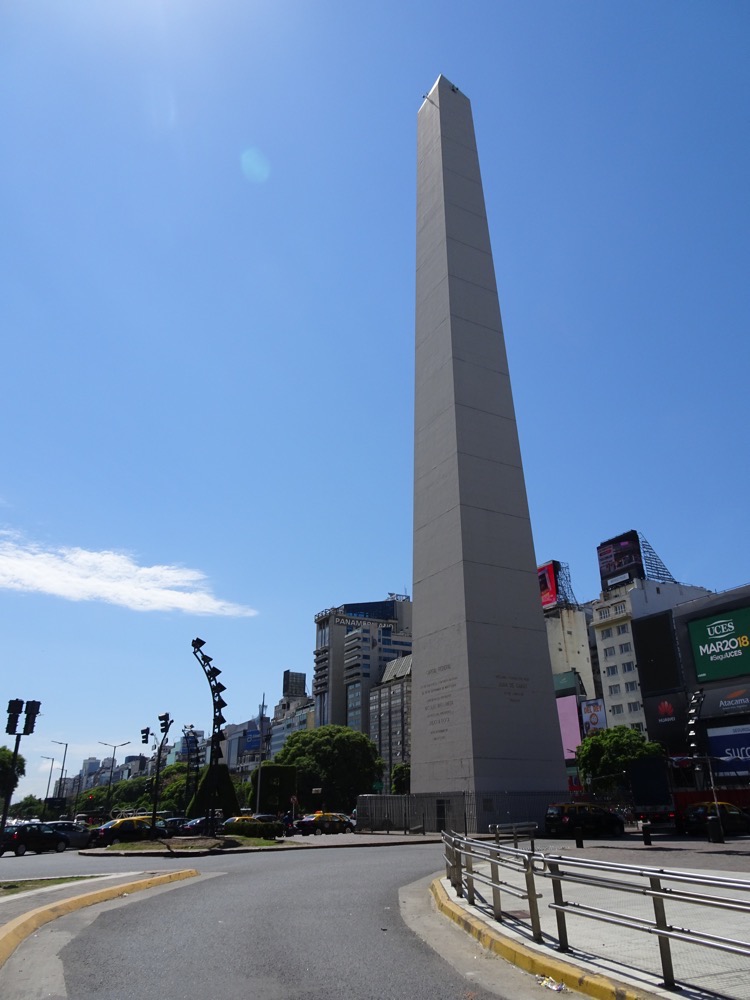
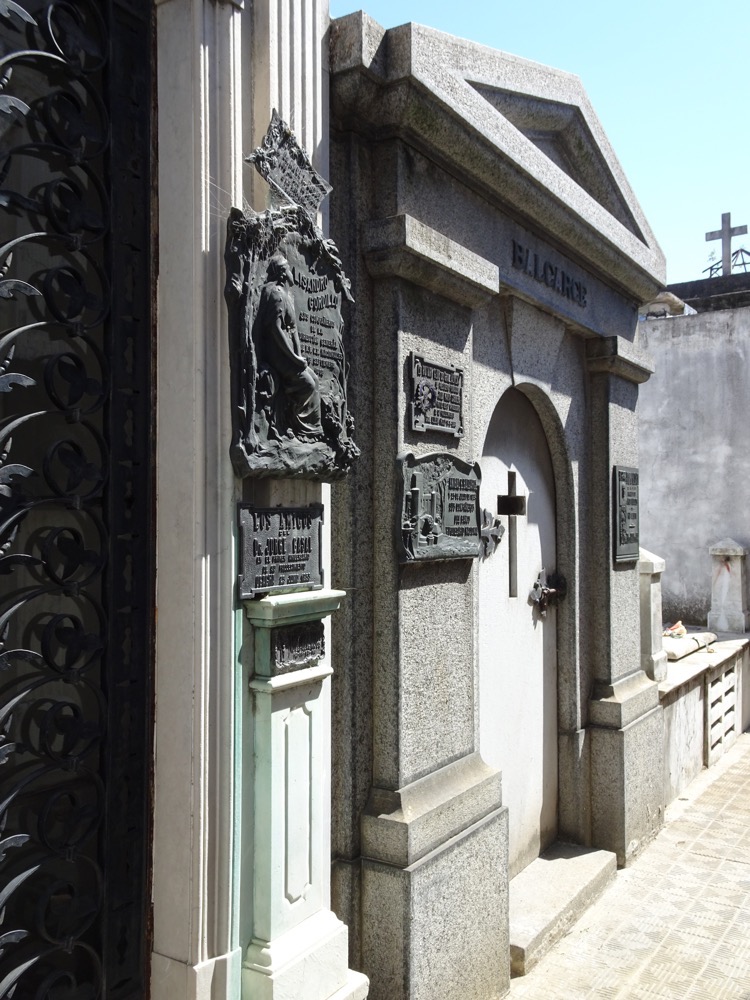 The large walled cemetery is similar to one we saw in Punta Arenas in Chile last year, but quite five times the size, and quite ten times as ostentatious in its display of wealth and status. The mausoleums are enormous, and all the materials and workmanship would have been imported from Europe.
The large walled cemetery is similar to one we saw in Punta Arenas in Chile last year, but quite five times the size, and quite ten times as ostentatious in its display of wealth and status. The mausoleums are enormous, and all the materials and workmanship would have been imported from Europe.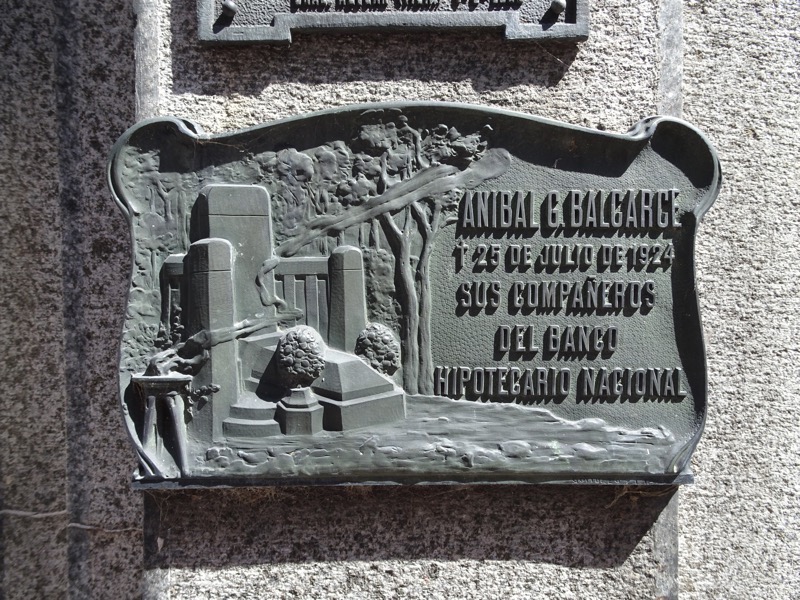
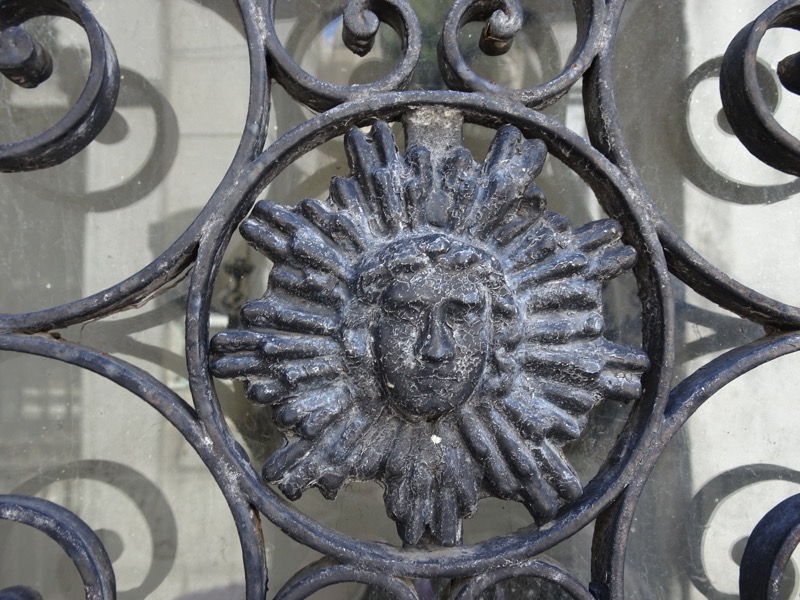
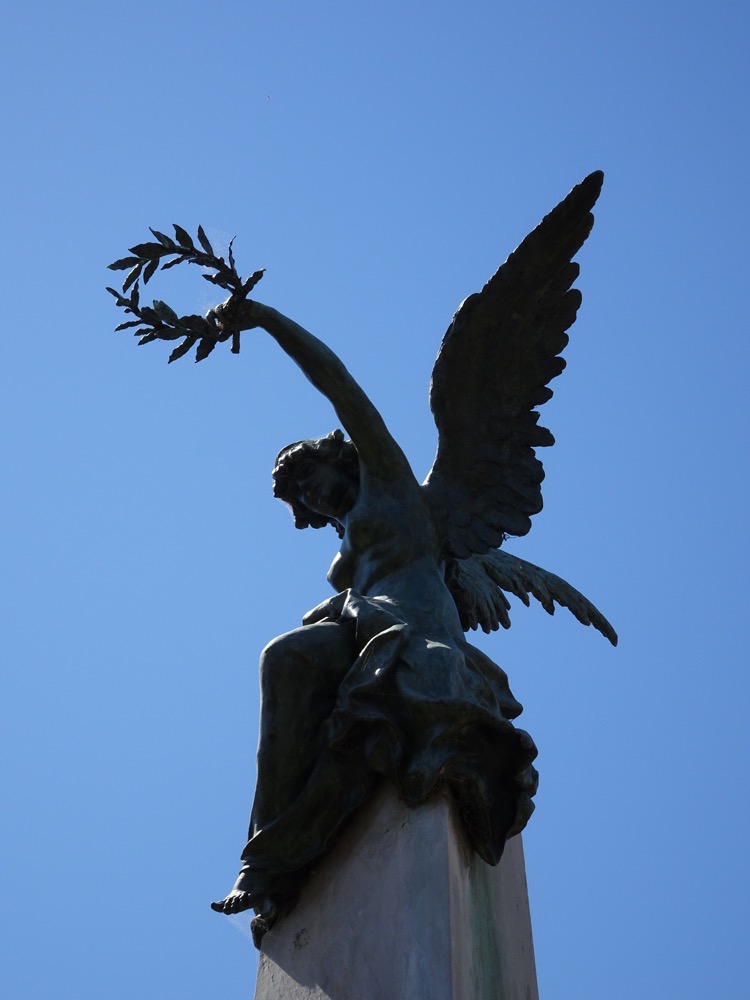
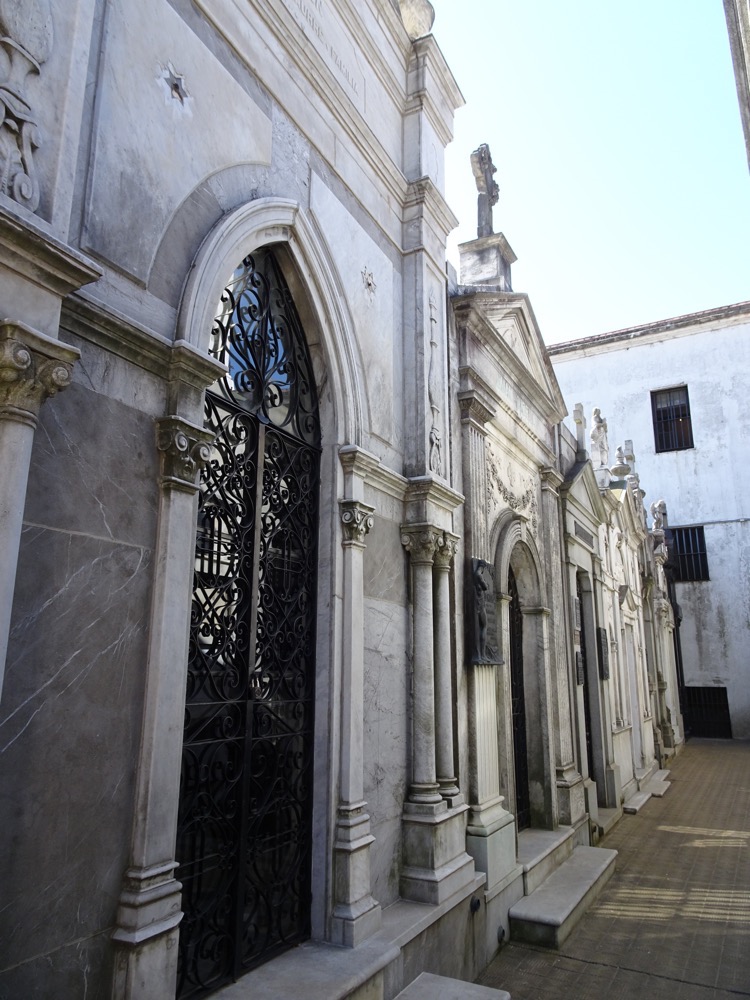
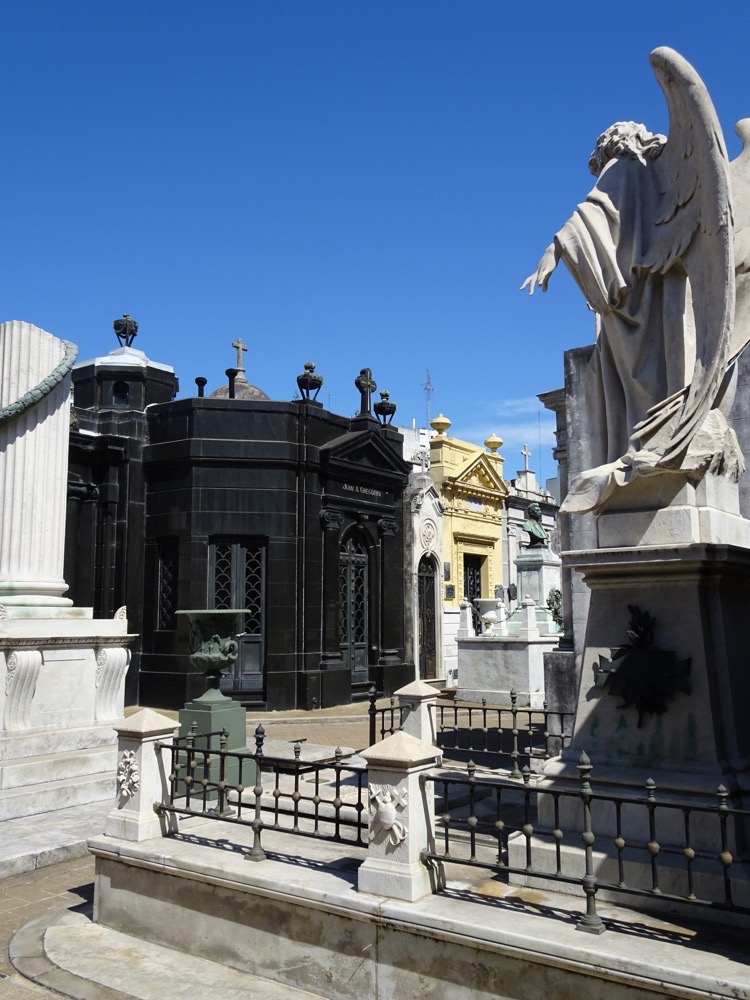 People from many different denominations are buried here. The Argentinians are a very cosmopolitan people having come from everywhere – this appears to have been the result of a dreadful policy that encouraged the slaughter of the indigenous peoples in the past, but has created a society that knows they are all from somewhere else, so they appear to be more tolerant of one another… Ceri claims the Argentines ‘are mostly Italian and Irish descent, speaking Spanish, dressing like French and wanting to be British.’
People from many different denominations are buried here. The Argentinians are a very cosmopolitan people having come from everywhere – this appears to have been the result of a dreadful policy that encouraged the slaughter of the indigenous peoples in the past, but has created a society that knows they are all from somewhere else, so they appear to be more tolerant of one another… Ceri claims the Argentines ‘are mostly Italian and Irish descent, speaking Spanish, dressing like French and wanting to be British.’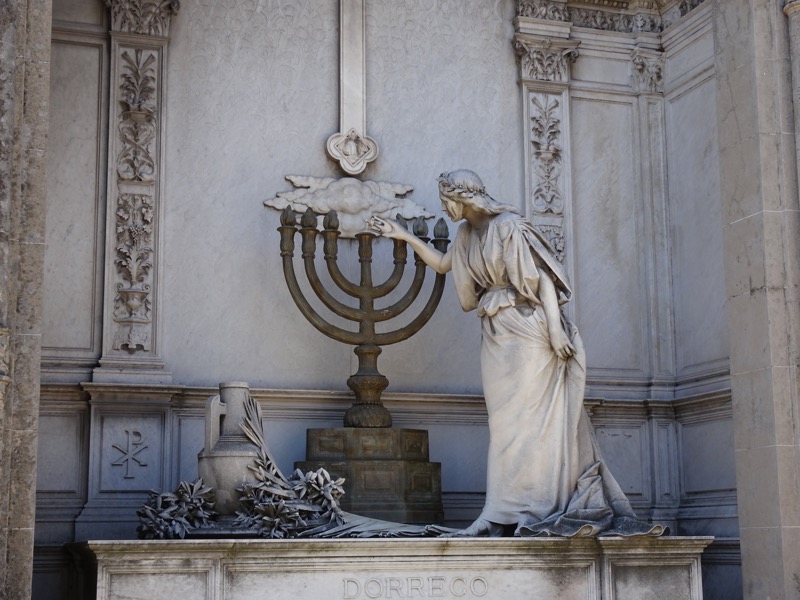
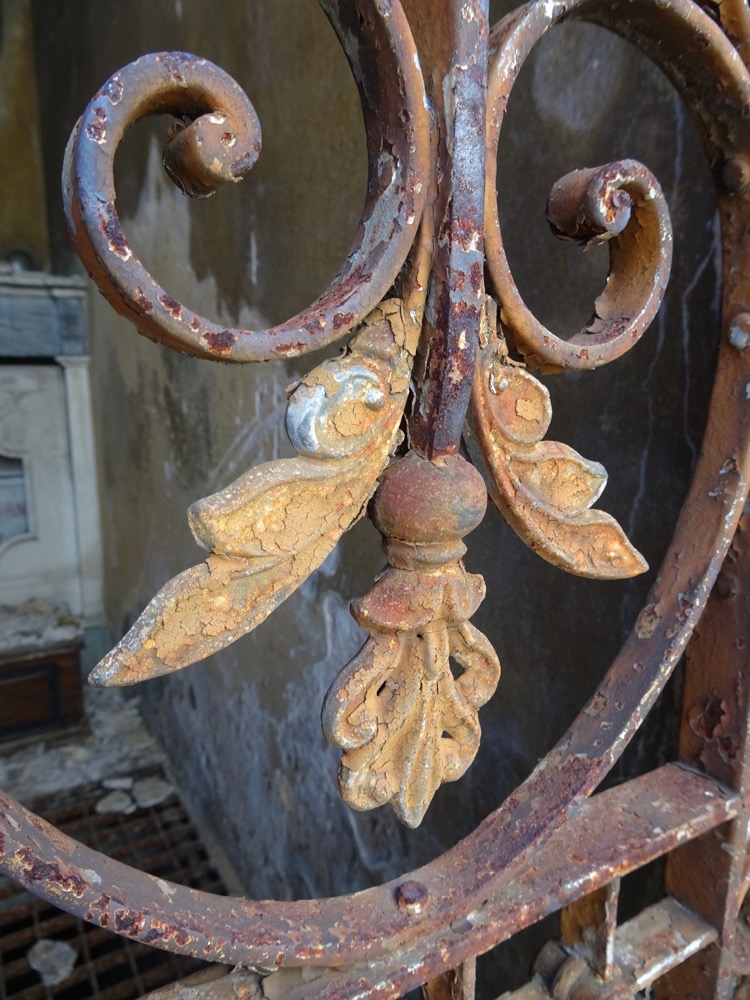 Presidente Alfonsin’s grave site – unlike most of the tombs here, this one is open sided and not locked.
Presidente Alfonsin’s grave site – unlike most of the tombs here, this one is open sided and not locked.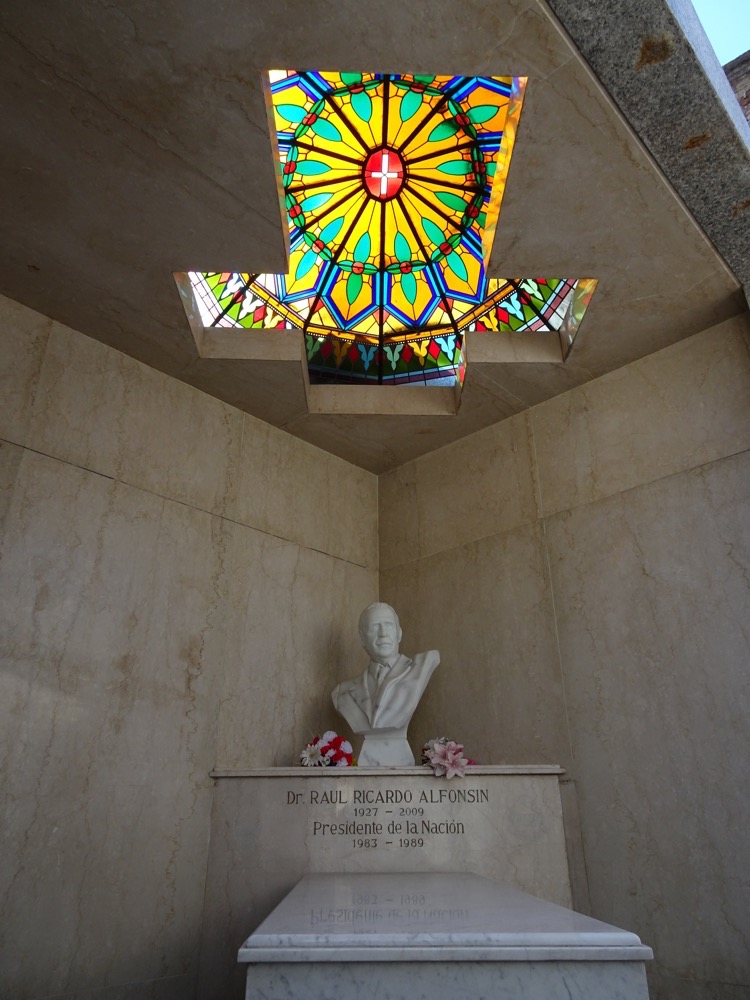
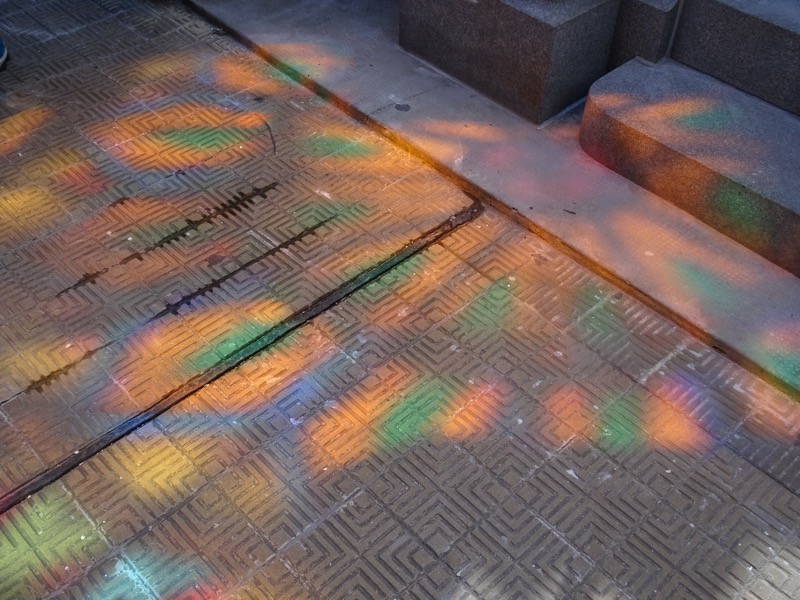
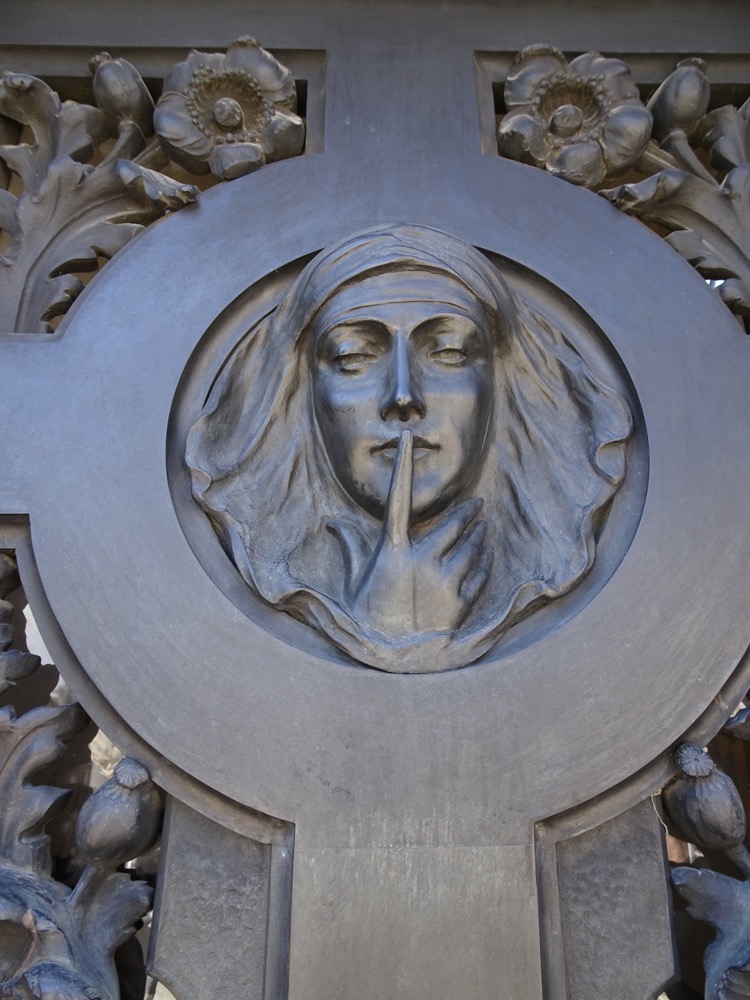
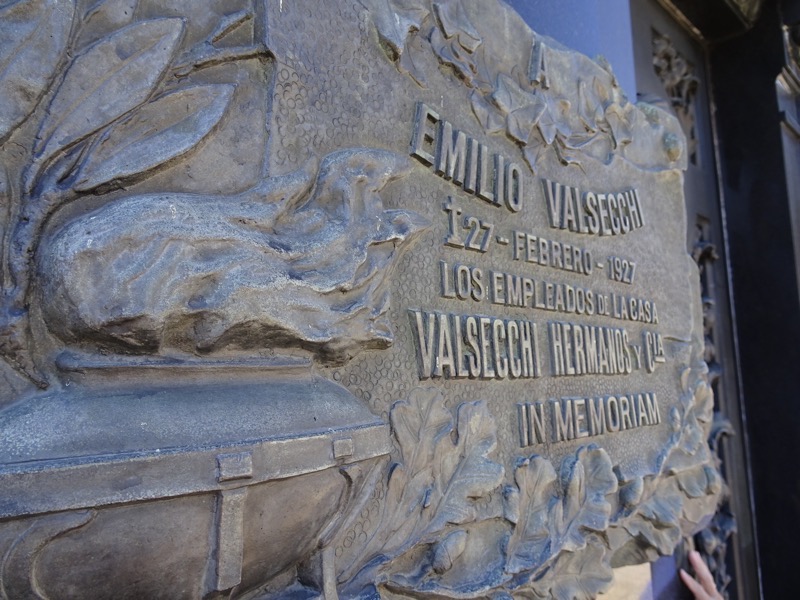 The graves are rich with symbolism – from trees of life, owls of wisdom, anchors of hope and memento mori.
The graves are rich with symbolism – from trees of life, owls of wisdom, anchors of hope and memento mori.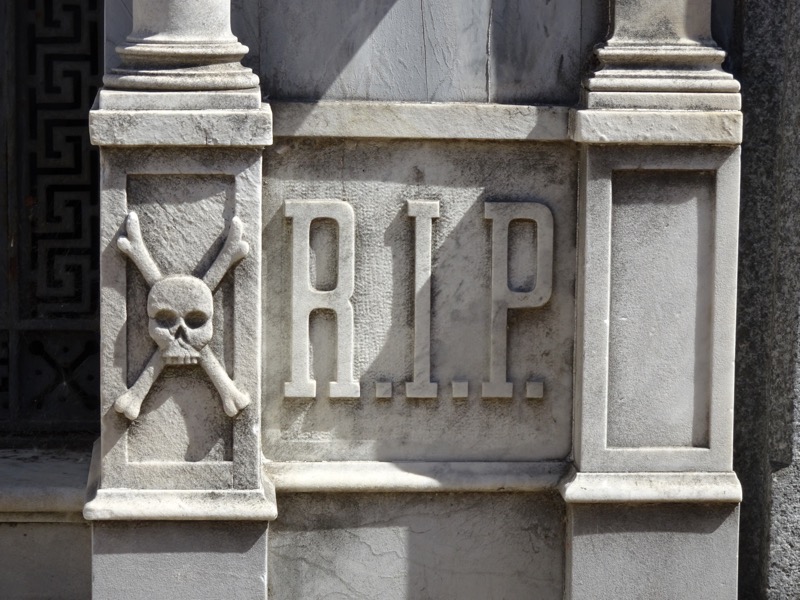
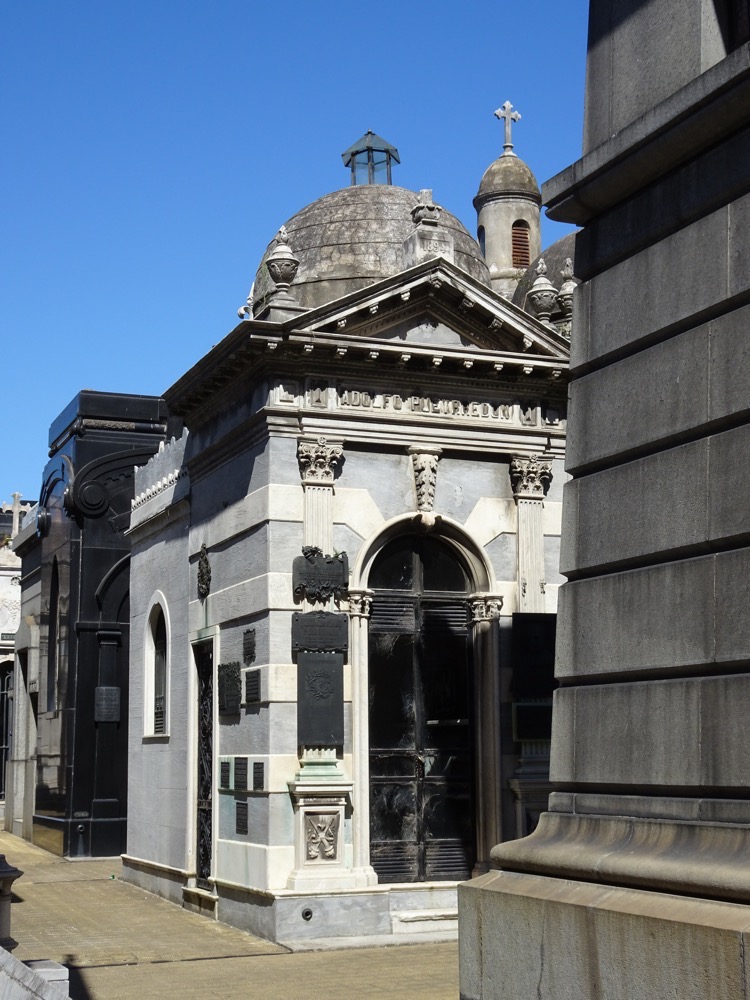 This is a couple who hated each other but who were forced to live out their lives together – Catholics do not divorce – so in death they chose to be buried in the family plot feet pointing towards each other and busts facing away, not side by side as most loving couples would. It’s very honest in its own way.
This is a couple who hated each other but who were forced to live out their lives together – Catholics do not divorce – so in death they chose to be buried in the family plot feet pointing towards each other and busts facing away, not side by side as most loving couples would. It’s very honest in its own way.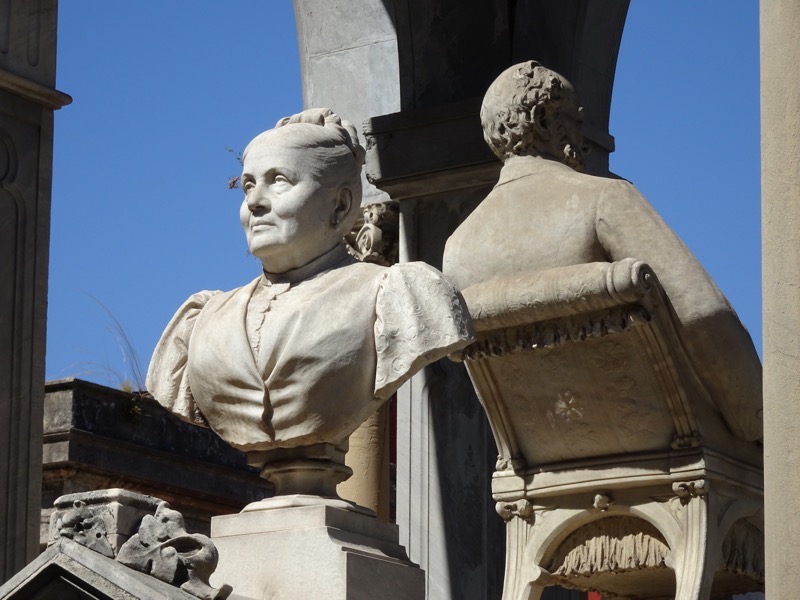
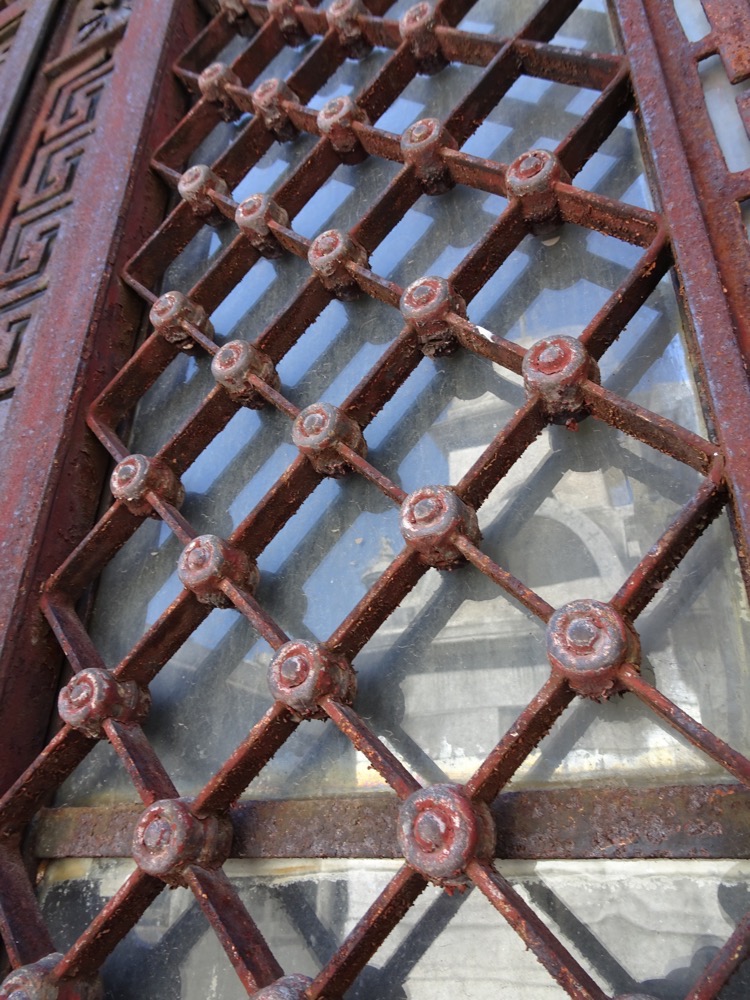
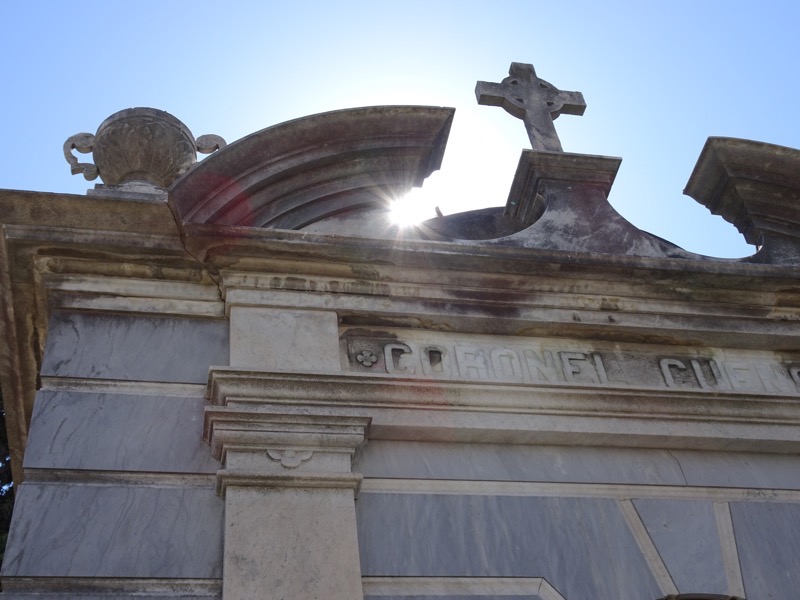
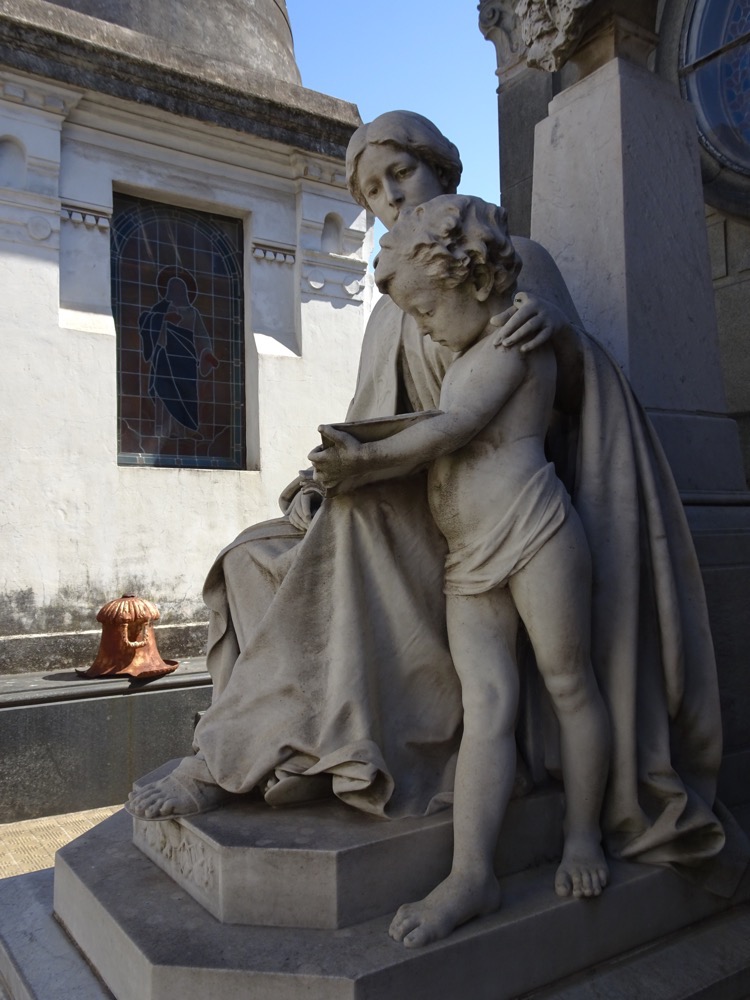
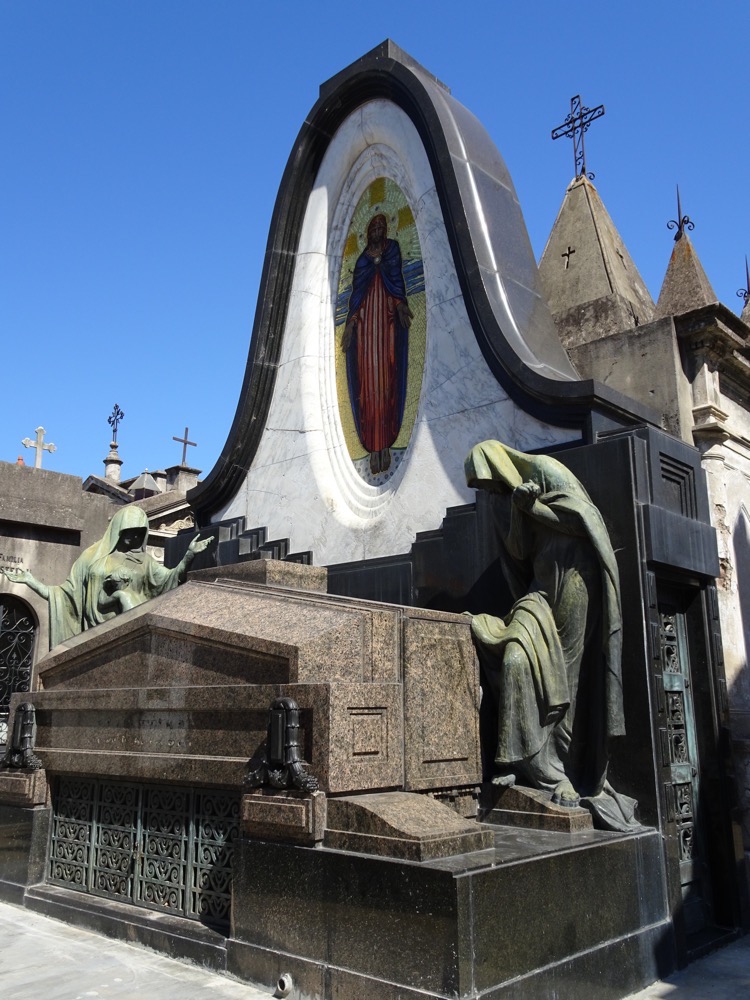
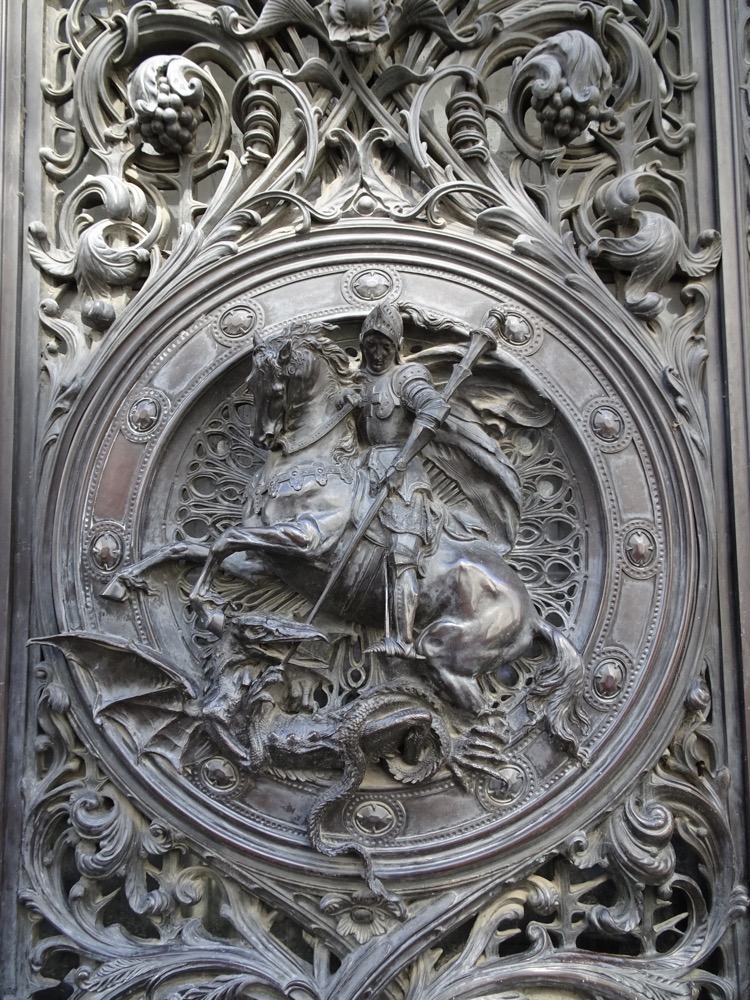
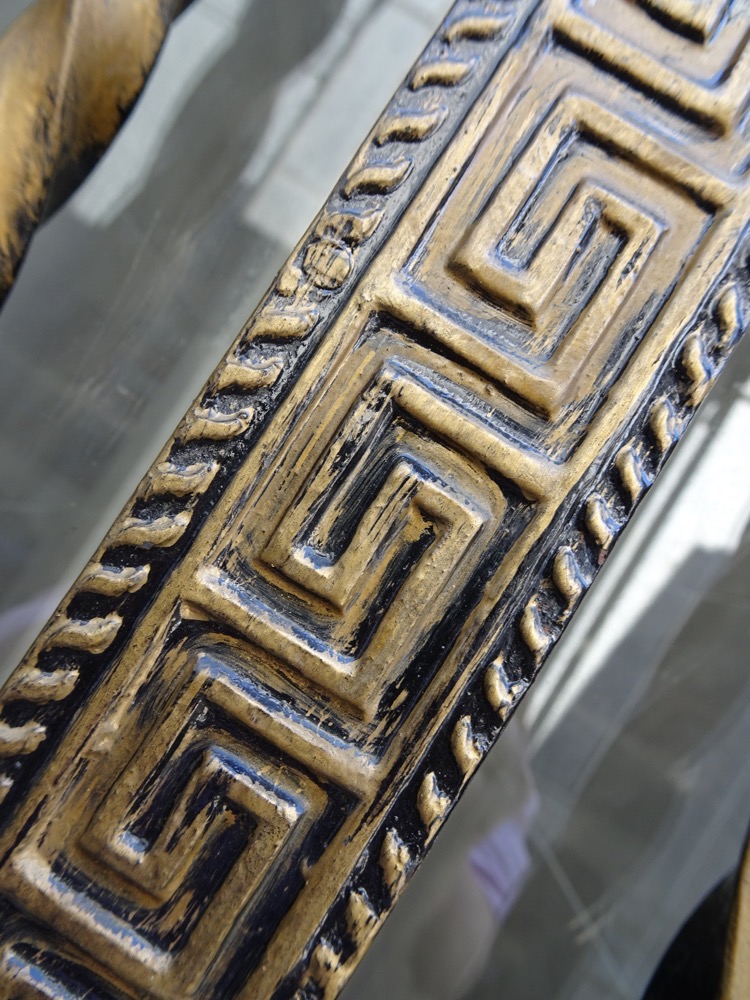 This is a momument to a woman named Ida – a very personal homage from a grieving husband. Ida fell from a building and this statue depicts a woman helping her into the heavens.
This is a momument to a woman named Ida – a very personal homage from a grieving husband. Ida fell from a building and this statue depicts a woman helping her into the heavens.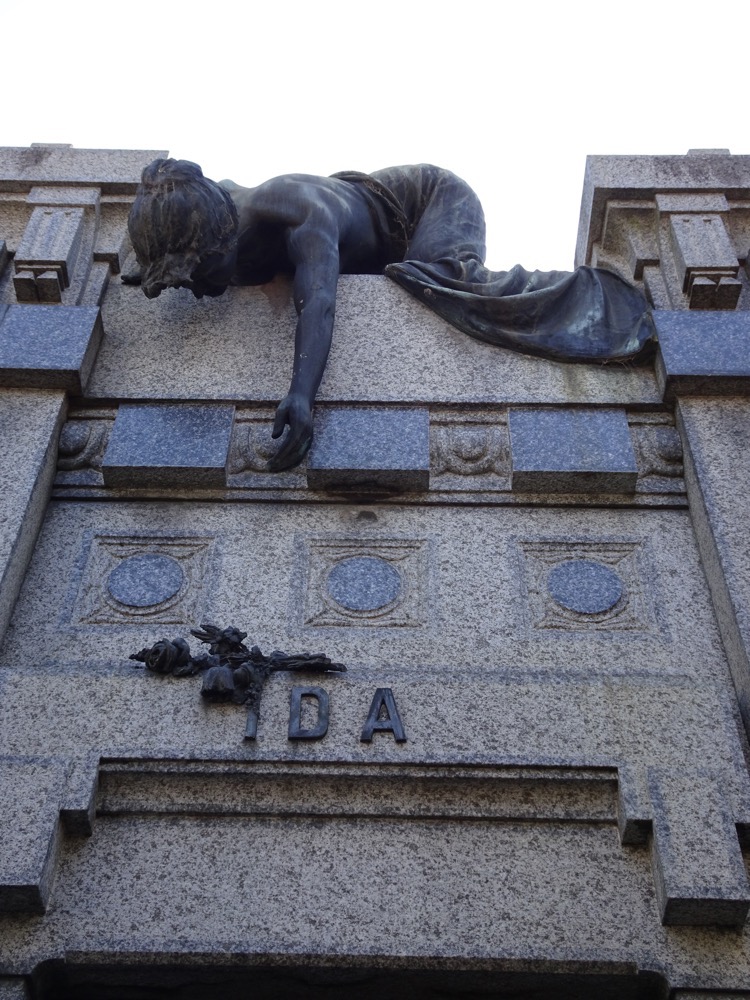 Eva Peron’s grave – the most visited grave in the cemetery. It is the only one covered in flowers and tokens, though compared to many of the other tombs, it is plain, simple and not particularly artistic. Evita was a very divisive figure so it is the only place in the cemetery that is under CCTV surveillance.
Eva Peron’s grave – the most visited grave in the cemetery. It is the only one covered in flowers and tokens, though compared to many of the other tombs, it is plain, simple and not particularly artistic. Evita was a very divisive figure so it is the only place in the cemetery that is under CCTV surveillance.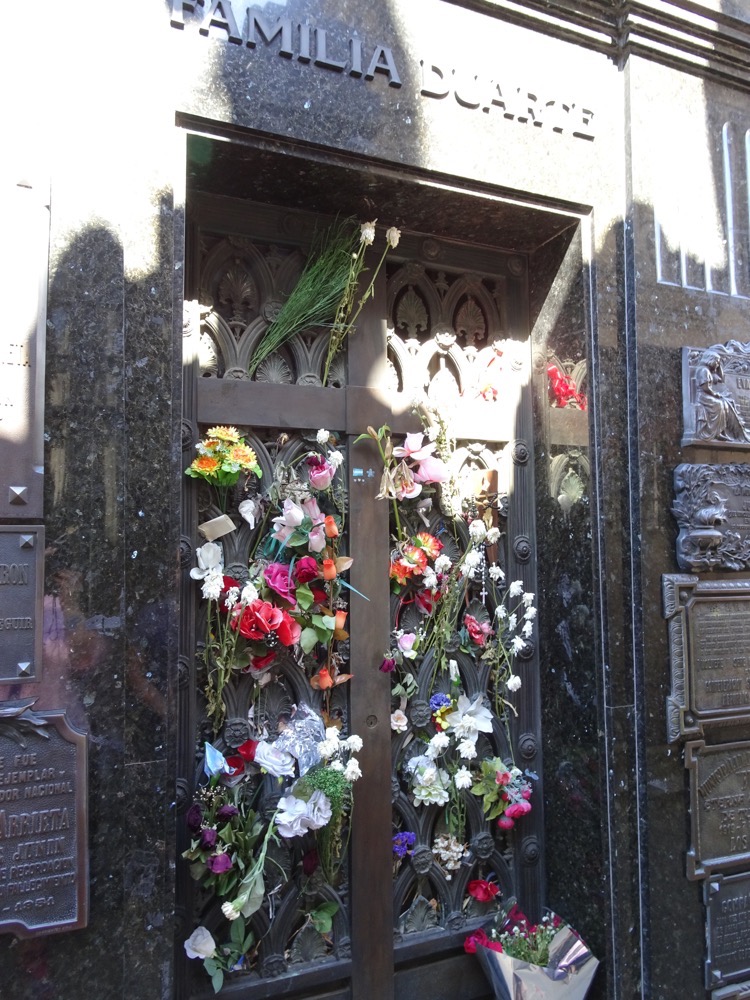
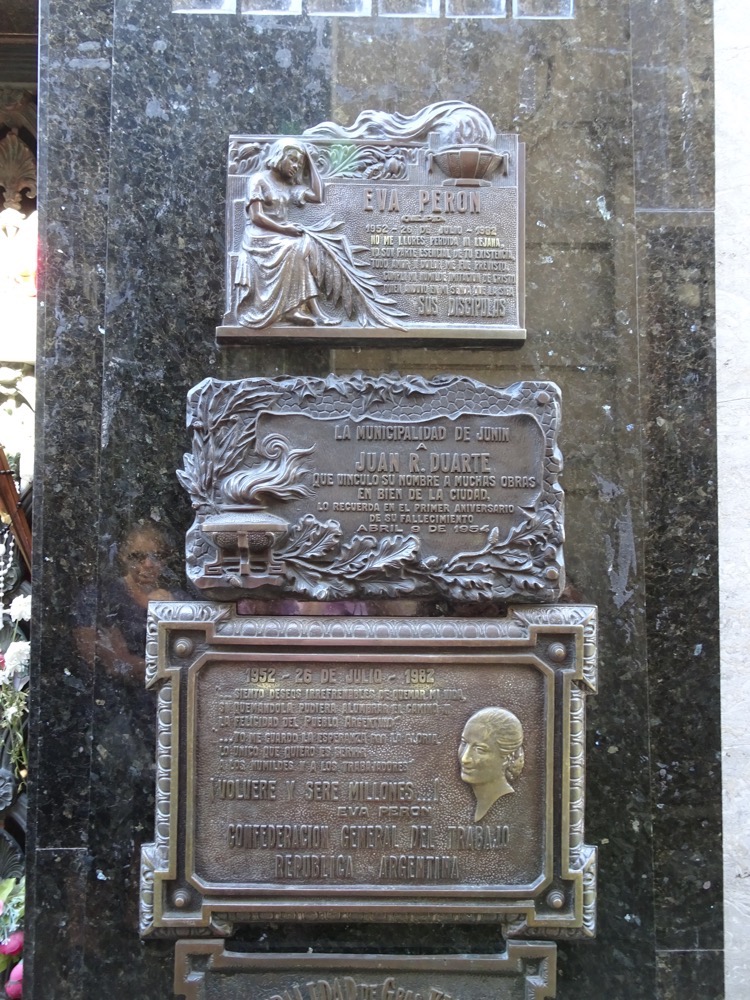
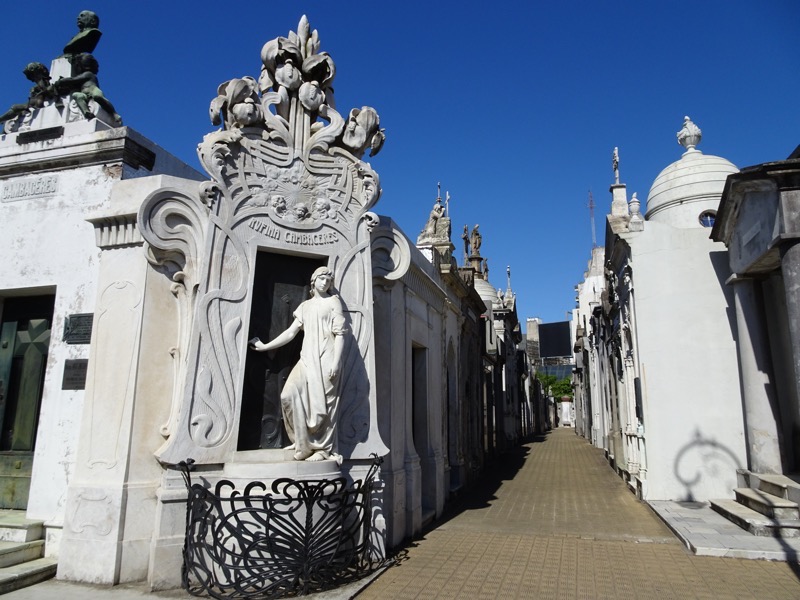
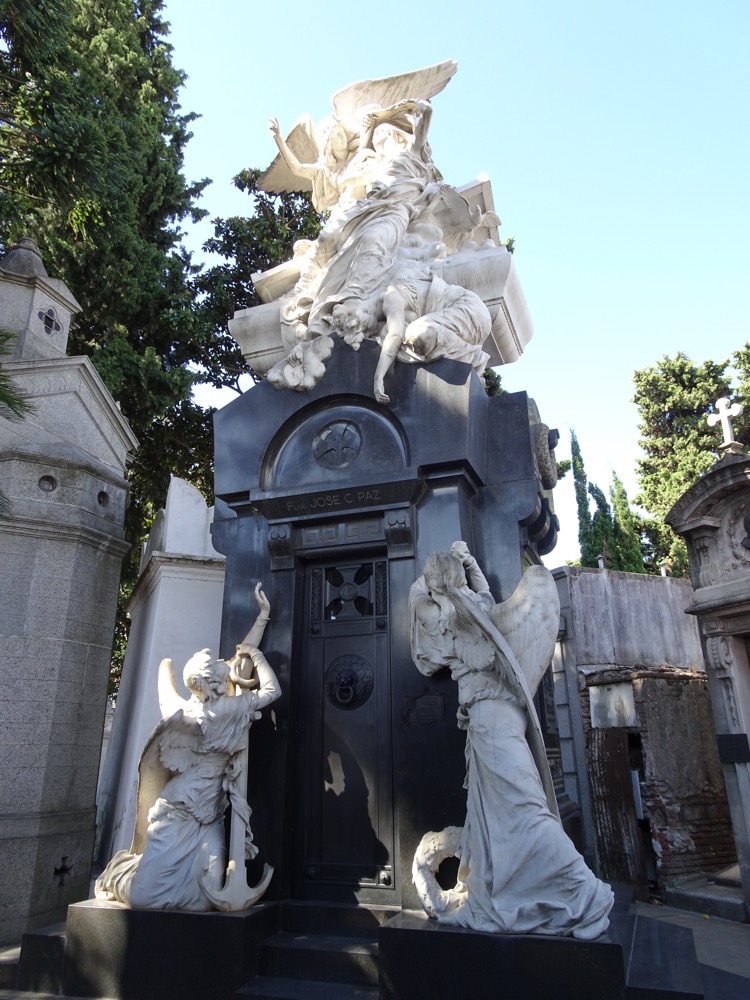
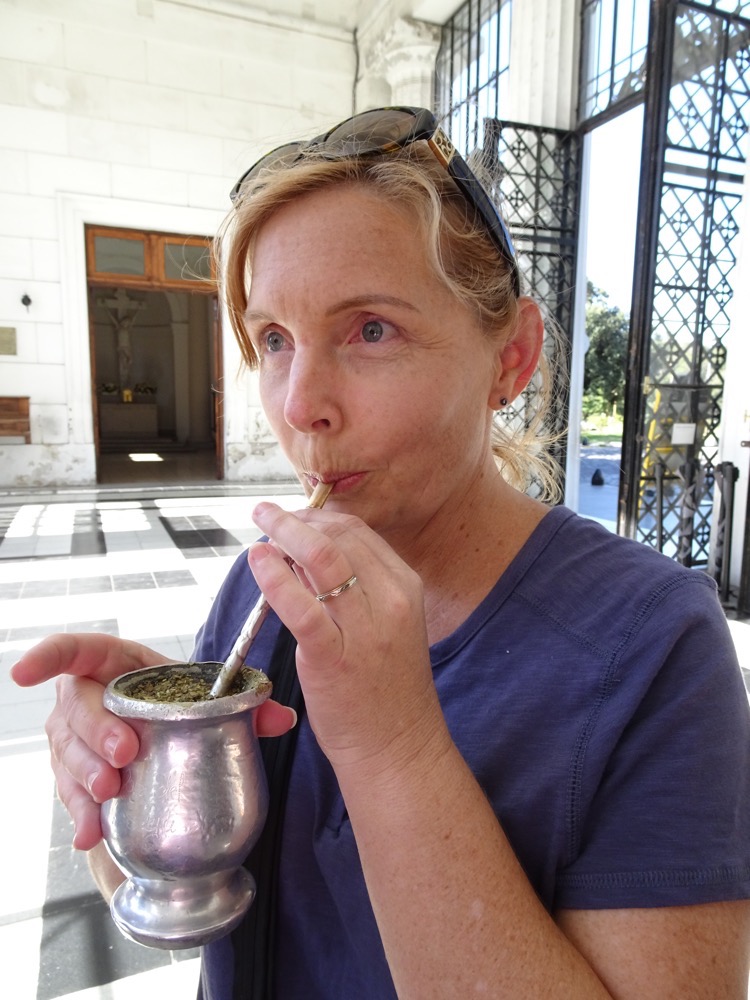
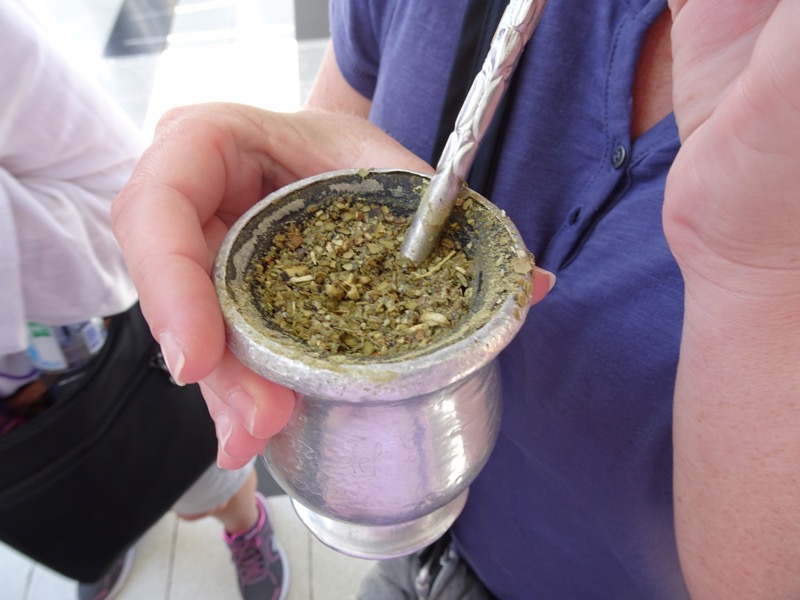
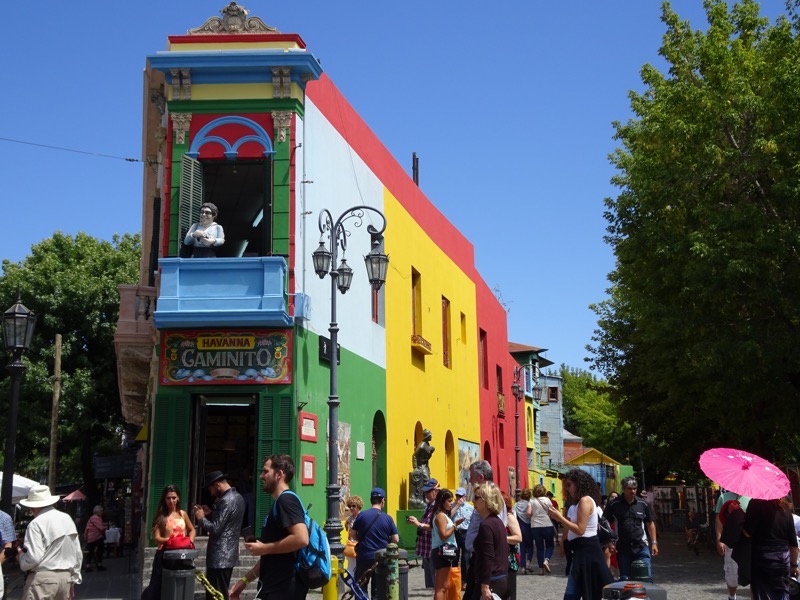
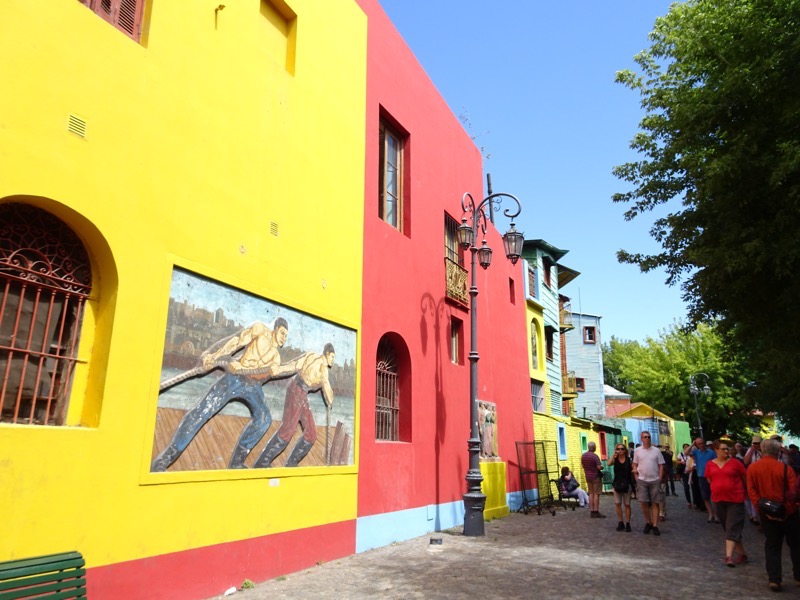
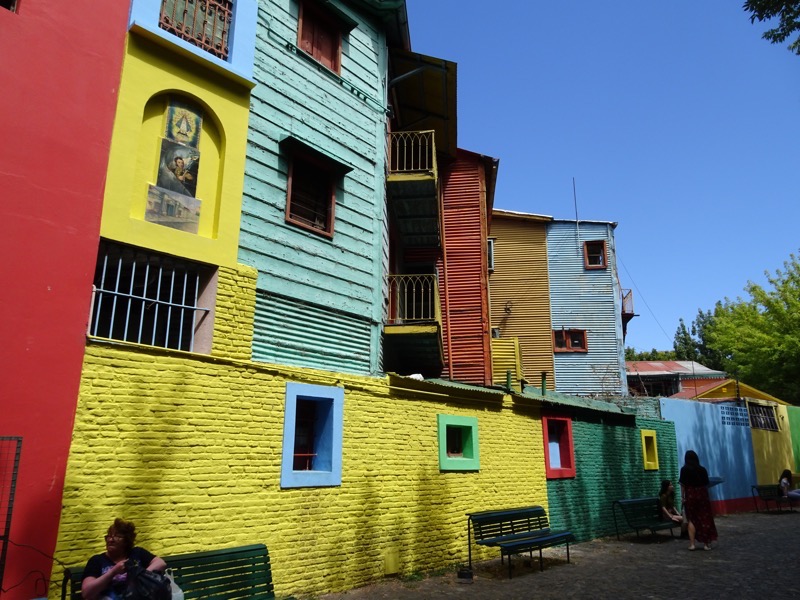
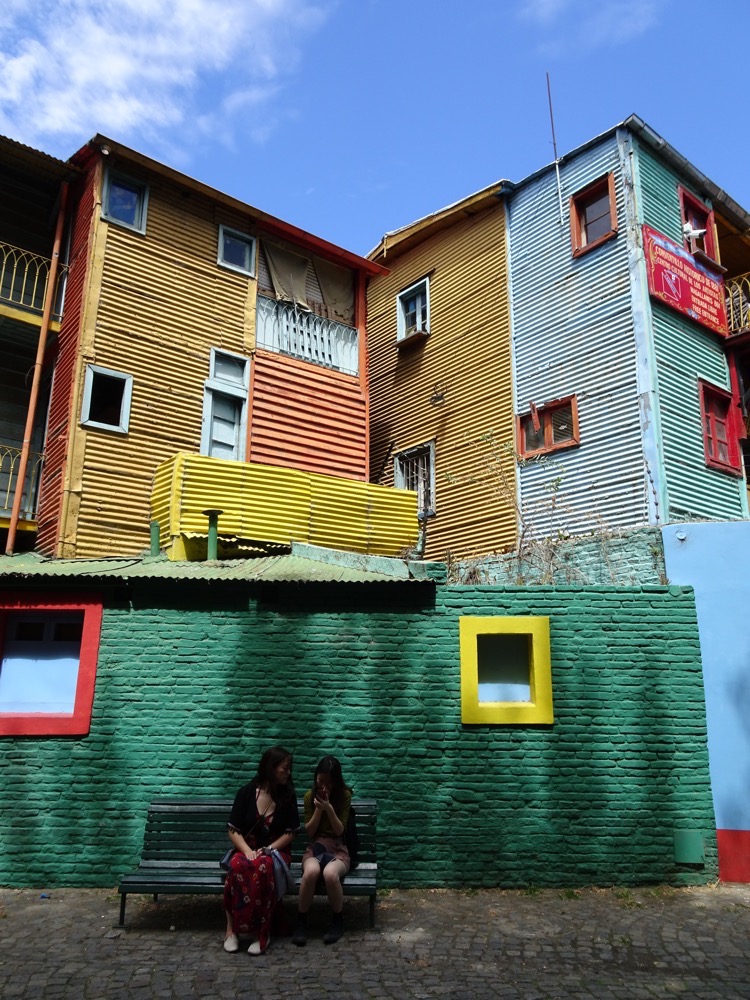
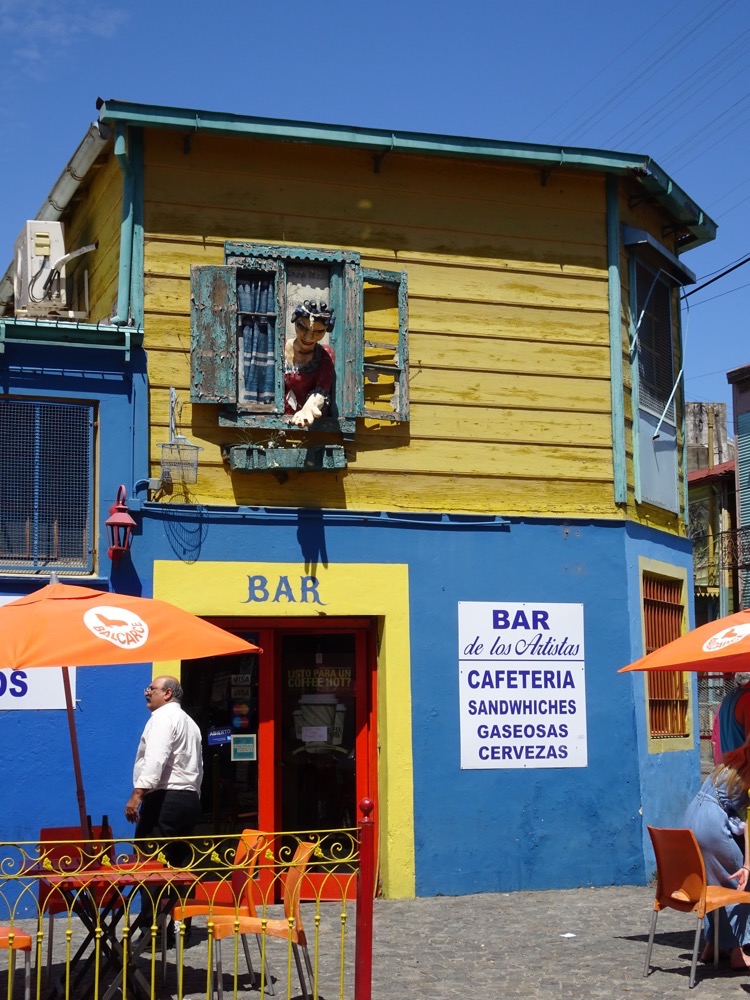
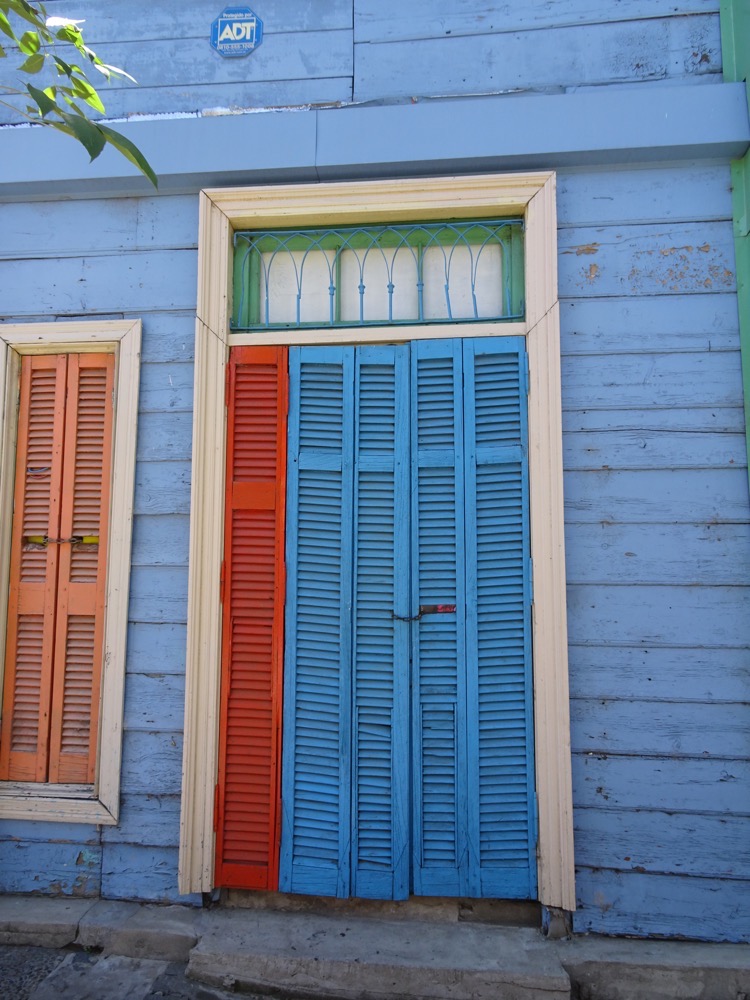
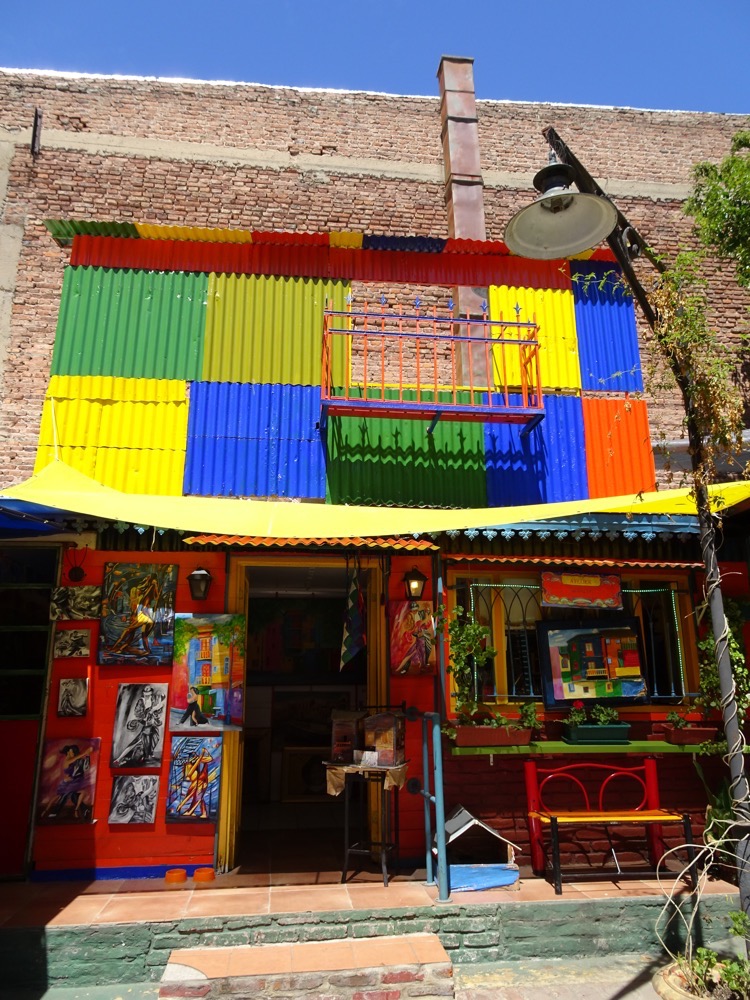
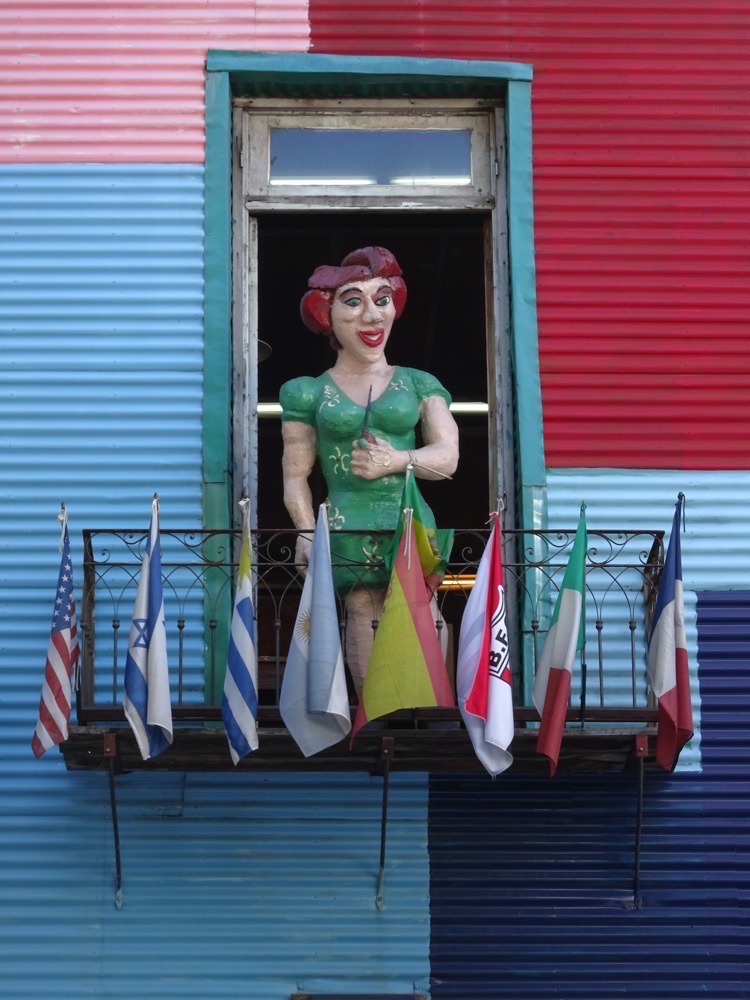 The buildings here are old timber and corrugated iron construction, but they have been brightly painted by the bohemian community that lives in the area. Other than these few very colourful streets that are decidedly touristic, the wider area is quite poor and unfortunately known to be a high crime area. It’s a very funky little barrio though and well worth checking out – with lots of markets, cafes, souvenir stores, people dancing the tango at midday, and a cool buzz about the place.
The buildings here are old timber and corrugated iron construction, but they have been brightly painted by the bohemian community that lives in the area. Other than these few very colourful streets that are decidedly touristic, the wider area is quite poor and unfortunately known to be a high crime area. It’s a very funky little barrio though and well worth checking out – with lots of markets, cafes, souvenir stores, people dancing the tango at midday, and a cool buzz about the place.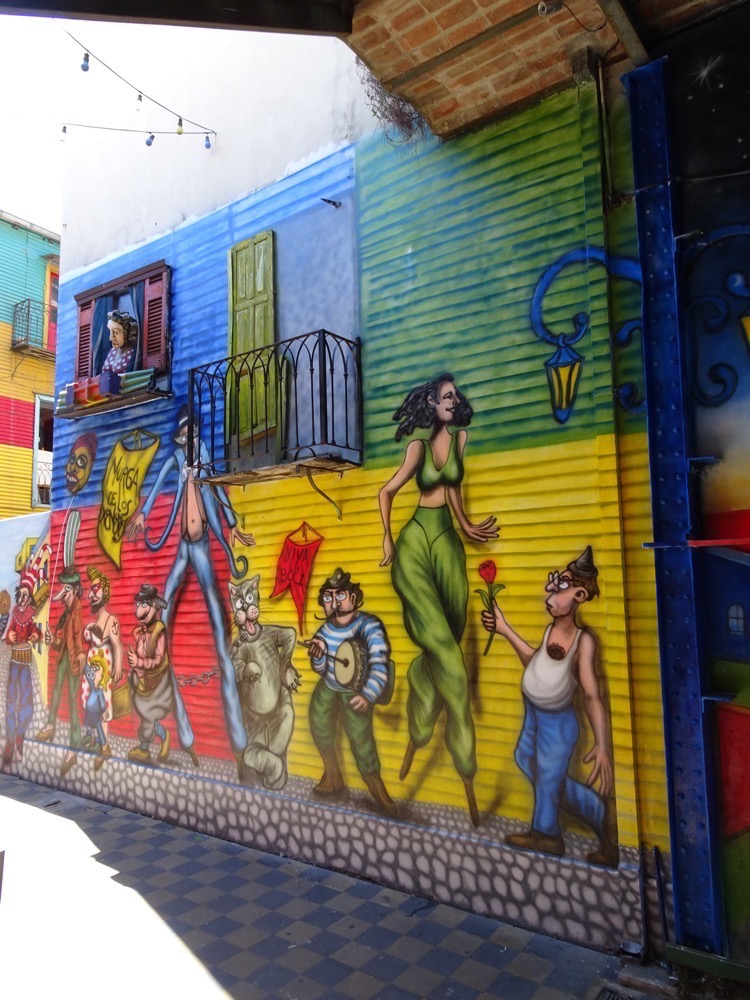
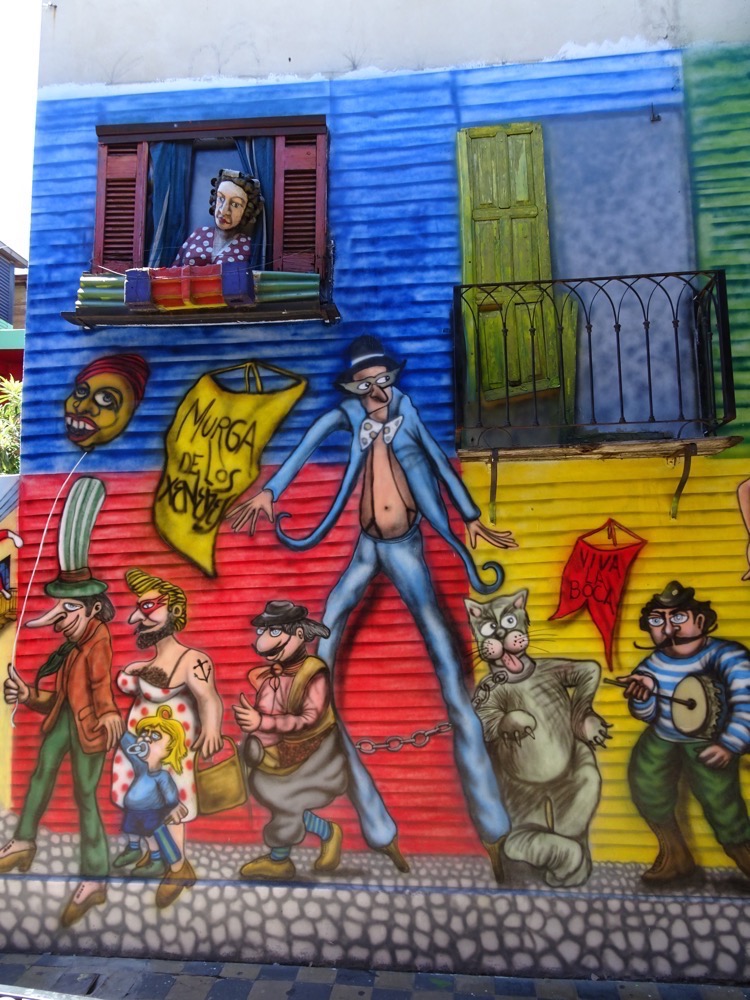
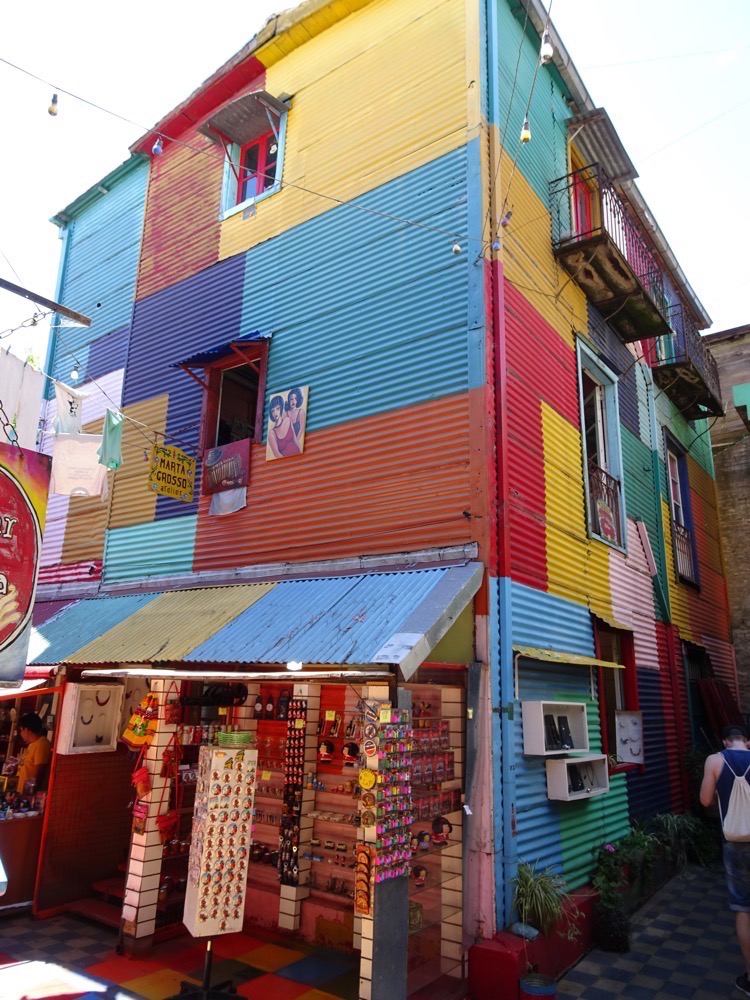
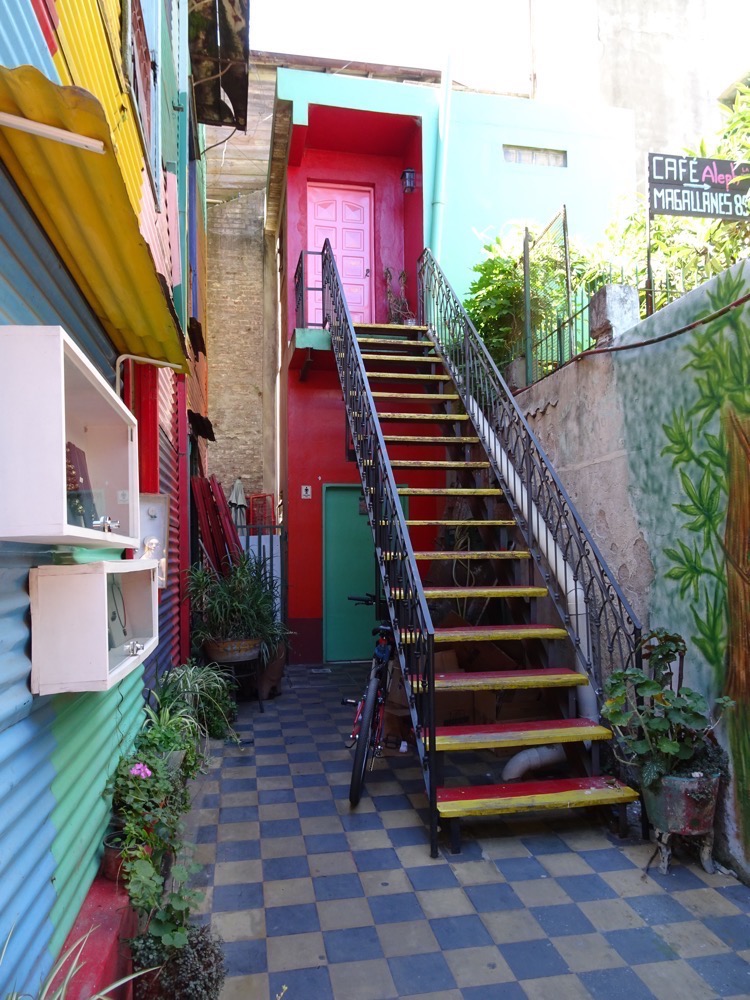 Everything that stands still appears to have been painted in bright colours creating a very festive and cheerful atmosphere. The markets are full of bright and interesting souvenirs as well, with lots of artwork and plenty of toruisty stuff.
Everything that stands still appears to have been painted in bright colours creating a very festive and cheerful atmosphere. The markets are full of bright and interesting souvenirs as well, with lots of artwork and plenty of toruisty stuff.